







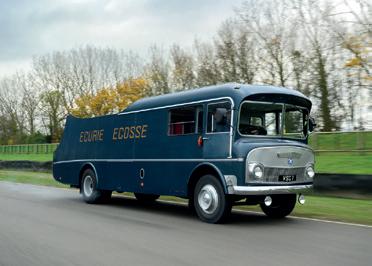










FOR MORE THAN A DECADE, the Fiskens stand at Retromobile has proudly showcased and sold some of the most significant collector cars of all time. Our 2025 stand celebrated the finest examples across both road and race cars, with many of the consignments offered from long-term ownership and publicly available for the first time. As we conclude another strong year of both on and off-market sales, we are now inviting consignments for our renowned Paris motor show stand. To have a confidential discussion regarding the sale of your classic automobile, please get in touch using the details below.


For many years Harris’s famous morning reviver was served over the counter as a remedy, post-revelry, for the roisterous and bibulous of London’s St James’s. With its tinctures of gentian, cinnamon, clove and ammonia, it was the head-clearing jolt needed to start the process all over again. Now, revived as a cocktail bitters, this new version of The Original Pick-Me-Up is no less effective, but a touch more palatable.





Centro Stile at 20, Eagle Lightweight GTR, Art of Bespoke, Tamiya legacy, IHMA news, Italdesign road trip, Generations Trophy and more

NÜRBURGRING: THE GREEN HELL
Buckle up for our breakneck drive through history, 100 years after work on the iconic circuit first began
BAILLON FERRARI TAKES A BOW
Intriguing barn-find 1961 Ferrari 250 GT California Spyder with a Hollywood past is in the spotlight once more
HISPANO-SUIZA POWER COUPLE
His ’n’ hers twins styled by ‘Dutch’ Darrin for Anthony and Yvonne de Rothschild will remain together forever


WACKY RACERS OF GRAHAM HILL
From single-seaters and sports-prototypes to fast saloons and motorised bathtubs, the motor sport legend drove it all
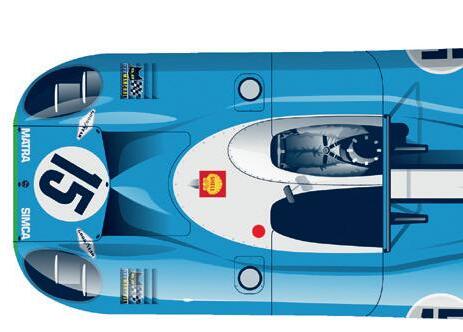

GIUGIARO’S 1988 AZTEC SHOW CAR
Sci-fi vision of the future was built to honour 20 years of Italdesign. It has never lost its space-age impact
SPADA: THE MAN, THE LEGEND
Father of the DB4 GT Zagato and Giulietta TZ was a beautiful, complex man who mainly let his designs do the talking

50 HOMOLOGATION SPECIALS
Creating a quota of road cars to legitimise a racing machine is a game of skill vs chance, as our Top 50 shows

ACQUIRE
Buying a Porsche 914, collecting video games, automotive art by Joel Clark, Patek Philippe 3940 watches, products, book reviews and more
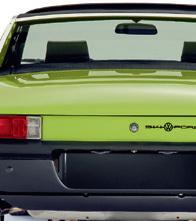
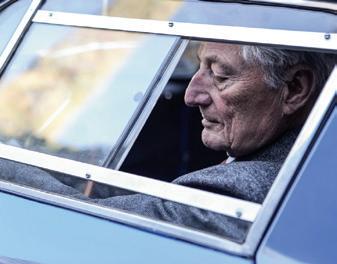













Estimate: $35,000 - $45,000



Many years ago, the late racer/writer Tony Dron gave me a copy of his ‘how to drive the Nürburgring Nordschleife’ notes. I studied them hard, and a few years later I was lucky enough to drive the Ring – at which point I forgot most of what I’d read and re-read so many times, and crawled around doing my best not to get in the way of the GT3s and M3s.
I’m willing to accept that I’m unlikely to race at the Ring now – and that I won’t be bothering the big boys on the Touristenfahrten days. But I still love the place for its history and atmosphere, and also for the surroundings; it’s often forgotten what a beautiful area the Nürburgring sits in.
That’s why we chose aerial shots to illustrate our feature celebrating 100 years since the first foundation stones were laid there. If you’ve never been, then go – even if it’s just to sit on the grass bank at Brünnchen to watch the tourist-lap antics or to sample the famous Pistenklause restaurants in Nürburg. They’re surprisingly good places to relax.
In stark contrast, we’ve had a busy few weeks in the run-up to our International Historic Motoring Awards event, but we have also found time to relaunch an old favourite: Vantage magazine. Back when MD Geoff Love and I were at Dennis Publishing with Octane magazine, we launched Vantage as an independent Aston Martin quarterly, but it was killed off after we left. It’s now back, and available on the Magneto website. If you like Astons, we think you’ll love Vantage.
David Lillywhite Editorial director

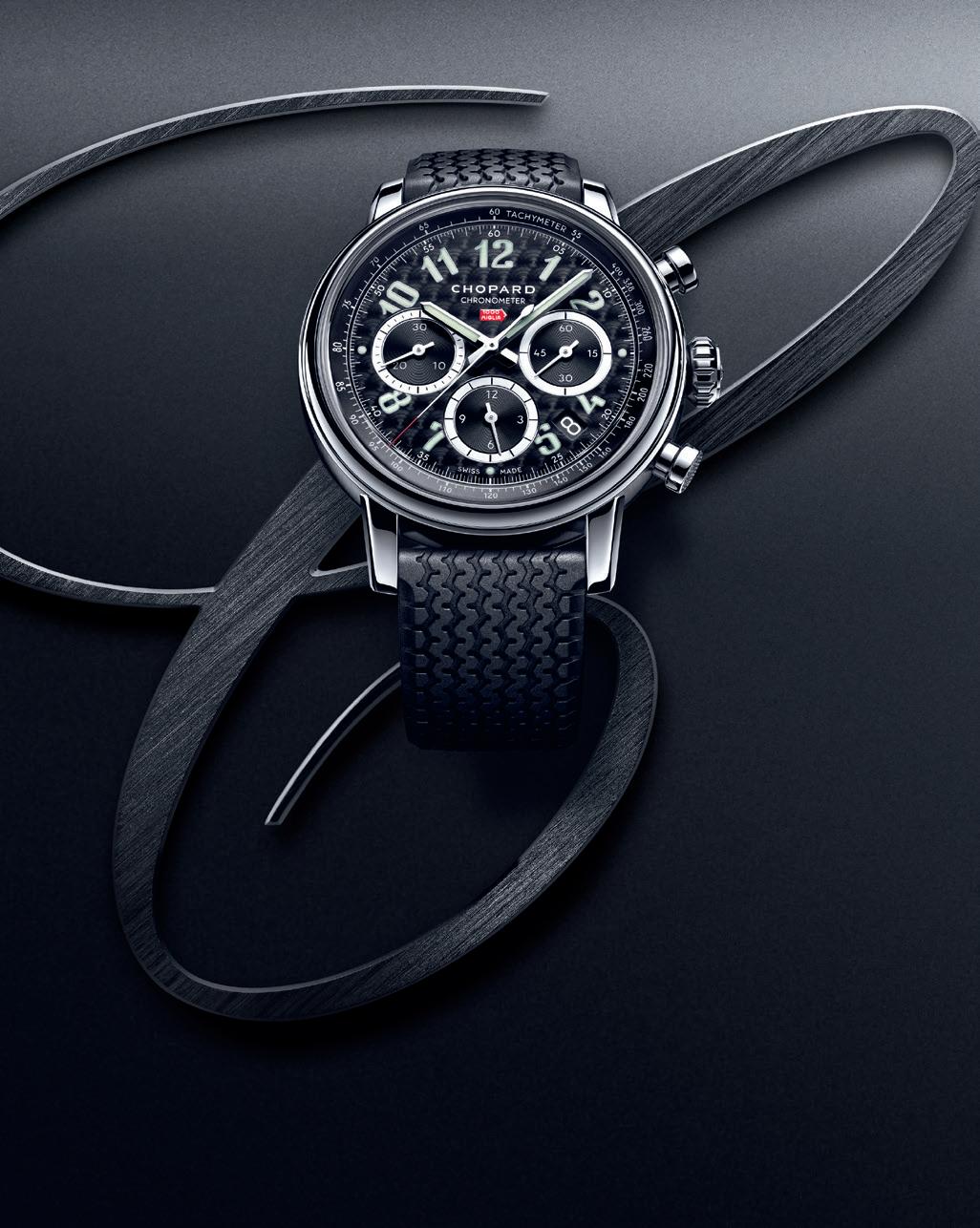
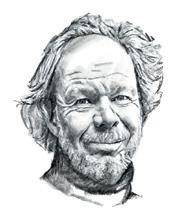
Art director, graphic designer, illustrator, part-time rally co-driver and Magneto favourite Ricardo is a perfectionist with an irresistible retro style and almost limitless creativity. Asked to create eight bird’s-eye views of Graham Hill’s most obscure race cars with little reference, he absolutely nailed it.
Belgian-based writer Bart, together with photographer wife Lies De Mol, produces and publishes automotive books with a heart and a unique style. A love for cars is one thing, but for Bart, connecting with the people behind them is the real reward – as shown in his piece on Ercole Spada.


A huge road-trip and Nürburgring enthusiast, Frank has written and published several books on these topics. During his travels, you will typically find him with two or three cameras around his neck, parked awkwardly alongside the road or racetrack, waiting impatiently for the perfect photo opportunity.
Classic and contemporary sports and racing car writer Richard has experienced everything from pre-World War One leviathans to hybrid hypercars. When we asked him to write about the 1988 Italdesign Aztec concept car, his response was: “Sure, I would love to. I’ve even driven one!”











Deputy editor
Wayne Batty
Marketing manager
Rochelle Harman
Editorial director
David Lillywhite
Creative director Peter Allen
Features writer
Elliott Hughes
Marketing and events
Hannah-Maria Ward
Managing director
Geoff Love
Managing editor
Sarah Bradley
Designer Debbie Nolan Accounts
Advertising sales Sue Farrow, Rob Schulp
Jonathan Ellis, Sarah Dilley
Lifestyle advertising
Sophie Kochan
Contributors in this issue
Advertising production Elaine Briggs
Frank Berben-Groesfjeld, Blair Bunting, Jonathon Burford, David Burgess-Wise, Nathan Chadwick, Robert Dean, Lies De Mol, Richard Dredge, Paul Fearnley, Martyn Goddard, Rob Gould, Rick Guest, Richard Heseltine, Georg Kacher, Evan Klein, Bart Lenaerts, John Mayhead, Clive Robertson, Ricardo Santos, Damien Smith, Dean Smith, Peter Stevens, Nick Trott, Joe Twyman, Matt Walford, Gary Watkins, Greg White, Rupert Whyte
Single issues and subscriptions
Please visit www.magnetomagazine.com or call +44 (0)208 068 6829
Geoff Love, David Lillywhite, George Pilkington
Unit 16, Enterprise Centre, Michael Way, Warth Park Way, Raunds, Northants NN9 6GR, UK
Printing Buxton Press, Palace Road, Buxton, Derbyshire SK17 6AE, UK.
Printed on Amadeus Silk and Galerie Fine Silk supplied by Denmaur as a Carbon Balanced product. Made from Chain of Custody certified and traceable pulp sources

Who to contact
Subscriptions rochelle@hothousemedia.co.uk
Events hannahmaria@hothousemedia.co.uk
Business geoff@hothousemedia.co.uk
Accounts accounts@hothousemedia.co.uk
Editorial david@hothousemedia.co.uk
Advertising sue@flyingspace.co.uk or rob@flyingspace.co.uk
Lifestyle advertising sophie.kochan2010@gmail.com
Advertising production adproduction@hothousemedia.co.uk
Specialist newsstand distribution Pineapple Media, Select Publisher Services
In 2015, we watched the Baillon 250 GT California Spyder – once owned by French star Alain Delon, later left to rust at a French chateau – sell for a record €16.4m. Last month we photographed it, now perfectly restored, at the equally immaculate Kiklo Spaces. We’re lucky enough to see a lot of special cars, but this beautiful Ferrari sent shivers down all of our spines.

Ercole Spada, who died earlier this year, was a surprisingly quiet, humble man. Getting to know him wasn’t easy, but when writer Bart Lenaerts and photographer wife Lies De Mol inadvertently gatecrashed Spada’s 71st birthday party in 2008, they made a friend for life. In this issue, Bart explains how the relationship with the designer developed over the years.
© Hothouse Media. Magneto and associated logos are registered trademarks of Hothouse Media. All rights reserved. All material in this magazine, whether in whole or in part, may not be reproduced, transmitted or distributed in any form without the written permission of Hothouse Media. Hothouse Media uses a layered privacy notice giving you brief details about how we would like to use your personal information. For full details, please visit www.magnetomagazine.com/privacy.
ISSN Number 2631-9489. Magneto is published quarterly by Hothouse Publishing Ltd. Registered office: Castle Cottage, 25 High Street, Titchmarsh, Northants NN14 3DF, UK.
Great care has been taken throughout the magazine to be accurate, but the publisher cannot accept any responsibility for any errors or omissions that might occur. The editors and publishers of this magazine give no warranties, guarantees or assurances, and make no representations regarding any goods or services advertised in this edition.





















































































Do you remember Vantage, the independent Aston Martin magazine? Magneto founders Geoff Love and David Lillywhite co-founded it years ago, but it was killed off when they left Dennis Publishing. Now it’s back, put together once again by Peter Tomalin and Dickie Meaden – and it’s as good as ever. Order it at www.magnetomagazine.com/store
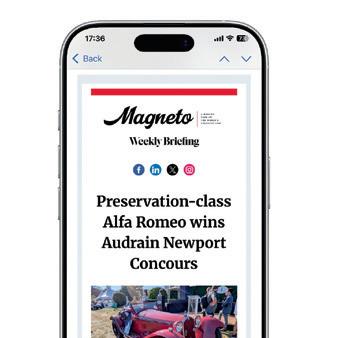
Magneto’s Weekly Briefing is a curated regular package of the news, features, event reports and previews that matter most to classic and collector car audiences. Our fortnightly Market Briefing newsletter previews upcoming events and adds expert analysis of auction results and prevailing market trends. Sign up at www.magnetomagazine.com

The Magneto website reflects our love for the very best, the rarest and the most special production, prototype, competition and concept cars of every age. For all the news,
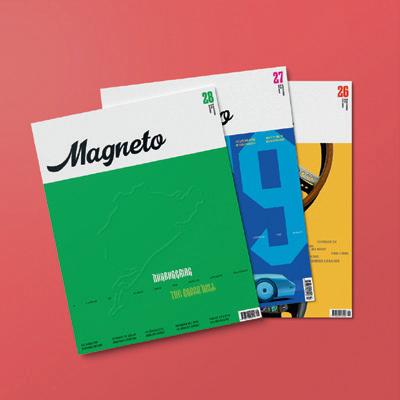
You can subscribe for one year for £54 including p&p (€62 or $68, plus postage), or two years for £94 including p&p (€108 or $120, plus postage). Magneto is delivered worldwide in strong cardboard packaging. Please visit www.magnetomagazine.com or call +44 (0)208 068 6829.


Offered for sale
1926 Rally Grand Sport ‘S‘
Painstakingly restored over seven years, this sole surviving Grand Sport S is a masterpiece in preservation.
Unrepeatable opportunity.
£90,000

www.tomhardman.com ask@tomhardman.com
+44(0)1200 538866



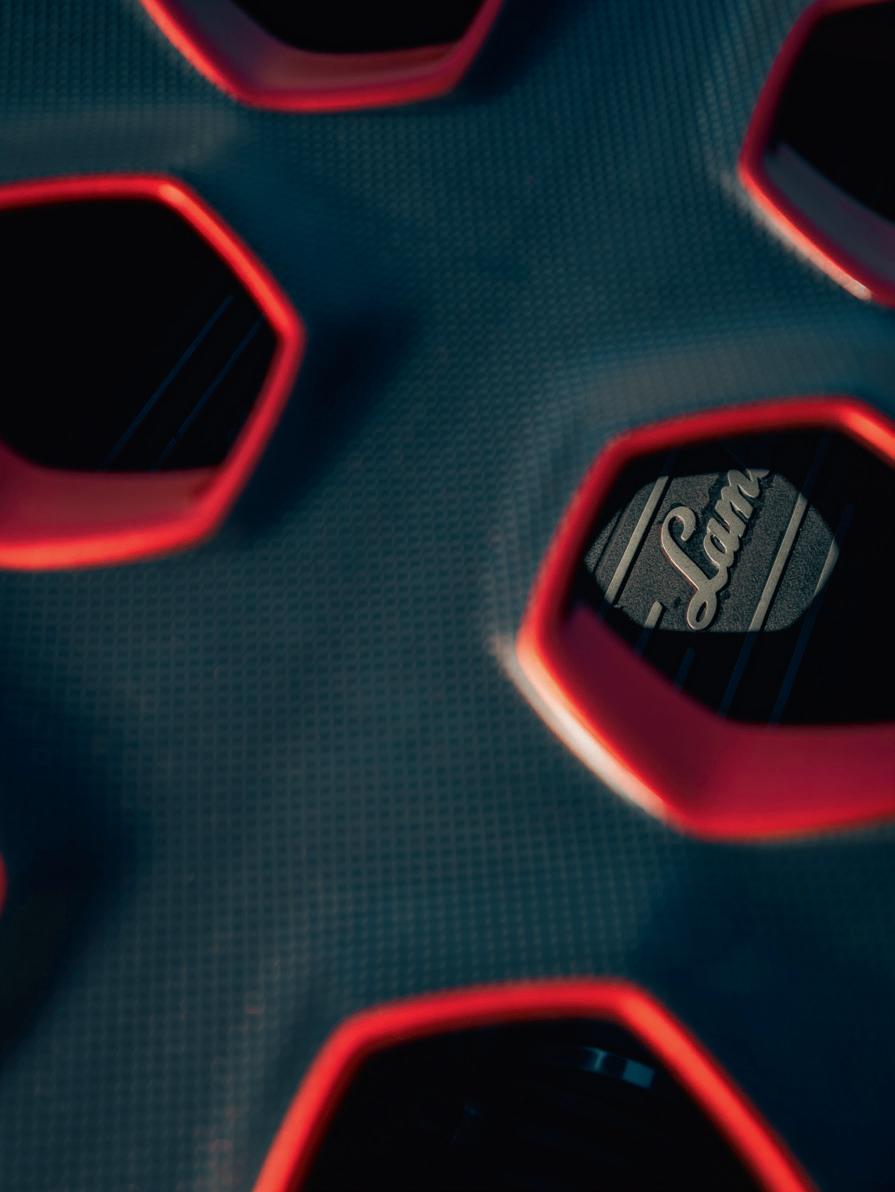

At a party celebrating two decades of style autonomy, Automobili Lamborghini revealed a new design. Bang on brand, the Manifesto was something ‘unexpected’

THIS SPREAD Design director Mitja Borkert’s tape skills are as sharp as the cars emerging from Centro Stile.
FEW WOULD ARGUE THAT THE core tenets of Automobili Lamborghini are performance engineering and design. While the cars have always incorporated exhilarating technical and mechanical specification, it’s their external designs that have really set pulses racing. Chairman and CEO Stephan Winkelmann readily acknowledges that “design is fundamental to all that we do”. From its genesis back in 1963, the Italian super-sports car manufacturer has consistently delivered models that are among the most visually arresting on the planet. This is principally, but not exclusively, epitomised by the astonishing and enduring impact of the 1971 Countach LP500 concept.
While all the early Lamborghinis were shaped by external styling studios (mostly Stile Bertone), models such as the 1981 Jalpa and 1986 LM
002 were designed by Lamborghini’s then technical director Giulio Alfieri. Under Chrysler ownership, Marcello Gandini’s P132 Countach replacement proposal morphed into the polished but still menacing Diablo courtesy of a thorough rework by Chrysler Styling Center’s Tom Gale.
Beneath the bravado, though, those years were difficult for the car maker. Volkswagen Group’s purchase of Lamborghini, and the supercar company’s subsequent positioning as an Audi Group subsidiary in 1998, brought the kind of stability and technical resource that authentic creativity thrives on. Joining from Audi, the uber-talented Luc Donckerwolke was charged with taking Lamborghini beyond the Diablo. He absolutely nailed that brief, creating the beguiling Murciélago in 2002, followed in 2004 by the V10-engined Gallardo

THIS PAGE It’s a Lamborghini tradition to deliver the ‘unexpected’. The Manifesto was certainly that – but outside, Centro Stile surprised all by displaying its never-before-seen Countach concept.

that then outsold all Lamborghini’s previous models combined.
It was incoming Audi Group design chief Walter de Silva who, in one of his first meetings with Group head Martin Winterkorn, pushed for the creation of an in-house design division at Lamborghini. In the early 2000s, the go-ahead was given to convert one of the company’s old car-storage areas into a new design studio, becoming fully operational as the Lamborghini Centro Stile in 2005. From that milestone moment on, every design decision would be made internally, thus ensuring full ownership of the brand’s creative voice and its future legacy.
After two prolific decades of extraordinary product creation, first under Donckerwolke and then in the care of Filippo Perini, incumbent design boss Mitja Borkert championed the idea of a 20th anniversary celebration of the Centro Stile. He had an enthusiastic buy-in from chairman and CEO Stephan Winkelmann.
Current and former Lamborghini designers, industry friends and a handful of media were invited to the event. On the agenda was an intriguing, mostly ‘unscripted’ Q&A session with de Silva and Borkert; an eye-popping display of the facility’s extraordinary concept cars, special editions and few-offs; and a wildly desirable sculptural statement of future intent, aptly named the
Lamborghini Manifesto.
Walter de Silva may sound a little frail these days, but an entertaining panel discussion inside the Centro Stile presentation area proved he’s lost none of his design fire. A few off-piste comments about the wider industry kept Lamborghini head of communications Tim Bravo on his toes. While discussing aspects of design, de Silva said European brands had “become followers of the copiers”, and put the blame firmly on weak leadership for the sad state of some heritage-rich (Italian) brands. Back on subject, he revealed that he’d admired Borkert’s “energy” at Porsche.
He recalled that in a meeting one night after the 2015 Frankfurt Motor Show, he’d simply said: “I want you for Lamborghini.” Ten years on, de Silva, voice cracking with pride, told the audience: “In Mitja, I found the right person.” Then, before anyone got too comfortable, he added that while much has changed at Centro Stile over the years – the design team has mushroomed from seven in Perini’s time to 25 now – “the next step is more. It is not enough”. To be 74 years old and yet still be encouraging those around you to push boundaries is remarkable.
Winkelmann himself said he expects Centro Stile to be “always pushing boundaries to deliver the unexpected that is so innate within the Lamborghini marque”.
For his part, Mitja Borkert appears


Fifty years
Despite advocating for cutting-edge tech, Borkert is still a sketch fanatic.
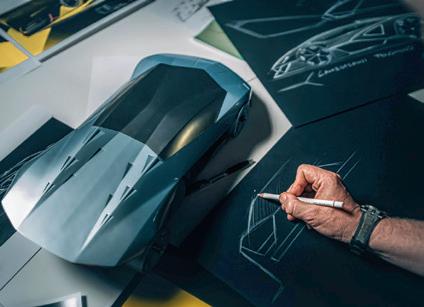
tailor-made for the role. “We must be open to embracing the developments of the next 20 years,” he said. “We are looking at AI, of course. I am the oldest one in the design centre, but I was the initial driver of this [exploration into AI]. Now the whole team understands its importance as a tool. The principles of Lamborghini Centro Stile mean we must always be curious, questioning the status quo.”
Arriving from Porsche in 2016, mere months after the unveiling of Stuttgart’s Mission E concept car, his first task was to finish the series Urus before its imminent design freeze. As the new design director, however, he also felt the need to deliver something crazy and unexpected – “to show all the enthusiasts that I understood the brand and was in no way going to do a Porsche out of Lamborghini”. Developed in 2017 with MIT, the extraordinary Terzo Millennio ‘third millennium’ electric concept car conclusively proved Mitja’s innate understanding of the brand’s traditional ability to deliver the shock of the new. The Terzo Millennio was never designed to be a real car – it was just too extreme. However, details such as the Y-shaped front DRLs, the hexagon in the body side and the rear shoulderpanel shape have over the past eight years inspired similar elements in the Revuelto, Temerario and Essenza SCV12 track car. Other Borkert highlights include the Sián, Countach LPI 800-4, Lanzador concept and the recently revealed Fenomeno. This celebratory event offered a chance to inspect absolutely all of these machines, and so many more.
The facility’s internal approach
road to the reception and the museum areas was littered with Centro Stile treasures. The line-up – one that is not likely to be seen all together on Tarmac ever again – included Donckerwolke’s two aforementioned marvels and his under-appreciated 2006 Miura concept; pinnacle examples of Perini’s production Aventador and Huracán and few-off models, the Reventón, Sesto Elemento, Centenario and Veneno, along with his much-admired 2008 Estoque, 2012 Urus and 2014 Asterion concepts.
A never-before-seen Countach concept developed by Borkert’s team prior to 2021’s LPI 800-4 was a genuine Easter egg. It drew universal praise from the attending motoring writers, which was certainly not the case when the limited-production car was first revealed. Mitja’s insight into the concept’s crucial airflow woes –serious lift and insufficient cooling issues – went a long way to explaining why so much was lost in the translation to showroom-ready machine.
Drinks and cocktail party small talk were in abundance on the ground floor of the company’s relatively intimate museum area, which was decorated with the 2013 Egoista, Terzo Millennio and 2019 Vision Gran Turismo concepts. Upstairs, the main surprise awaited. Alongside styling models of the 1971 Countach and the brand-new Fenomeno, and still cloaked in a black fabric shield, stood the next step in the evolution of Lamborghini’s design DNA.
In anticipation of a formal interview with Mitja the following day, I had planned to quiz him on design purity, cleaner surface treatments and the reduction of visual clutter. Acknowledging that Lamborghini sets trends, not follows them, surely he’d still noted that some of the most impactful concept cars of the year had trumpeted a return to a clinically pure – in some cases brutalist – design aesthetic. I’d also hoped to ask how much scope could possibly be left to develop the Countach theme, given that Borkert’s own wonderful design evolution sketches reveal how the simple purity of the 1971 concept has been taken to almost chaotic extremes. As the black cloth was whipped away, a startling wheeled

‘Guided by the Manifesto, it feels as if Centro Stile’s design engine is only just beginning to fire’
sculpture rendered in neon chartreuse was revealed. In an instant, I knew I’d need a new set of questions.
Centro Stile’s breathtaking new Manifesto represents an unadorned return to the shocking purity of the LP500 concept. Crucially, though, there’s not one square millimetre – or one pixel – that could be termed a retro pastiche. Placed near each other in the cold light of the following day, the LP500 still had the shock factor of a UFO, and yet the Manifesto’s exaggerated sculptural volumes were even more dramatic.
After we had found a quiet corner, Borkert told me the search for a new purism goes back several years to a project he oversaw involving an intern and another designer. They sought
something the opposite of the Terzo Millennio: “So, not full of elements, but a removal of elements.” The Manifesto sculpture was born from that idea. “It’s a shape that Stephan Winkelmann also likes a lot – but that doesn’t mean everything from now on will have always clean and always puristic shapes.”
So, while the Manifesto is a declaration of intent, it is definitively not the final design of the next car – it will not, and realistically cannot, be produced in this form.
“Cars with large-capacity V12s require huge cooling inlets for radiators, which means this kind of purism is not possible at the moment with these engines,” said Borkert. The car was instead created to guide the language of the brand in the years ahead. Just as the Terzo Millennio did before, the Manifesto is a new reference point for future Lamborghini models.
“When I joined Lamborghini, looking at the Miura and the Countach, I already understood that purism is part of the design legacy here. Everyone perceives the Countach as an ultra-extreme car, but the first LP500... there’s no wing, there are only puristic shapes. So, I understood
immediately that this is the starting point for our design DNA.”
For Lamborghini, the Gandini/ Bertone Countach is an enduring gift. It is the marque’s design language distilled to its very essence, an unmistakable guiding profile. Detail elements, the hexagon and the Y-motif – taken from the intersection of nested hexagons (the honeycomb) –were added decades later, inspired by the 1967 Marzal concept, but it’s the dramatic profile of the Countach that remains the starting point for every new Lamborghini.
Alongside the previous evening’s anniversary cake, Lamborghini had set up a large blackboard canvas for all to leave their thoughts and sketches. It was telling that at least four designer depictions of the Miura appeared, proving the car’s popularity among the Centro Stile crew. If Lamborghini design DNA starts with the 1971 Countach, what role does the Miura, seen by many as one of the most beautiful cars ever, actually play?
“The Miura is a standalone design – one of several standalone Lamborghinis,” replied Borkert. “Take the Espada for example; it was born from the Marzal. For me, they’re always important for all the hexagons and because of the general shape. It’s a wonderful design, but it’s also a standalone design, and as we always state: we look into the future.”
In this regard, Borkert said that the basic structure of Centro Stile is advanced design, production design, feasibility design – not operating as three separate silos, but rather “more like a garage band” jamming away together. In addition, he has also established what he calls a “crazy corner: a small group within Centro Stile tasked with imagining Lamborghini 20 years from now”.
Taken from the official release: “Twenty years after its foundation, Centro Stile Lamborghini is more than a design studio. It is a laboratory of imagination.” Easy to disregard that as mere marketing puffery, but judging by what has already emerged, listening to Borkert say that “Lamborghini is still like a start-up” and guided by the mesmerising Manifesto, it feels as if Centro Stile’s design engine is only just beginning to fire.
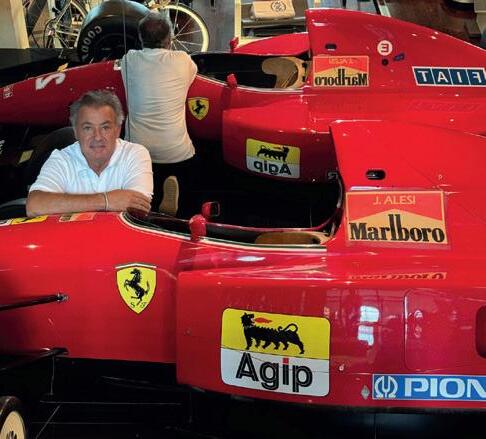
Even Eagle E-types’ own engineers didn’t think its alloy-bodied Lightweight GT could lose this much weight and remain civilised
SPECIAL-BODIED E-TYPES DON’T come along often from Eagle – but when they do, we sit up and take notice. We’ve driven them all over the years, and this car is the very latest.
A bit of background for you: irrepressible E-type obsessive Henry Pearman started Eagle in 1984 and created his first upgraded restoration in 1991. Eagle now restores four E-types a year to bespoke specification. These cars are fully re-engineered and upgraded for much-improved driving, comfort and performance, but they retain the original bodystyle and the six-cylinder XK engine.
In 2008, one customer asked for something extra special, though; this ended up as the alloy-bodied, opentopped Speedster, on which no single panel was the same as an original. That was followed by the equally bespoke Low Drag GT, the Spyder GT and then – in 2019 – the Lightweight GT. That last one is, as the name suggests, Eagle’s road-going take on the 12 race Lightweight E-types Jaguar built for racing in 1963 and ’64.
The Works cars were all Roadsters fitted with a hard-top, roof and boot vents plus centre-lock wheels; Eagle’s Lightweight GT has the same styling cues but the rear bodywork is curvier, the front and rear screens more steeply raked, the hard-top better integrated and lower profiled, the pegdrive wheels larger and wider, and the running gear seriously upgraded.
The first Lightweight GT, which we drove for Magneto issue 7 in 2020, weighed 1017kg (2242lb) – around 30 percent lighter than a standard E-type Roadster. The thinking at the time was that Eagle’s neat air-conditioning fitment would have had to be sacrificed to get the Lightweight GT under 1000kg (2204lb). We loved it.
However… one customer then challenged Eagle to build a Lightweight GT with a little more of a race feel,
although it still had to be usable on the road. It also had to have air-con, triple Weber carbs, the D-type wideangle, big-valve cylinder head, racetype cut-out switches and an exposed alloy fuel cap... and it absolutely had to come in at under 1000kg.
Challenge accepted! Eagle set about reducing the weight, from an already premium spec that included optional magnesium rear hub carriers, sump, bellhousing, gearbox and diff casings, plus tubular rear wishbones, Inconel manifolds, titanium exhausts, hollow driveshafts and a lithium battery.
To those were added specially developed titanium wheel hubs and carbon-ceramic brakes, lightened versions of Eagle’s magnesium rims, alloy seat shells, honeycomb material in place of plywood for the boot floor and almost countless titanium and drilled or cut-down components.
The result? An incredible 930kg (2050lb) dry or 975kg (2150lb) with fluids. And does it make a difference?
Well, over a stock E-type the newcomer is light and dark. It’s much, much quicker, it steers, rides and stops in a different league, its fivespeed ’box makes for far better cruising and it sounds like... heaven. A rather noisy heaven, admittedly.
Compared to that first Lightweight GT we drove, Eagle MD Paul Brace says it’s discernibly more compliant and responsive – but without driving them back to back I can’t comment on that. It will rev higher, though, due to using titanium connecting rods in the bored and stroked 4.7-litre 400bhp engine; with the lighter weight, this makes the model feel even more potent. For these reasons, this car, the third Lightweight GT built, has now gained an ‘R’ to its name and a significant premium on top of the usual £950,000 price. It would be difficult to imagine a more exhilarating E-type on the road. More details at www.eaglegb.com.



‘It would be difficult to imagine a more exhilarating E-type than the GTR on the road’





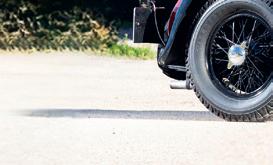



















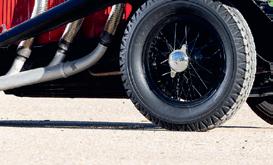













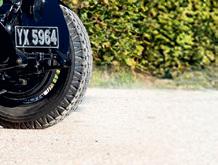
















As we look forward to 2026, let’s reflect on 50 years ago when a raft of ‘cars of the future’ promised radically different takes on things to come. But how did they pan out?
The dream

In the wake of the fuel crisis and under pressure from European and Japanese small-car imports, General Motors tried to reverse its reputation for thirst as well as create a vision of future domination and patriotic pride. By this time market share had slumped to 42 percent, a post-war low.
The utopia
The dystopia
The reality
Buying one
Marshalling the smallcar know-how of the GM empire via Opel and GM Brazil, the T-Car project was brought to shores the parent company never intended. Rear-wheel drive and a solid back axle weren’t novel, but a single overhead camshaft and progressiverate rear springs were.
This car was glacially slow, while Ford’s Fiesta and Volkswagen’s Golf exposed how US development had dulled the Opel/Vauxhall
A radical vision that would transport plutocrats in futuristic style while also generating enormous profit margins to dig Aston out of its latest financial mess.
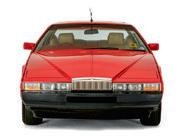

The 5.3-litre V8 had plenty of oomph and the interior was luxurious in a way only a Rolls-Royce could challenge. William Towns’ controversial wedge styling was widely criticised, but it worked – Aston received a flood of deposits.
That was the easy bit – but integrating the electrics swallowed the entire development budget, and even then Aston Martin still needed NASA’s help to get them working. Often even this wasn’t enough.

Although 2.8 million were sold, the Chevette gained a stigma – if you failed in life, it would be the car you drove.
For just $4000 you’ve got one of the most fascinating folk tales in Detroit history – and a sure-fire entry to the Concours d’Lemons.
Rover had arguably created the junior sports saloon with the P6, tapping into the young managerial class. The SD1 was a sharper-suited, futuristic successor aimed at those same customers, now in upper management.
David Bache’s aesthetics may have been inspired by the Ferrari 365 GTB/4 and GTB/C, but the general vibe came via the funky Citroën CX of 1974. Why couldn’t the Brits do modernism, too?
A bold vision of what luxury could be, wrapped in Pininfarina couture. Aldo Brovarone’s coupé was a sexy take on the wedge motif, but Leonardo Fioravanti’s ‘saloon’ was arguably more radical – a big luxury hatch shape, even more so than the SD1 and CX.
The Gamma was also front-wheel drive, which was still relatively novel in the luxury-car segment. Its engine eschewed six-cylinder and V8 class convention in favour of a longitudinally mounted flat-four powerplant.


Let’s play 1970s British car bingo. Cost-cutting, shortcuts in development, shoddy materials and poor assembly... even the press cars were abysmal.
More than 600 Lagondas were built over 14 years, often with hugely expensive bespoke interiors and, sometimes, taste-challenging exterior treatments. A useful profit centre for Aston Martin, as intended.
The ultimate curate’s egg – one UK fan has around 30 – an excellent Lagonda costs £68k-£77k reckons Hagerty.
And yet... just look at it. It still looks like a vision of otherness. Most survivors today have been dutifully cared for. Get a good one and it’s a revelation to drive.
The engine had a fatal flaw – apply too much load on the power-steering pump and the timing belt could skip or snap. Cue a toasted motor. And then there was the body rust...
Hagerty says an early V8 SD1 costs £7500, a later Vitesse more like £14,000. The rare Twin Plenum homologation special is more.
You’ll never tire of gazing at the coupé’s concave bootlid, while the interior is a deeply comfortable place to waft

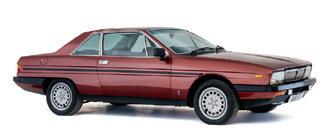
suggests £5600 for the Gamma saloon and £11,000 for the coupé.
THUR 29 JAN I LIVE AUCTION
PARIS EXPO
PORTE DE VERSAILLES
OFFICIAL AUCTION HOUSE OF RÉTROMOBILE
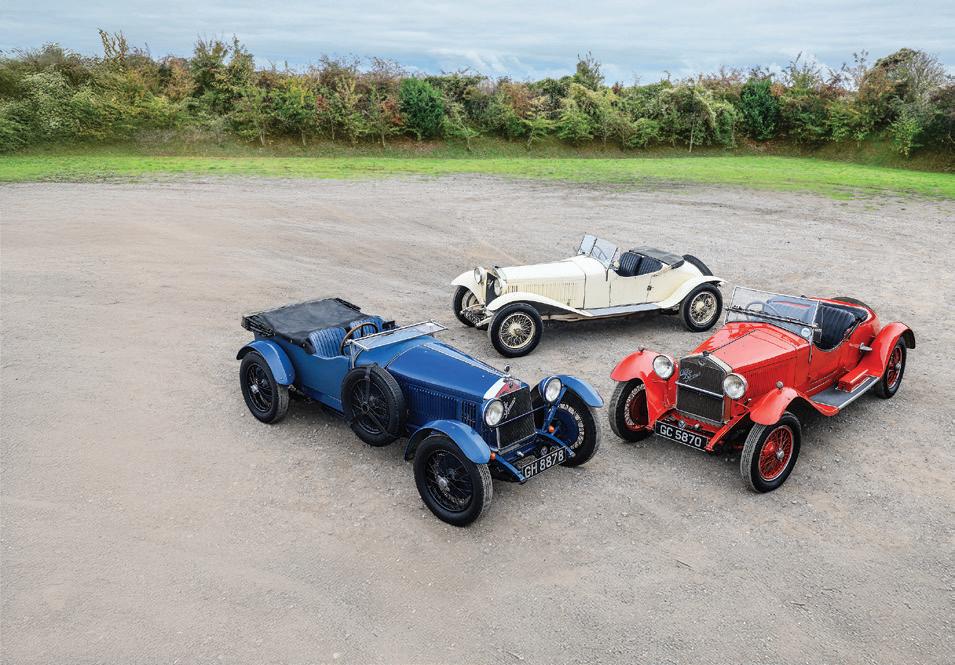
Featuring Selections from THE CHERRETT COLLECTION Offered Entirely Without Reserve
1928 ALFA ROMEO 6C 1500 MILLE MIGLIA SPECIALE
Coachwork in the style of Zagato I Chassis 0211409
1928 ALFA ROMEO 6C 1500 SPORT ZAGATO
Coachwork by Zagato I Chassis 0211501
1929 ALFA ROMEO 6C 1750 SS LE MANS
Coachwork in the style of Zagato I Chassis 0312917
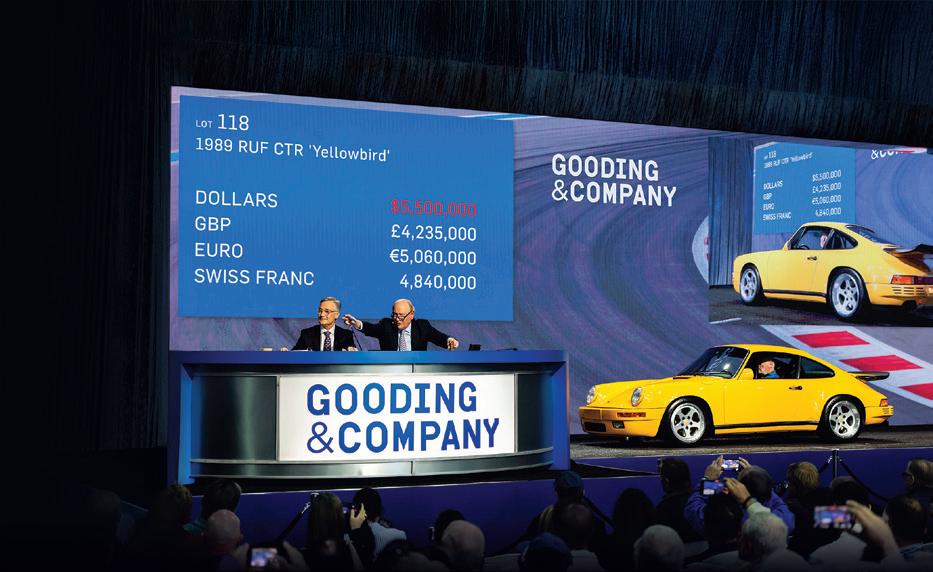
MARCH 5 – 6 LIVE AUCTIONS
1989 RUF CTR ‘YELLOWBIRD’ SOLD for $6,055,000 Amelia Island Auctions 2025
Photography Ricardo Wiesinger

Meet Professor Friedhelm Loh, German billionaire, car enthusiast extraordinaire and founder of the country’s remarkable Nationales Automuseum The Loh Collection

WHILE WE WOULD AGREE THAT switch-cabinet construction doesn’t sound like rocket science – more of a ‘Tom, Dick and Harry’ job – Friedhelm Loh turned his father’s business into a licence to print money.
The high-voltage electrician not only did a better job than any rival, he also offered his products at lower prices. Going from strength to strength, he built a multi-brand empire that currently employs more than 12,000 people and made Loh one of the richest men in Germany. His personal fortune was recently pegged by Forbes at a whopping $13.9 billion.
But when I first met the master of the house, the person at the other side of the office table was not your generic aloof and standoffish captain of industry. Quite the contrary: the 79-year-old self-made entrepreneur turned out to be a jovial and totally unpretentious, down-to-earth car guy with an open face, attentive eyes and
THIS SPREAD Friedhelm Loh’s passion for cars spans from motor sport legends to classic icons and hightech concepts.
a grid of deep laugh lines. It was only two years ago that he made his phenomenal collection public by opening the Nationales Automuseum in the village of Dietzhölztal halfway between Frankfurt and Cologne.
The 160-plus exhibits on display (only ten of them are on loan) in a majestic converted historic steel mill may be the owner’s pride and joy, but as with so many high-end collectors, Herr Loh rarely takes one of his valuable classics out for a spin.
As he recalls: “The very first Bugatti Veyron, an early prototype, taught me a lesson. We drove it to Holland for a long weekend and had a blast, but a few days later the local papers ran pictures of ‘the multi-millionaire who is spending big on toy cars’. Although a senior shop steward congratulated me on my purchase, this kind of PR can easily backfire.
“Be that as it may, I still occasionally potter up and down the high street in
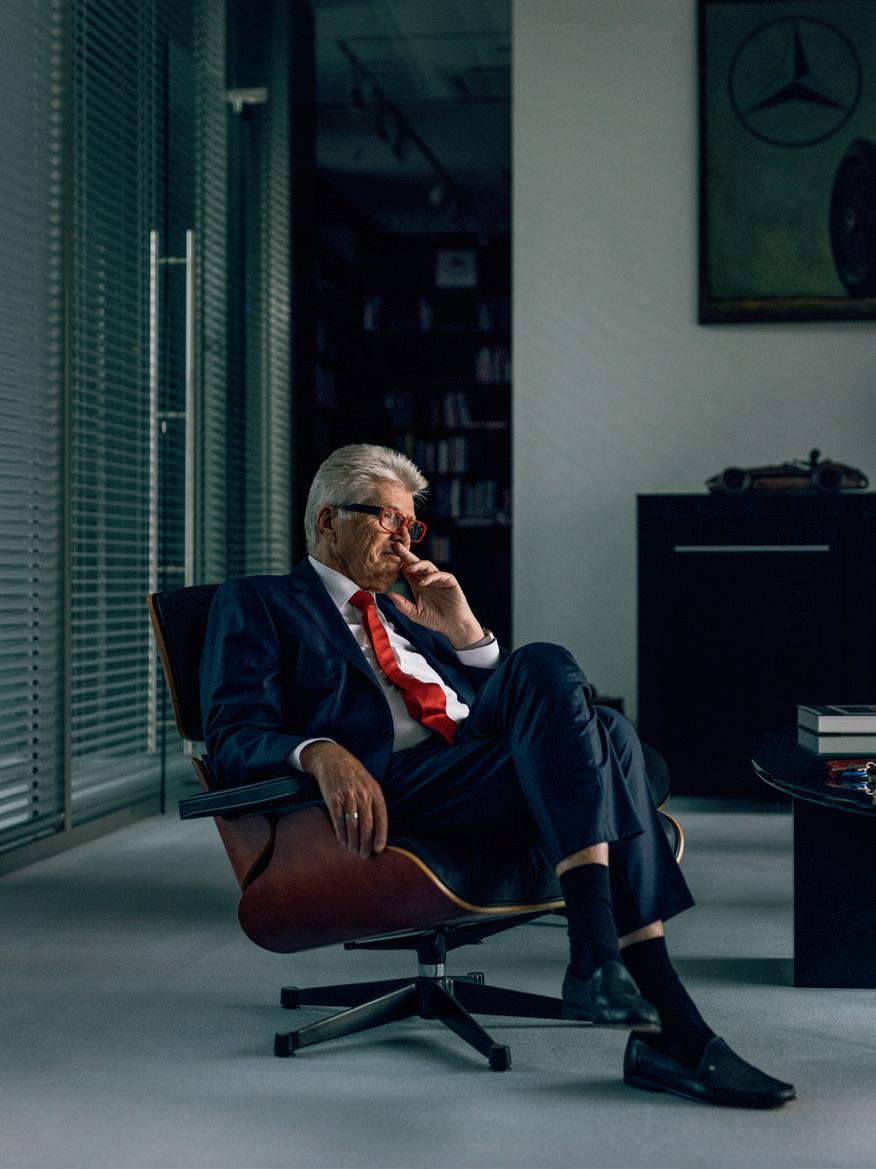
a Bentley 8 Litre or Mercedes SSK, both of which are permanently registered. My favourite daily drivers are a modern Maybach saloon and the G63 AMG in winter. I am not overly happy with the new SL, though –and I told [Mercedes-Benz CEO] Ola Källenius so when he last paid us a visit in his dual role as classic car enthusiast and senior fleet salesman.”
Loh has been a Merc man since his childhood days when a family friend pulled up in a chauffeur-driven silver 190 SL with a blue top and trim. Sure enough, the young boy was instantly hooked – first to this particular model, then to the brand. It was only logical that in the mid-1980s a white W 121 marked the foundation of what is now one of the world’s most significant classic collections. A blue-over-silver specimen was acquired at a later stage.
For many years, the patron would exclusively focus on vehicles wearing the Three-Pointed Star, but on a whim he fell in love with Bugatti, and after that the walls came down: “I now know that technology is what fascinates me most. Design is important, and so is craftsmanship, but to me the number one priority is engineering excellence that forms the backbone of innovation. The museum can, for instance, bridge the gap from one of the very first hybrids – the Lohner-Porsche Mixte – to the relatively recent, fully electric Mercedes SLS eDrive.
“We can also tell the full story of the head-up display, starting with the very first fully mechanical version pioneered by Ford for its 1956 Thunderbird. Or how about reeling back through time from the latest Mercedes-AMG One to the 1895 Benz Victoria that had only two owners:
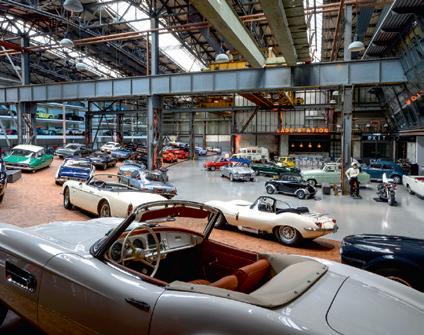
the Benz family and Henry Ford.”
The Loh Collection is a well oiled commercial enterprise that employs 80 people, including a trained mechanic and four retired classic car specialists. A satellite of the Nürtingen-Geislingen University, it also offers training programmes for young people, who can graduate as Masters of Engineering and Certified Experts for Car Design and Historic Cars, aka appraisers. The vast building complex houses a period cinema, a US-style diner and a bunch of high-tech simulators.
“But this is only the beginning,” quips Friedhelm. “We’re in the process of setting up a hotel, and by 2035 the aim is to significantly increase the
‘Although I rarely buy on impulse, my top-secret wish-list is by no means complete’

exhibition space from today’s 7500m2 footprint, a move that will hopefully at least double the number of visitors from 100,000 to 200,000 per year. There are more cars in storage to fill the new open spaces, and although I rarely buy on impulse, my top-secret wish-list is of course by no means complete.” Big smile, change of subject.
As with most collectors, Professor Loh rarely talks money and likes to play his cards close to his chest. Is it true that he refused to buy a Bugatti Royale even though the price had dropped twice by several million Euros, simply because the selling party wasn’t playing straight? No comment.
“All I can say is that there is no fixed strategy, no firm game plan, no routine execution,” he says. “Sometimes I use an agent or a personal contact I trust, sometimes we buy at auction, sometimes cars change hands quietly among collectors. Occasionally I unearth myself what I’m looking for in the classifieds or online. Mercedes, Porsche, Ferrari and Bugatti are the marques I find particularly appealing, but I also love older American cars, post-war English brands and anything Italian that is pretty, clever and rare.
“Would I spend €50m or €60m on a Ferrari GTO? That’s a lot of money compared to a very good SSK that can be had for €12m-€17m, not to mention relative steals such as the BMW 507 or the evergreen 300 SL. But the times are changing, and the focus has long shifted from pre-war behemoths to relatively modern classics including super- and hypercars. Our exhibition mix should reflect this trend and put a stronger emphasis on state-of-theart, high-tech machinery.”
It is important to Friedhelm L that the core collection and the special
exhibition that is in place for only one year contain enough ‘lollies’: surefire head-turners and crowd magnets that keep the museum going and the cash register ringing. The number one smartphone target? Wrong. The most popular vehicle on display is the littleknown Maybach Exelero concept that never even made it into production.
Also high up on the list is anything painted rosso corsa, championshipwinning race cars including the iconic Porsche 956 and ultra-rare time capsules such as the unrestored Talbot-Lago T26. For political reasons, vehicles that are in any way related to World War Two are denied floor space.
“Although it is nice to have a hall full of red Ferraris, it is just as important to display a set of cars that have a story to tell,” reckons the architect behind this €1 billion (conservative guesstimate) motor museum. “Check out, for example, our Lincoln Continental – the last car President Kennedy rode in before his assassination. Or zoom in on Schumi’s Formula 1 Ferrari that won eight races out of 11, or examine absolute rarities such as the Bucciali, a front-wheel-drive, V12-engined art deco saloon of which only six were built – and only one exactly like ours.”
Off-roading used to be master Loh’s favourite pastime. In the 1980s, he competed in professional 4x4 rallying in Iceland, Russia and through the Sahara, and he still treasures his trick vintage G-Class that looks like a prop out of Jurassic (Car) Park. The man also has a soft spot for convertibles, which he claims to be more ‘emotional’ and better investments than their metal-top siblings.
If he was to start all over again in 2025 as a young car collector, what would his relatively affordable first cornerstone purchases be? He says: “I would probably invest in limitededition high-performance Porsches, in low-volume two-door AMG models and in Italian classics built when brands such as Alfa Romeo, Lancia and Maserati were at the height of their game. There are countless cool cars out there, but when a marque ceases to exist, its products tend to eventually become less collectable.
“At the end of the day, it’s all in the mix, so we need to make sure our programme is strong enough to bring people back for an even better, bigger and bolder encore.”

Vanwall driver’s valiant 1958 German GP win is all too often overshadowed by tragic circumstances
THE 1958 GERMAN GRAND PRIX at the Nürburgring was something of an all-British affair at the head of the pack. After qualifying, the front row of the grid was locked out by Brits, with Mike Hawthorn’s Ferrari 246 on pole closely followed by Tony Brooks’ Vanwall VW5.
Their team-mates Stirling Moss and Peter Collins lined up alongside them on the 4-3-4-format grid. Indeed, all four drivers had a turn leading the GP the following day, with Moss taking an early advantage prior to a broken magneto ruining any chance of victory.
Hawthorn moved to the front, before Collins passed and set off to build a lead – and to try to clinch his second victory in as many races, having won the British GP two weeks before. Soon, however, the remaining green Vanwall was in the Ferrari driver’s mirrors, with Brooks having made up an incredible 30-second deficit due to an improvement in his car’s handling as the fuel load lightened.
He got past both rivals, but shortly afterwards Collins tragically crashed at Pflanzgarten while trying to keep up with the new leader. Hawthorn retired with a clutch failure a lap later, and Brooks went on to win by over three and a half minutes. His heroic drive is often overlooked, overshadowed by the day’s calamitous events.
This is Brooks’ winner’s wreath; it was put on display in the Vanwall workshops, and many years later it was rescued by restorer Tony Merrick when demolition loomed. Each time it is moved it risks deterioration, so here it sits, preserved in these pages in still-life photographic form, as a lasting memory from this triumphant and tragic day in Germany.



We find out what Luigi Orlandini has planned for Canossa and Cavallino in the coming year – and beyond
FOR A MAN WHO HAS JUST completed the 25th Modena Cento Ore and is now in the final stages of organising a Ferrari tour of Patagonia, with Villa La Massa Excellence taking place in between, Luigi Orlandini appears remarkably relaxed.
After all, his company, Canossa, takes its name from an Italian queen who mediated between the Holy Roman Empire and the Papacy more than 900 years ago. Getting guests from Argentina to Chile is probably only a little simpler. “We are crossing two countries, and then the Strait of Magellan by ferry. It is a major logistical challenge,” he says.
It has been yet another year of growth for Canossa, with an expanded Modena Cento Ore testing Orlandini’s 60-strong team. Next year promises
even more activity, with the 35th staging of the Cavallino Classic Palm Beach presenting new challenges, largely due to a change of venue.
“The Breakers is undergoing major renovation works that will last at least two to three years,” Luigi explains. Instead, the event will move to the 18th fairway at The Boca Raton: “It has never been used in that way before, and it will have a more Pebble Beach-style atmosphere.”
There will also be new classes for 2026. “We are introducing a class for the Daytona SP3, which is unusual for Cavallino,” he says. “You cannot award a Platinum prize to a car that is already essentially perfect, so we’ll be adopting a different judging method.”
Since acquiring Cavallino in 2020, Luigi acknowledges that some of the changes introduced by Canossa have upset traditionalists within the Ferrari community. “We sometimes receive complaints from long-time followers of Cavallino who say it was once reserved for Ferraris from the Enzo era and earlier,” he admits. “That’s true, but the world is changing, and I believe it is our responsibility to attract younger enthusiasts and help educate them. This benefits everyone,


including collectors of the older cars, because without new buyers the market cannot continue to thrive.”
He acknowledges that newer models tend to attract younger enthusiasts, but once inside, he has seen their fascination for older cars grow. To encourage this, Canossa offers free entry to those under 12, and a 50 percent discount for visitors under 25.
However, he is aware of the broader shift in interest towards post-Enzoera Ferraris. “People in their 40s and 50s, my generation included, did not grow up dreaming of a 275 or a 250, because we were not even born when those cars were built,” he says. “For us, the icons were the Testarossa, the F40 and the F50, which is why values for those models are rising. I am not sure what will happen to the older cars, but those of us in this community should strive to educate younger enthusiasts and help them appreciate the significance of these models.”
A key part of that mission is bringing the cars to the people, allowing them to see and hear the machines in motion. Luigi points to the recent Modena Cento Ore as an example: “We had an impressive line-up of five Alfa Romeo 8C 2300s from the 1930s, alongside newer entries such as a BMW M1 from the 1980s. We held a one-and-a-half-hour parade past some of Rome’s most famous landmarks before continuing to Assisi, Florence, Modena, San
THIS PAGE He’s busy with events such as Modena Cento Ore, but Orlandini has further big event plans.
Marino, Rimini and Forlì. Sharing these cars with the wider public is, I believe, equally important. Seeing them pass by attracted great interest, even from the general public.”
However, appealing to enthusiasts still lies at Canossa’s core, and facilitating what must be a dream for most Tifosi is the big development for 2026. The Cavallino Classic Monaco in April will see Ferrari Formula 1 cars not only displayed at the principality’s yacht club but also taking to the streets during the Monaco Historique. “It is a unique opportunity, and we have had an excellent response from collectors,” Luigi confirms.
Looking further afield, he sees growing interest in Asia, particularly in Japan. “I have visited many times – it is such a beautiful country with warm, welcoming people who also have great affection for Italy,” he says.
In the meantime, Canossa continues to run smaller events and bespoke tours for select groups of travellers through its Atelier programme. But does Luigi have a favourite event? “They are like children: you cannot have a favourite,” he laughs. Find out more at www.canossa.com.
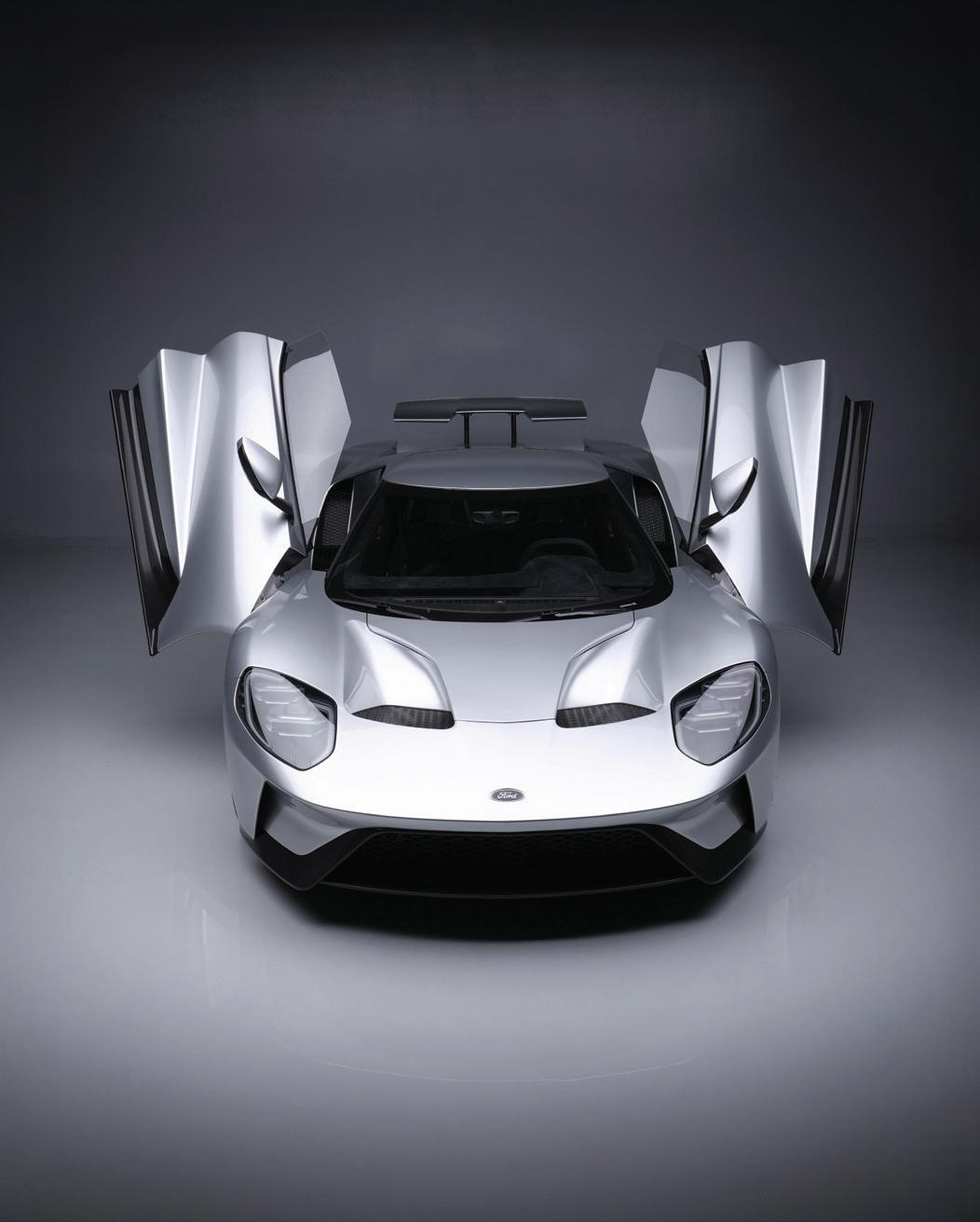

Scaglione-designed 3500GT one-off –the 1959 Turin Auto Show car – earns special Magneto award at The Quail
DURING EVERY MONTEREY CAR
Week, we award our Magneto Art of Bespoke trophy at The Quail, A Motorsports Gathering, to the car we judge to be the best one-off or lowvolume example at the event.
At the 2025 running of The Quail, Magneto’s editorial director David Lillywhite presented the trophy on stage to Jim Utaski for his stunning one-off 1959 Maserati 3500GT – the 1959 Turin Auto Show car, and the last model to be designed by Franco Scaglione during his time at Bertone.

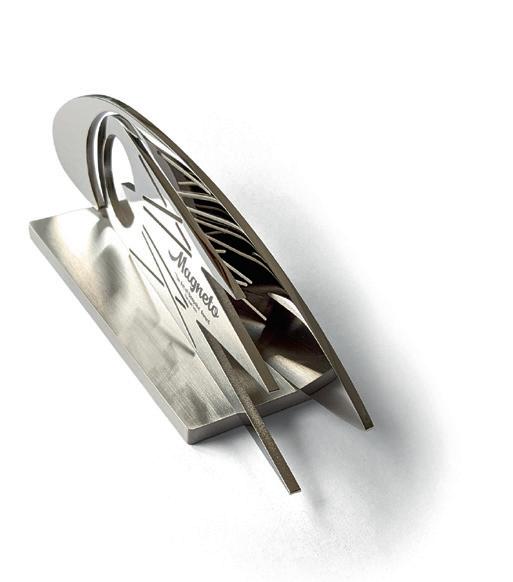
THIS PAGE The Maserati 3500GT was recognised with a special trophy at The Quail 2025.

period photos as well as Bertone and Maserati company archives.
Bertone had exhibited the 3500GT at the 1959 Turin Auto Show, with four pieces of matching custom luggage in the rear instead of seats. Swiss Maserati dealer Martinelli & Sonvico bought the car direct from the show stand for one of its best customers, Josef Willi, requesting a number of modifications including wire wheels fitted with three-eared spinners, Fiamm horns and Koni rear dampers. The luggage was also replaced by traditional rear seats, and the front chairs were substituted, too.
Later in its life, from around 1969, the car was left in an open shed and allowed to deteriorate. It was rescued in 1978 by Francis G Mandarano, the founder of the Maserati Club International, missing its engine and in need of full restoration. However, it
seems that Mandarano hadn’t realised that it was the Turin show car, and his subsequent work on it paid little attention to historical accuracy.
Years later, the Maserati was bought by current owner Utaski, who made the decision to have it restored back to its original Turin show specification, complete with custom set of luggage. Incredibly, Jim managed to find an engine that was the next off the production line after the car’s missing original; after a 5000-hour restoration with Epifani Restorations of Berkeley, California, the 3500GT was shown at Pebble Beach in 2023 – and, of course, it caught our eye again at The Quail, A Motorsports Gathering.
It was there that we met with Jim Utaski to give him the Magneto Art of Bespoke trophy, designed and created by UK artist Jonny Ambrose. See www.jonnyambrose.com for details.


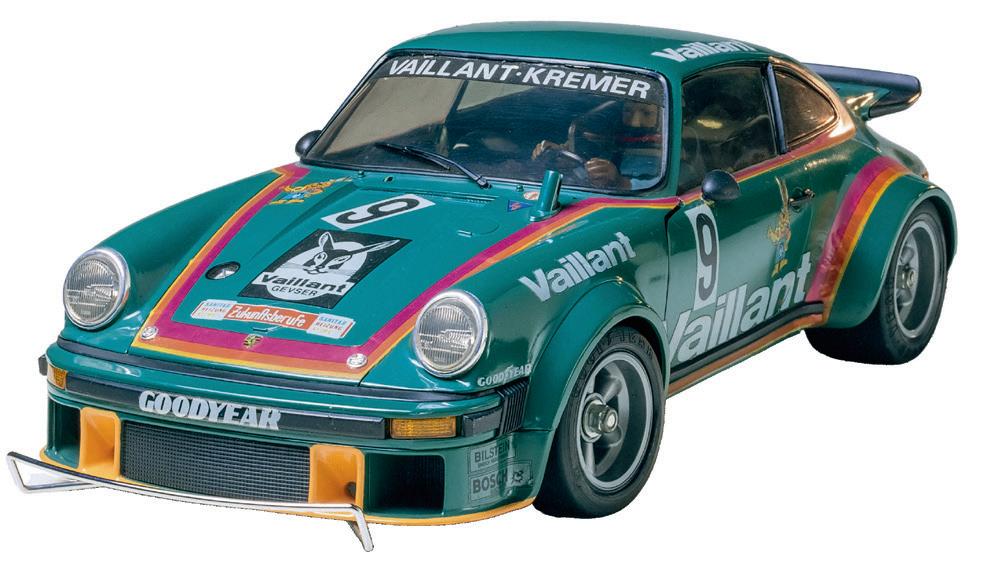
Tamiya, Inc chairman
Shunsaku Tamiya and his brother Masao both passed away in 2025. We celebrate their legacy
AS WITH SO MANY OF MY generation, my first car wasn’t one I could sit in. It was a radio-controlled Tamiya – a hand-me-down Martini Renault Formula 2 car from a cousin. It didn’t work. I didn’t have, and couldn’t afford, the controller, the servos or the receiver. But none of that mattered. I was still mesmerised by this joyous thing. I can still feel the edges of the bodywork beneath my fingertips, and conjure the bitter smell of its slick rubber tyres. As with so many, I would wager, I’d place it on my bedroom floor and, with my head flat beside it, gaze at it from eye level to amplify the realism.
In the embers of post-war Shizuoka, Yoshio Tamiya eked out a living with a modest sawmill, Tamiya Shoji & Co, founded in 1946 to help rebuild a nation. That all changed in 1951, when a devastating fire wiped out the lumber stock. It might have been
the end, but instead it became a beginning: Yoshio pivoted into crafting wooden model kits.
Yoshio’s son, Shunsaku, was born in 1934 and, after finishing school in the prefecture, went on to study at Waseda University. When he returned home, in 1958, it wasn’t just to help his father, it was to begin writing the next chapter. With Waseda behind him, Shunsaku joined Tamiya Shoji & Co, bringing academic discipline to a workshop already rich with craftsmanship and passion. He would soon steer it from wood to plastic, from local kits to global dreams.
I had interviewed Formula 1 world champions, motor-racing legends, the greatest of the great – but when I finally sat opposite Shunsaku Tamiya at the Nuremberg International Toy Fair in 2009, I realised I had never been more nervous, nor more excited. Here was a man who, perhaps
OPPOSITE The 934 was Tamiya’s first RC car. With superb engineering, and presented in beautiful packaging, it was a phenomenon.


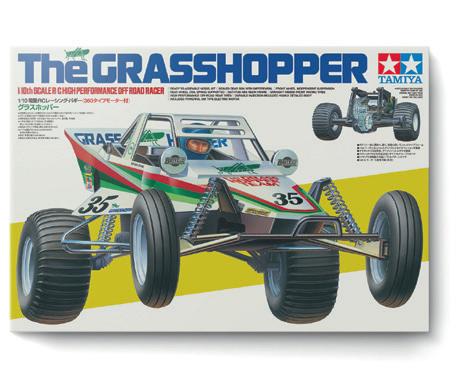
Grasshopper and Porsche 935 have been among Tamiya’s most popular models.
Boss Shunsaku’s research stretched to visiting Brabham in the UK with top model designer Honma-san (left), to see the Martini Racing BT44.
more than anyone else, had been responsible for sparking my deep fascination with the motor car. “I wanted people to build, to drive, to understand,” he told me.
The leap into radio control came thanks to Fumito Taki, a young engineer whom Shunsaku had spotted playing with radio-controlled models in the company’s car park (and legend has it, flying RC planes, too). Until then, most RC cars were petrol powered, with poor likeness to the real thing. Shunsaku had a brainwave – make them electric, and align the scale fidelity with the company’s (now famous) plastic model kits.
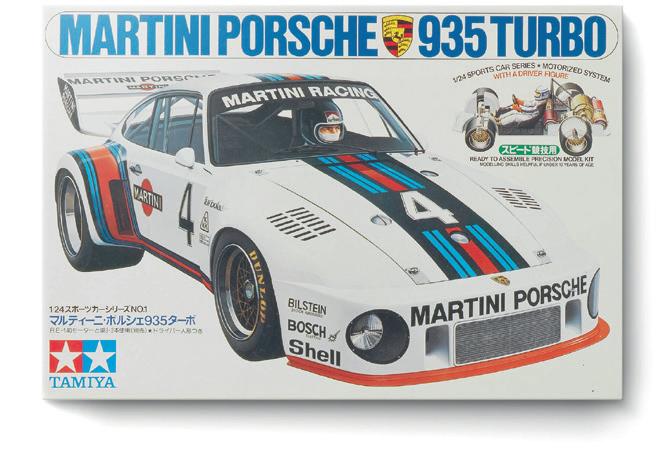
There was another imperative, too. The company had purchased and deconstructed a Porsche 934 at great cost in order to produce a 1:12th scale model, but it was not a commercial success. Shunsaku briefed ‘Dr Taki’ to reuse and recoup the mould cost and
transform the static Porsche into an electric-powered radio-controlled car.
Taki’s RC 934 was a phenomenon. It looked like a real Porsche, it had durable, accessible engineering, it combined a kit-building experience with beautiful packaging, and it was distributed globally.
The Tamiya XR311 Combat Support Vehicle and Lamborghini Cheetah followed, as off-road vehicles with detailed bodies, but they were fragile. So after witnessing the Baja Buggy races in California, Shunsaku returned to Shizuoka determined to capture that wild energy and toughness in miniature. Between Shunsaku and Taki, they delivered. Their genius lay in fusing mechanical realism with accessibility: cars that looked like the real thing, taught you how they worked, and survived the rough-and-tumble of childhood play.
That ethos – learn by doing –became the defining trait for Tamiya. Whether you were building a static kit of a Tiger tank or assembling the fragile rose joints of an Avante RC buggy, the process taught you something. You didn’t just own a Tamiya; you experienced it.
And that experience, I came to realise, is universal. I have seen it everywhere: a Le Mans engineer confessing that his fascination with aerodynamics started with a Tamiya Porsche 956; a designer at a major EV manufacturer explaining that her first lesson in packaging came from cramming a 7.2V NiCad into the tub chassis of a Grasshopper. Even Adrian Newey, the greatest race-car designer of his era, has spoken of how building Tamiya kits honed his instincts. In
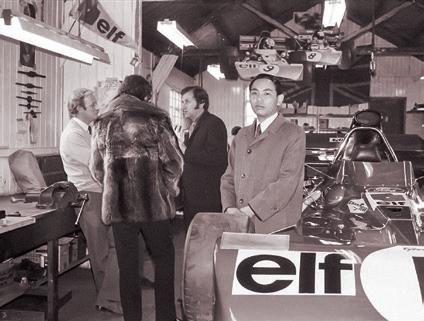

THIS PAGE A visit to Tyrrell resulted in a model of the still-popular P34, designed by Honma-san. The Lotus 49B was among the kits that inspired a young Adrian Newey to Formula 1 greatness.

the distributor still serving the UK and Ireland with what Shunsaku once called “courage and insight”. Those early kits – particularly the Lotus 72 –became runaway hits, putting Tamiya firmly on the map for a new generation of model-makers and race fans.
In an era awash with AI, simulations and hyper-realistic gaming, you might expect physical model-making to have edged into obscurity. Yet Tamiya has quietly defied that trajectory. Its kits offer tactile joy – a slow, deliberate counterpoint to instant digital gratification. Forums brim with hobbyists sharing build logs and weathering techniques – sometimes using AI to refine colour palettes or test liveries, but always grounded in handson craftsmanship. Even in the digital realm, modellers reference Tamiya as the standard: clean engineering, intuitive fit, instructions that welcome newcomers yet reward purists...

define the brand’s visual soul. Masao, who passed away in August 2025, was responsible for the striking look and feel of the packaging and promotional material, as well as for media and event strategy. He was also the creator of the iconic twin-star logo.
To open a Tamiya kit was to enter another world: the sprues perfectly laid, the instructions folded with care, the lid art so vivid you could almost hear the whine of tyres or the roar of the tank. Long before Apple perfected the theatre of packaging, Tamiya had already nailed the ritual of ‘unboxing’.
The UK was one of the first places to embrace Tamiya. In 1966, a chance pairing between a discerning British toy wholesaler and Tamiya’s plasticmodel innovations sparked something remarkable. David Binger of Richard Kohnstamm Ltd (RIKO) chased down a handful of grey-imported Tamiya kits on a US buying trip – and within the year, he’d travelled to Shizuoka to meet Shunsaku and his father. This planted the seed for Tamiya’s emergence in the UK and Europe. David’s faith in the brand did more than launch sales; it helped establish Tamiya as a household name among hobbyists. His son Pete now leads The Hobby Company in Milton Keynes,
And the business behind all of this remains quietly healthy. Tamiya is private, but its global footprint speaks to sustained demand. When Shunsaku eventually stepped back from leadership in 2024, it was not under pressure but as part of a careful succession plan. Today, under the stewardship of his grandson-in-law Nobuhiro Tamiya, the company has expanded its reach while holding fast to its core promise: kits that delight, educate and endure. When news of Shunsaku’s passing broke in summer 2025, what followed was not concern for the company’s future but a global chorus of gratitude.
I last spoke to Shunsaku a decade after we first met. He reflected on the global community his firm had created.
“It is business,” he said, “but also my personal passion. The enjoyment of assembling something by hand is different. It teaches you how things are made, and patience. It gives history.”
It is difficult to think of another brand, in any field, which has inspired such enduring affection. The reason is simple: Tamiya never talked down to its audience. Whether you were an engineer in Stuttgart or a 12-year-old in Gravesend, the kit in front of you carried the same promise of possibility.
Shunsaku Tamiya didn’t just build models. He built bridges – between generations, between cultures, between the simple joy of creation and the boundless possibilities of curiosity.






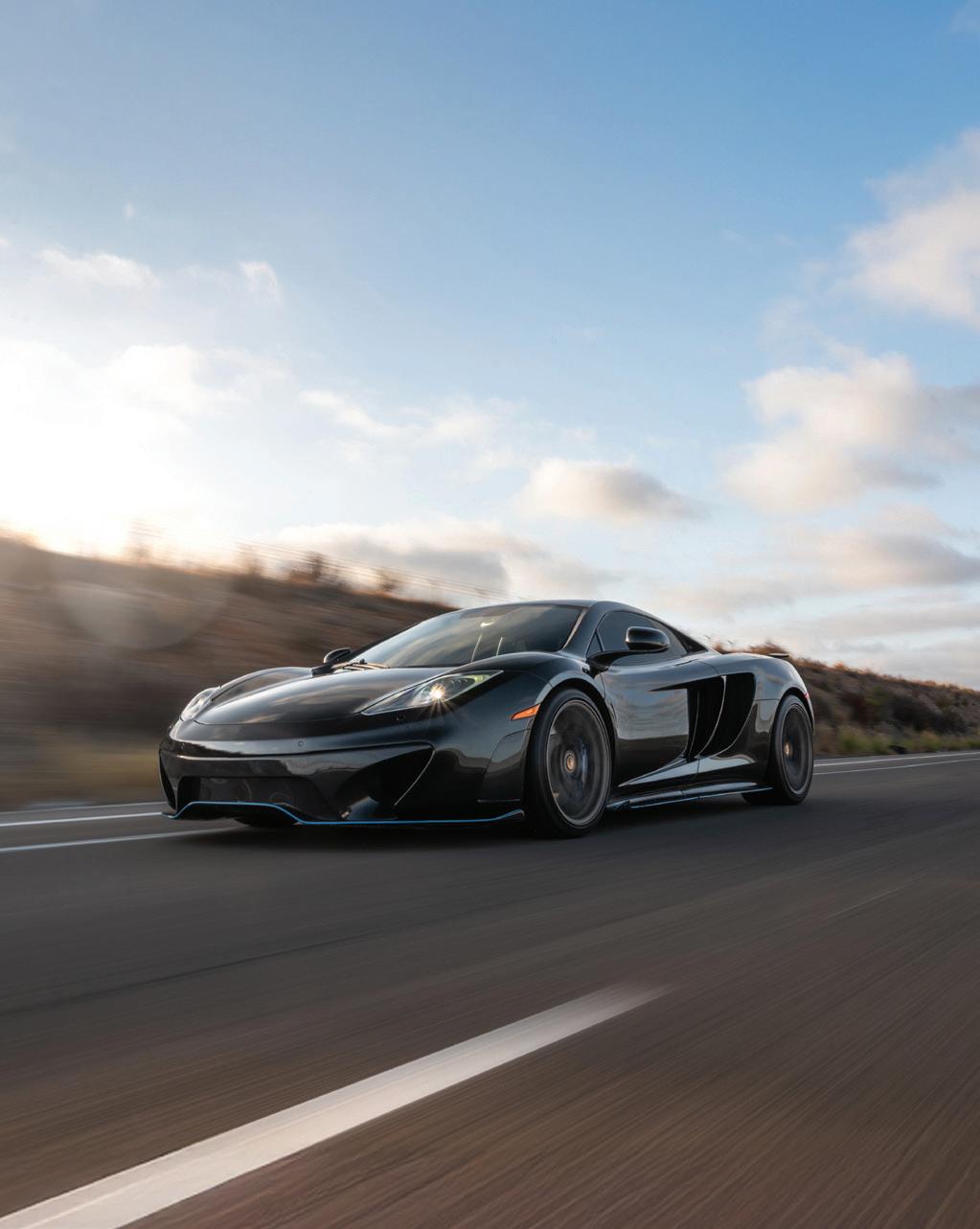
Martyn Goddard

THIS PAGE From the Ital Aztec to the Lamborghini Calà and the Touareg, and plenty more besides, the 2003 Italdesign road trip was epic.
March 2003 memories of a 200-mile drive in Italdesign prototypes to mark 35 years of the iconic Italian design house
I ARRIVED FROM LONDON AND met up with Jean Jennings, legendary editor of Automobile magazine, and her husband Tim for one of the strangest road trips of my 50-year career.
“Hey Marty, we are going to have a ball: a 200-mile road trip in a bunch of Giugiaro’s prototypes to celebrate 35 years of Italdesign.” That was the good news. The bad news was that our fellow trippers were the great and the good of the world’s motoring press.
At Italdesign’s HQ there followed a short briefing by Fabrizio Giugiaro on the firm’s design ethos, and a drivers’ meeting given by Franco Bay describing our route to Lake Como via the wine capital Barolo. He supplied no maps but did give us a sheet of directions with kilometre markers. However, since none of the 21 show cars had odometers, the drive was... interesting Once the motoring scribes had


chosen their individual rides – Ms Jennings selected the 2000 ‘Mad Max’ Touareg concept – the leading Lancia minivan swept out of the gates towards the autostrada with the wacky racers trailing in its slipstream. The photographers hitched a ride in either the show cars or the caravan of support vehicles.
The locals must have thought they were seeing things as strange-looking prototype cars passed at speed with a bunch of snappers hanging out of every window of the chasing vehicles taking tracking shots. Things settled down as we approached the first stop at Cherasco, which gave us a chance to photograph the locals eye-balling the cars and shoot atmospheric images of the concepts in a classical Italian location. Suitably refreshed, the writers swapped steeds and departed, leaving the photographers
with no time for coffee and scrambling for transport to the lunch stop.
The trip continued apace, with photo cars blasting ahead of the pack to shoot the all-important images of the convoy driving through the Italian countryside and villages. By the time we arrived at the Castillo Marchesi di Barolo, Jean had switched to a Maserati Buran and I, as with my photographer colleagues, was exhausted. The fun continued with a fine dinner in the castle and a conjuror vanishing one of the show cars in the courtyard.
On day two, the cars headed north towards Lake Como. All was going well until disaster stuck; a flat battery caused my new digital Canon 1DS to stop working. I’d only recently made the move to digital, and I couldn’t understand why. A fellow snapper asked: “Did you leave your hotel room and remove the key? That is the
problem; the power to your charger turned off when you left the room.”
I had a spare film camera in my bag but was short of 35mm, so at the first autostrada fuel stop I raided the shop for every roll of film it had. I was then ready for the lunch stop at Arona. The restaurant’s courtyard was packed with Italy’s finest. The local police officer spent his time examining the strange cars and keeping admiring local kids off them. When it was time to depart, we had a police motorcycle escort for the lakeside drive.
Arriving at Cernobbio on Lake Como’s west shore, we parked the cars up at the hotel. To my knowledge none had failed to complete the run, and all were ready for detailing for the Villa Erba show to celebrate Italdesign at 35. Assignment completed, I returned to London with fond memories of a wonderful, if unusual, Italian road trip.
































Frohe Weihnachten und ein glückliches neues Jahr
I migliori auguri per un buon Natale e un felice Anno Nuovo
Joyeux Noel ainsi qu‘une bonne et heureuse nouvelle année





Zalig Kerstfeest en een Gelukkig Nieuwjaar
Feliz Navidad y un próspero Año Nuevo

AND




The Ferrari F80 has once again seen the Prancing Horse gallop to the top of the hypercar class – but how does the new charger measure up against Maranello’s stable of ultimate machines?
Contrary to popular belief, the 288 GTO was not originally conceived to be Ferrari’s Group B competition weapon. Instead, the germ of the project originated from Enzo’s belief that the Ferrari range didn’t have a halo model – in his words, it was too “gentrified”. However, with a chief engineer of Nicola Materazzi’s calibre (he played a key role in the Lancia 037, among many other things), the possibilities of Group B use became apparent. Just 272 road cars were built, powered by a 395bhp twinturbo V8 that made the 288 GTO good for a 5.0-second 0-60mph dash and a top speed of 189mph.

The 288 GTO Evoluzione intended for Group B suddenly found itself without an arena to race in, so Materazzi convinced Enzo that the essential idea would make for a great road model. Il Commendatore agreed, and the F40 was born. Ferrari claimed it was the first road car to breach 200mph – something independent tests failed to prove, but no matter. This bare-bones car was blisteringly quick, with 471477bhp from its 2.9-litre twin-turbo V8, wrapped up in a 1254kg body; it could hit 60mph in 4.7 seconds.
Unlike the 288 GTO the F40 did compete in global endurance racing, with the Michelotto-built F40 LM. A further development for privateer drivers, the F40 Competizione, appeared with 691bhp and 228mph. There were 1311 F40s in total.

ABOVE Ferrari’s first 200mph-plus car? Debatable – but the F40 was blisteringly quick.
To celebrate its 50th birthday Ferrari decided to put that age-old trope – a racing car for the road – to the test with the F50. At the model’s heart was the Tipo F130 V12, which could trace its roots back to the 1990 641 Formula 1 car and, in evolution form, the 333 SP racer. It was teamed with a six-speed manual ’box and clothed in a love-it-or-hate-it carbonfibre body from Pininfarina’s Lorenzo Ramaciotti and Pietro Camardella. Its 4.9-litre naturally aspirated V12 made it good for a 198mph top end and 3.8-second 0-60mph dash. Looked upon dismally for many years – Ferrari not allowing auto journalists to drive it didn’t help – the F50 has since gone on to be one of the auction world’s hottest properties. It is the most expensive car here, and just 349 were built.


Ferrari sought F1 inspiration for its millennial monster, which boasted a carbonfibre body and a six-speed Graziano automated manual. It even had active aero, which the Scuderia wasn’t allowed to use in competition. The Ken Okuyama styling was, if anything, more polarising than the F50’s – although there was no denying the Enzo’s potency. Its 6.0-litre naturally aspirated V12 developed 651bhp, propelling the Enzo to 60mph in 3.1 seconds and onto a 218mph top speed. Four hundred examples were built, and F40 aside it’s the least expensive way to get into a Ferrari hypercar – you’ll need an average of £2.9m. Interestingly, the most expensive
The FXX Corse Clienti track-day model formed the basis of Ferrari’s next flagship – which had one of the most awkward car names ever. The first non-Pininfarina-styled Ferrari in more than five decades, it was also the marque’s first full hybrid, delivering 950bhp via a 789bhp naturally aspirated V12 and a 161bhp HY-KERS unit. It could do 0-62mph in 2.6 seconds, double that in barely twice the time and hit 220mph. The topless Aperta of 2016 formed the basis of the FXX-K and FXX-K Evo track-day cars; 499 LaFerraris

To celebrate its 80th birthday Ferrari has unleashed the F80. Under the car’s carbonfibre skin it has the twin-turbo V6 derived from the Le Mans-winning 499P, with three electric motors. The 3.0-litre ICE powerplant produces 888bhp; that’s 296bhp per litre with 55psi of turbo boost – the highest figures of any production car ever. That’s augmented with 296bhp
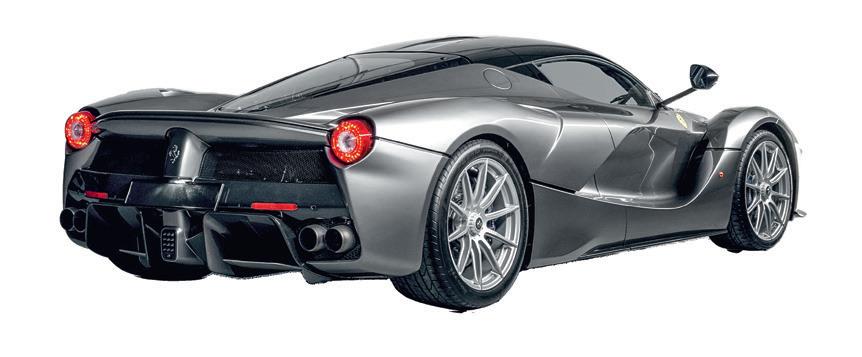

LEFT Arguably unloved at first, the F50 has since gone on to become one of the auction world’s hottest properties.
ABOVE The 950bhp LaFerrari was the marque’s first full hybrid, marking the dawn of a new era.

New Generations Trophy is the ultimate activity for Historic motor sport-loving families
HOW DO WE GET THE YOUNGER generations into Historic motor sport?
By encouraging them, of course – but that’s easier said than done. Several organisations are already doing this, including HERO-ERA with Rally For The Ages, Rally The Globe with its Generations Rally and Happy Few Racing with variants of its father-andson and father-and-daughter event. Now Motor Racing Legends (MRL) has introduced its own version.
MRL’s all-new Generations Trophy had its first outing at Silverstone in late October 2025, bringing together 20 teams. Several of the drivers were new to competitive motor sport. The concept is simple: each car is identical, and each driving team is made up of two generations of the same family. All compete in a 60minute race at the wheel of a pre-1966 FIA-specification MGB – chosen for


its accessibility, mechanical simplicity and relatively low cost – and to ensure a level playing field, each car’s power is measured on a dyno before the race.
The 20-car field included many rookie drivers, from 18-year-old Evie Russell to John Kent, who was making his racing debut at the age of 73. Richard Hammond of Top Gear and The Grand Tour fame teamed up with his daughter Izzy for their first-ever shared race, in MGB number 351.
“Izzy and I both came here to learn,” said Richard. “We just wanted to finish the race in one piece, and we did. We’re not yet ready for a ‘real’ Historic race, and the Generations Trophy seems like a great entry point for people like us. We will do more.”
Shaun Lynn, the owner of Motor Racing Legends, shared MGB number 13 with his daughter Jemima: “As a motor-racing enthusiast, I have been
indoctrinating my children for a very long time,” he said. “The many races I have done alongside my sons, Alex and Maxwell, have helped to bring us closer together. These are very special moments.
“Jemima often followed us to the circuits, but she never dared to put on a helmet. It’s actually thanks to her that I came up with the idea for a series dedicated to those who need a welcoming and safe environment to
‘The many races I’ve done alongside my sons have helped to bring us closer together’
THIS PAGE Each team is made up of two generations of the same family. Even Richard Hammond is giving it a go...
take that first step into racing.”
Evie Russell shared MGB number 67 with her grandfather, Gordon: “My granddad has been racing for 57 years. I’m used to following him as a spectator at Goodwood and elsewhere, so when MRL announced the Generations Trophy, we jumped at the chance to compete together. I was a bit nervous, but everything went really well. I had some great battles on track, and I was genuinely emotional when I handed over the wheel to my grandfather. I can’t wait to do it again next year.”
The race was won by Rick and Joseph Willmott, who beat Patrick and Aimee Watts into second place. The Generations Trophy will return at the Donington Historic Festival on the Early May Bank Holiday weekend, May 1-3, with around 30 cars expected. You can find out more information at www.motorracinglegends.com.














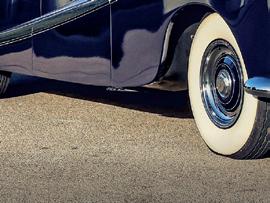
















These are the entries that made it through to final voting for the International Historic Motoring Awards
THE SHORTLIST FOR THE 2025 International Historic Motoring Awards (IHMA) presented by Lockton is a roll call of the very best events, cars and achievements of the past year.
There were a record number of entries for this year’s Awards, taking place on November 14 at The Peninsula London. After this, results will be on www.historicmotoringawards.co.uk.
Those who made it onto the shortlist advanced to the final stage of judging, from which a distinguished panel of experts and prominent figures from the motoring world determined the winners. The judges included TV stars Wayne Carini and Donald Osborne, Pebble Beach Concours d’Elegance chairman Sandra Button and Octane Japan editor Shiro Horie.
The 2025 IHMA is supported by Castrol Classic Oils, Classic Car Register, Revs Institute, the Petersen Automotive Museum and Nyetimber, and Octane and Magneto magazines.
BOOK OF THE YEAR
Spy Octane: The Vehicles of James Bond, by Matthew Field and Ajay Chowdhury (Porter Press International)
Joseph Figoni: Le Grand Couturier de la Carrosserie Automobile Vol. II-IV: Bugatti, by Peter M Larsen and Ben Erickson (Moteurs!)
Power Unleashed: Trailblazers Who Energised Engines With Supercharging and Turbocharging, by Karl Ludvigsen (Evro)
Twice Around the Clock – The Yanks at Le Mans Vol IV-V, by Tim Considine (David Bull)
The Aston Martin ‘Project’ GT Racing Cars, by Stephen Archer and David Tremayne (Palawan Press)
BREAKTHROUGH EVENT OF THE YEAR
The Royal Automobile Club Concours
Concours of Slovakia
Pearl of India Rally
CAR OF THE YEAR
Sunbeam 350hp ‘Blue Bird’
Alfa Corse Alfa Romeo 158
Hispano-Suiza H6C Nieuport-Astra Torpedo
Mercedes-Benz W196R Stromlinienwagen
Ford Escort Alan Mann 68 Edition
Alfa Romeo Tipo B (P3)
BRM P5781 ‘Old Faithful’
RESTORATION OF THE YEAR
Sponsored by Classic Car Register
Jaguar C-type by Tony Purnell / Pendine / CKL Developments
Aston Martin Two Litre Sports by RS Williams
Hispano-Suiza H6C Type Sport Torpedo by RM Auto Restoration
Ferrari 410 Superamerica by Paul Russell & Company
Hispano-Suiza H6C ‘Boulogne’ by Jonathan Wood
Ferrari 275 GTB/4 Alloy by Tom Hartley Jnr
Siata 208 CS Balbo by RX Autoworks
BESPOKE CAR OF THE YEAR
Sponsored by Octane
R33 Stradale by Automotive Artisans
Rolls-Royce Corniche ‘Henry II’ by Niels van Roij Design
Wood & Pickett Mini by CALLUM
Lightweight GTR by Eagle
Veloce12 Barchetta by Touring Superleggera
Battista Novantacinque by Pininfarina
Ford Escort Alan Mann 68 Edition
Batur Convertible ‘One-Plus-One’ by Bentley Mulliner
The Ayrburn Classic
Icons Mallorca
CLUB OF THE YEAR
Sponsored by Lockton
Aston Martin Owners Club
Vintage Sports-Car Club
MG Car Club
Porsche Club GB
INDUSTRY SUPPORTER OF THE YEAR
BMW Group Classic
Heritage Skills Academy
Historic & Classic Vehicles Alliance
Association of Heritage Engineers
Motul
Piston Foundation
Mercedes-Benz Heritage
MOTORSPORT EVENT OF THE YEAR
Sponsored by Revs Institute
Rolex Monterey Motorsports Reunion
Pittsburgh Vintage Grand Prix
Le Mans Classic
Silverstone Festival (including the World Champions Collection)
MOTORING EVENT OF THE YEAR
Sponsored by Nyetimber
The Quail, A Motorsports Gathering
The Amelia Concours
The Bridge
Salon Privé
ModaMiami
The Aurora
Audrain Newport Concours & Motor Week
Concorso d’Eleganza Villa d’Este
PERSONAL ACHIEVEMENT OF THE YEAR
Sponsored by the Petersen Automotive Museum
Guy Moerenhout
Luigi Orlandini
Tomas de Vargas Machuca
Fritz Burkard
SPECIALIST OF THE YEAR
Sponsored by Castrol Classic Oils
Tom Hartley Jnr
HK-Engineering
RM Sotheby’s
Rally Preparation Services
Aston Martin Works
Lamborghini Polo Storico
RALLY OR TOUR OF THE YEAR
Tour de Corse Historique (Modus Vivendi)
Terre di Canossa Rally (Canossa Events)
Flying Scotsman (HERO-ERA)
Rallye des Princesses (Peter Auto)
Oman Classics 2025 (HK-Engineering)
RISING STAR OF THE YEAR
Ethan Blake-Jones (Paddock Speedshop)
William Garrett (Hilton & Moss)
Alex Hearnden (96 Engineering)
Will Marsh (VSCC)
RACE SERIES OF THE YEAR
Super Sprint (Equipe Classic Racing)
Alfa Revival Cup (Canossa Events)
Endurance Racing Legends (Peter Auto)
GT & Sports Car Cup (Automobiles Historique)
IROC (IROC Holdings)
Silverline (Formula Junior Historic Racing Asso)
MUSEUM / COLLECTION OF THE YEAR
Sponsored by Magneto
Silverstone Museum
Petersen Automotive Museum
National Motor Museum (Beaulieu)
Autoworld Museum (Brussels)
Museo Alfa Romeo
Nationales Automuseum The Loh Collection
Indianapolis Motor Speedway Museum
DIGITAL MEDIA OF THE YEAR
The Late Brake Show
Richard Hammond’s Workshop
Harry’s Garage
Jay Leno’s Garage
Petersen Automotive Museum
Vintage Velocity podcast
Hagerty Media
Boxengasse

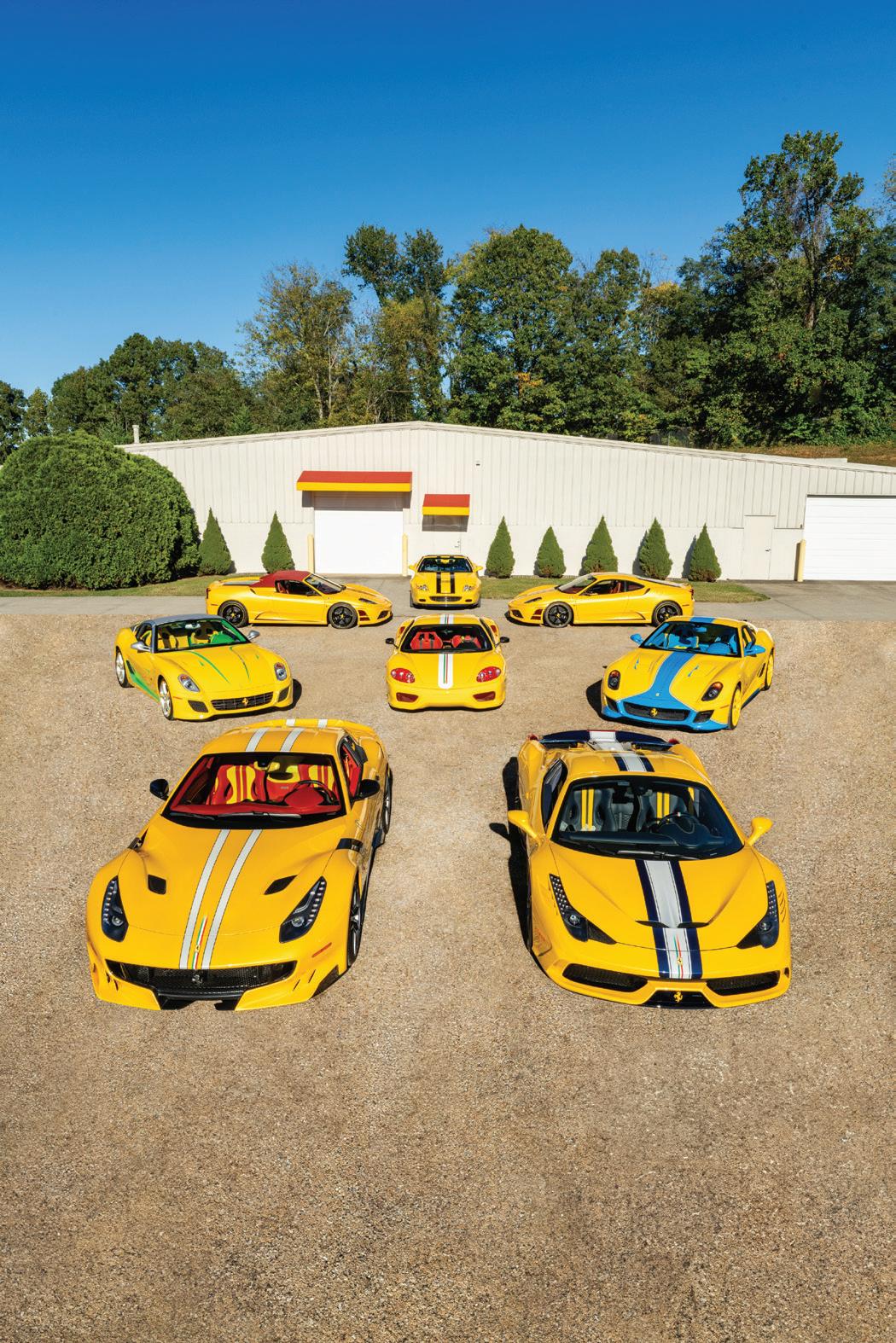
IN ASSOCIATION WITH THE PHIL AND MARTHA BACHMAN FOUNDATION & CHRISTOPHER MIELE OF PRANCING HORSE OF NASHVILLE 48 AUTOMOBILES TO BE OFFERED AT KISSIMMEE • JANUARY 6-18, 2026
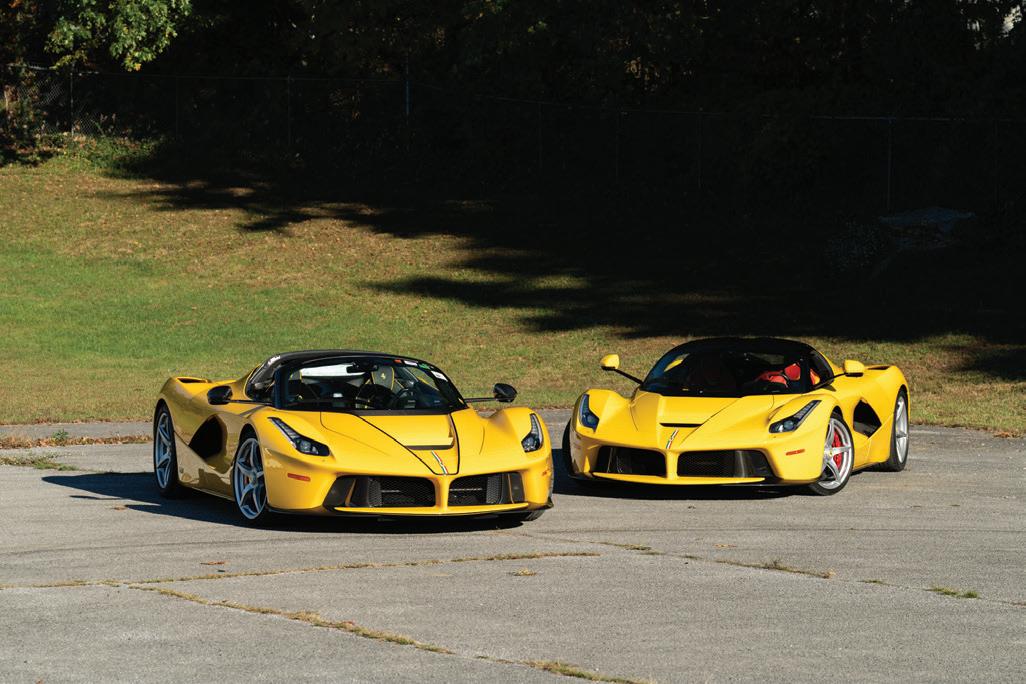




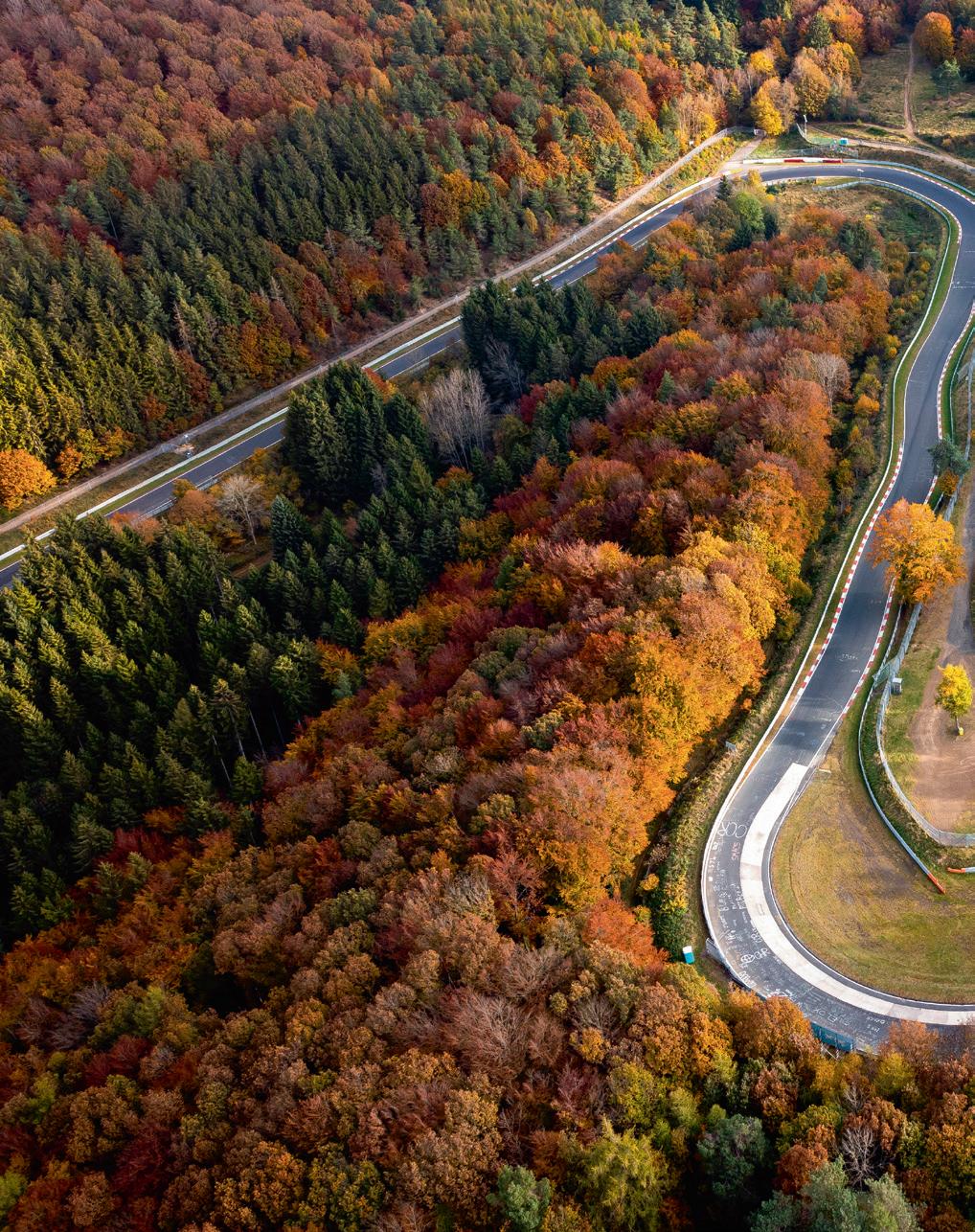

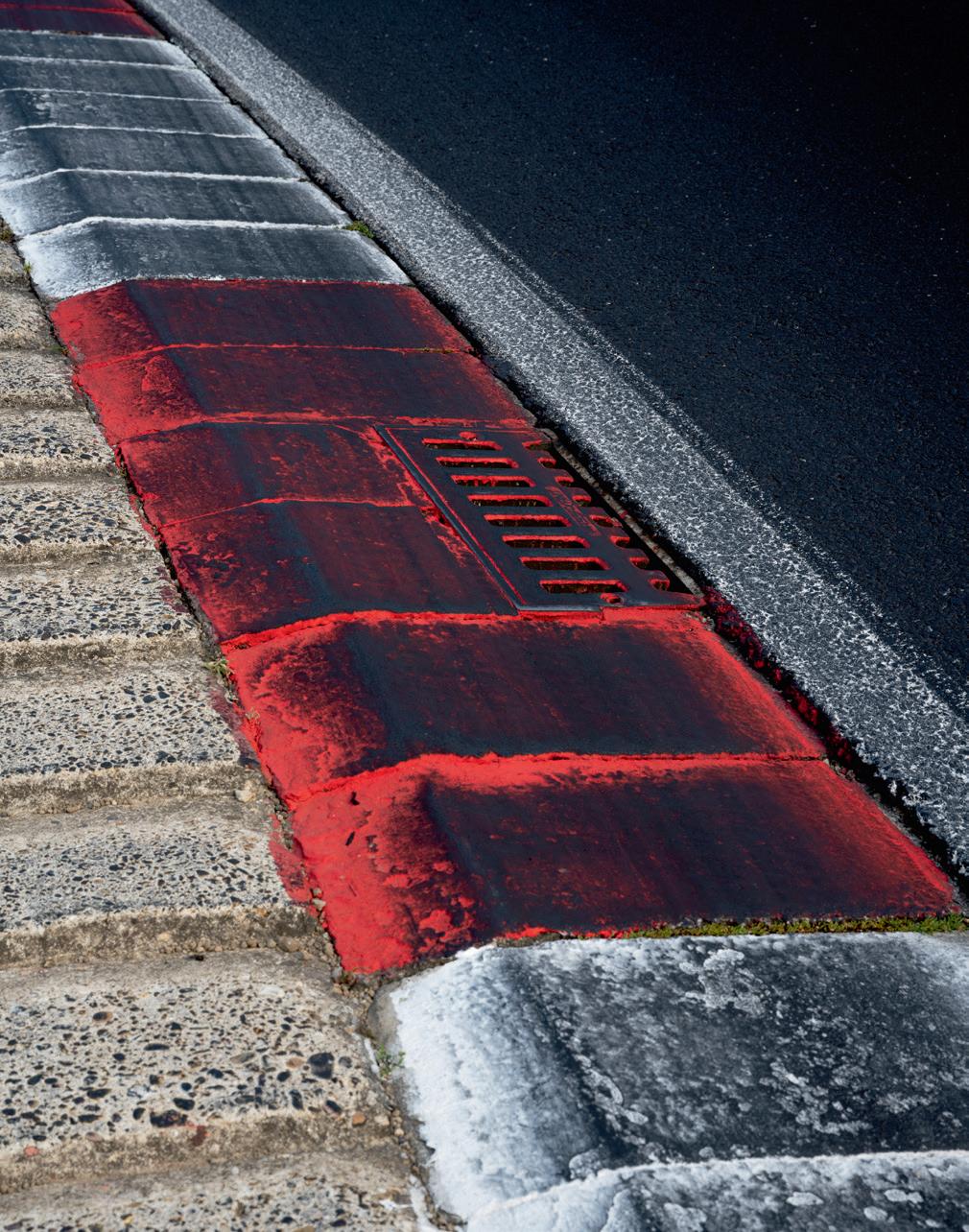
ONE HUNDRED YEARS SINCE WORK BEGAN ON THE NÜRBURGRING, WE SPOOL THROUGH HISTORY FROM THE GLORY DAYS OF THE SILVER ARROWS TO THE LARGER-THAN-LIFE ANNUAL 24-HOUR RACE, WRAPPING UP OUR ODE TO THE NORDSCHLEIFE WITH A HOT-LAP SLIDESHOW OF THE WORLD’S LONGEST AND TOUGHEST CIRCUIT.
SO PUT ON YOUR HELMET, BUCKLE UP AND SET YOUR MIND TO AWE-AND-RESPECT MODE
WORDS
GEORG KACHER
PHOTOGRAPHY
FRANK BERBEN-GROESFJELD
FOR YOU, WHAT DOES THE CATCHWORD ‘Nürburgring’ trigger? My initial flashback is in grainy black and white. Caracciola, Nuvolari, von Brauchitsch and Rosemeyer in bright, flabby overalls, their tanned faces badger pale where the goggles have left their marks, leading the 1935 drivers’ parade. Cut. Revolve to the next image, now in full colour; the blazing fire that engulfs Niki Lauda’s Ferrari, with the fearless Arturo Merzario diving into a slo-mo rescue. Cut. Wind forward to early 2025, as an extensively YouTubed Xiaomi SU7 Ultra prototype records a 6:22.09 lap time – the third fastest ever – beating every other contender to date bar Timo Bernhard in the Porsche 919 and Romain Dumas in the almost-forgotten Volkswagen ID.R. Cut. Another handbrake turn, this time to the pre-war days when the Nürburgring still features a short, 7.74km appendix aptly named Südschleife, which will stage its final competition in 1973 prior to being part-overbuilt by the new Grand Prix circuit inaugurated in 1984. Cut. The Nordschleife
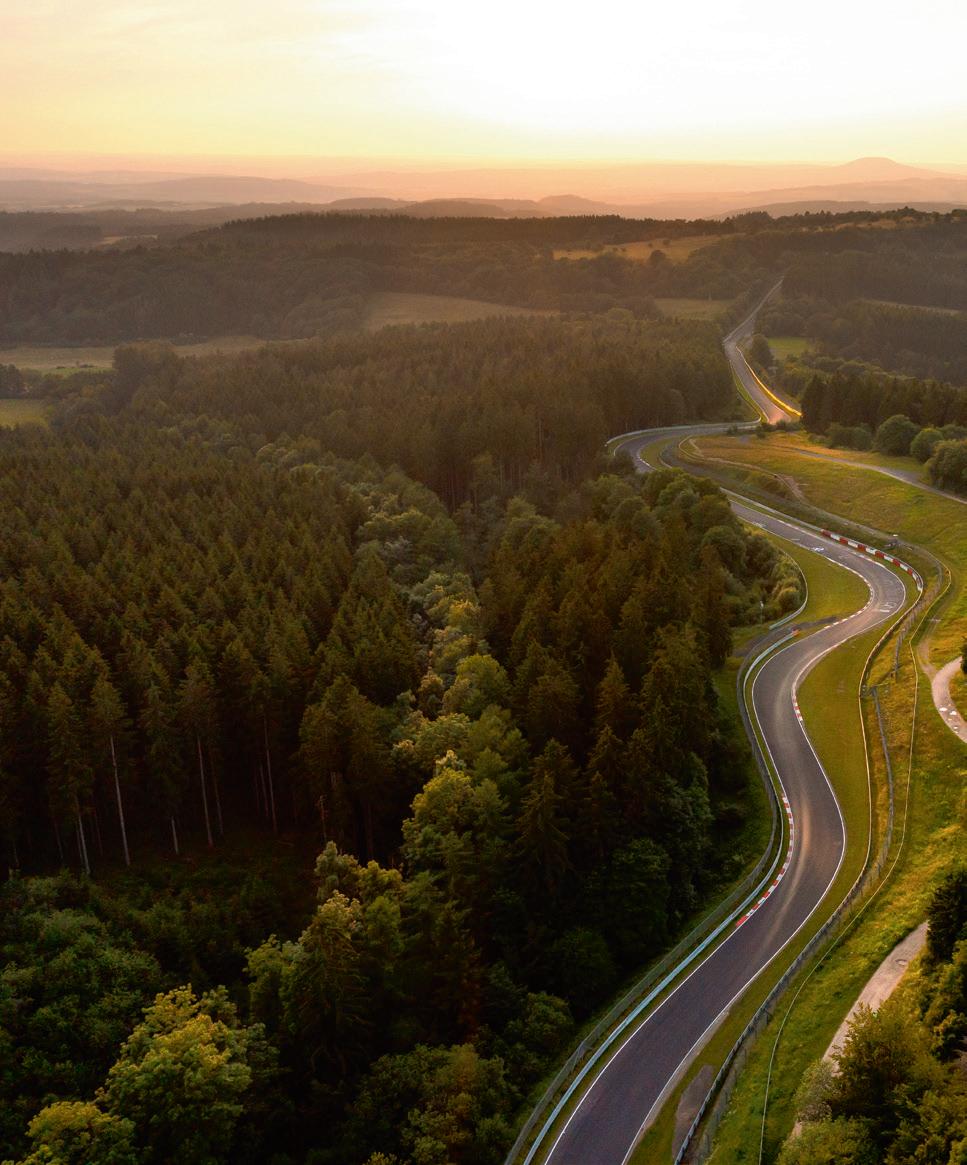
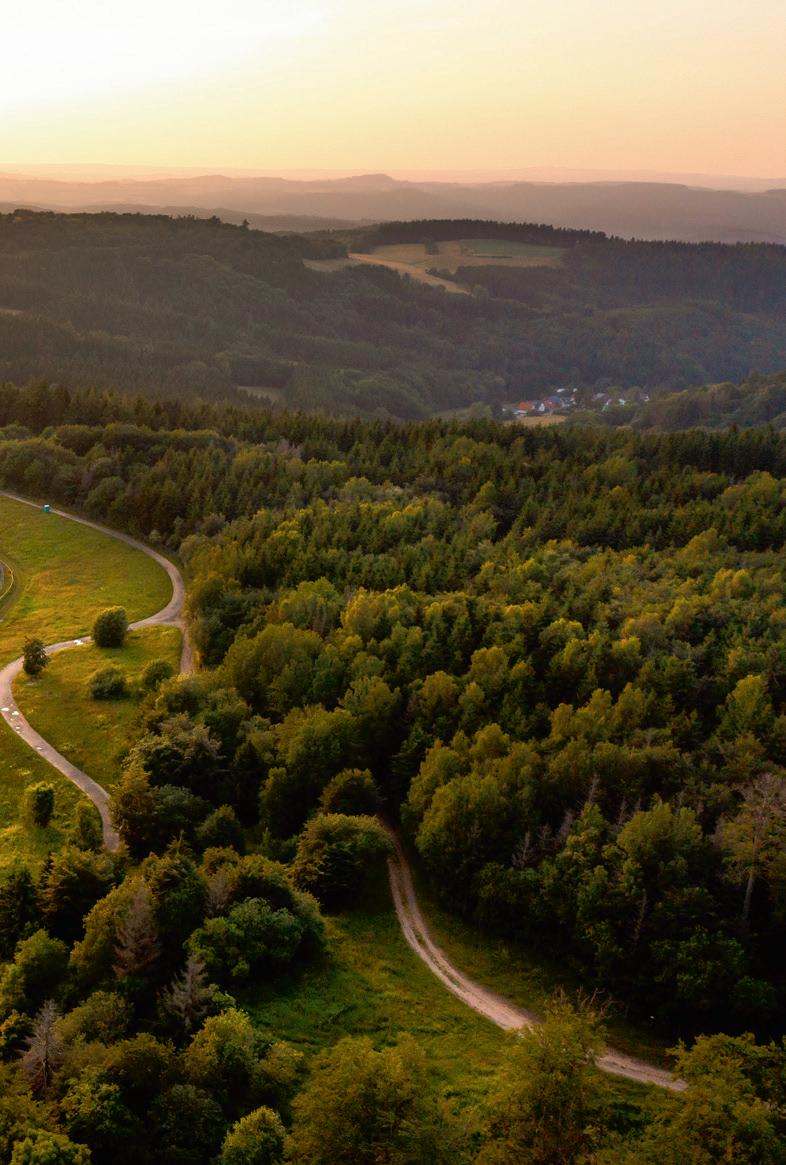

ABOVE With work starting in 1925 and the first race taking place in 1927, the challenging Nürburgring was the pride of Germany’s inter-war car industry.
loses its Formula 1 ticket in 1977 due to persistent safety issues, but even so its popularity will rise to new heights thanks to the annual 24-hour race that keeps attracting huge crowds. Cut. Enough food for thought? Now let the mind freewheel from one flashback to the next, conjuring more Nürburgring myths and memories.
The origin of the Ring, as we know it today, dates back to 1907, when Emperor Wilhelm II pondered setting up an extensive proving ground for the nascent German car industry. After World War One the idea resurfaced, and an early version of the Ring was compiled from several sections of public roads, which added up to a 33km-long street circuit. On July 15, 1922, the ADAC Rhineland conducted the first Eifelrennen, which attracted 134 competitors and more than 40,000 spectators.
Two years later, an encore was staged – and promptly deemed too dangerous for drivers and spectators alike. As a result, three senior county officials in charge of the Nürburg, Adenau and Mayen districts founded a special division of the ADAC that had only one mission: to build Germany’s ultimate permanent racetrack. The mastermind of the project was Otto Creutz, who

named Gustav Eichler as chief architect.
On May 18, 1925 the Adenau county council signed off “the construction of a groundbreaking permanent racetrack”. ‘Track’ was perhaps a bit of an overstatement; partially sealed one-way scenic drive without crossroads or turn-offs would have been a more accurate description. On September 27, 1925, 100 years ago this year, the foundation stone of the circuit was laid in the presence of the first president of the Rhine province, the former imperial minister Dr Fuchs. With the help of up to 2500 workers, the track was completed in only 23 months – no mean feat in view of the unsophisticated construction equipment and barren budget. The Eifel region’s volcanic nature, with its rich basalt deposits, allowed for the entire track to be built on rock. Initially, the surface construction consisted of a 20cm layer of very hard basalt covered with a sufficiently thick blanket of hand-crushed basalt, which was then flattened using huge steamrollers. Although the German Government spent close to RM15,000,000 on this prestige project, there were no guard rails whatsoever, no fences, no kerbs and most certainly no run-off areas. “The only changes here are the trees – they just get thicker every year,” quipped Jackie Stewart many years later – and he never experienced the original layout, which included a unique feature known as Steilstrecke (steep climb). This special section forked off


100 YEARS OF
LENGTH
20.832KM (12.94 MILES)
FASTEST LAP TIME 5:19.55 – PORSCHE 919
HYBRID EVO (JUNE 2018)
WIPPERMANN
BRÜNNCHEN
PFLANZGARTEN I
Initially just a flat 180º slow-speed corner, the Karussell’s sloped inside drainage area is first used by MercedesBenz driver Rudolf Caracciola to effectively slingshot his way to victory, finishing more than 78 seconds ahead of Louis Chiron’s Bugatti at the 1931 German GP.
6:11.13
In final practice for the 1983 1000km, Stefan Bellof’s Porsche 956 clocks the Nordschleife in just over six minutes, 11 seconds. His lap time remains the fastest ever recorded as part of a race event. Thirty years later, a section of the circuit is named the Stefan Bellof-S.
PFLANZGARTEN II
GALGENKOPF
DÖTTINGER
HÖHE
ESCHBACH EISKURVE
SPRUNGHÜGEL
KARUSSELL
HEDWIGSHÖHE
HOHE ACHT
F1’S FIERY NORDSCHLEIFE FINALE
August 1, 1976. On the second lap of the Grand Prix, Niki Lauda loses control of his Ferrari 312 in the section between Ex-Mühle and Bergwerk. He crashes heavily into a barrier and is engulfed in flames. Although suffering severe external and near-fatal internal burns, he’s back in his race car just six weeks later. Understandably, F1 turns its back on the Nordschleife for good.
KLOSTERTAL
MUTKURVE
KLEINES KARUSSELL
SCHWALBENSCHWANZ
KESSELCHEN
BERGWERK
A disastrous pitstop leaves Juan Manuel Fangio a minute behind the two leading Ferraris halfway through the 1957 GP of Germany. Unperturbed, the Argentine champion summons the speed in his Maserati to first catch Peter Collins and then pass Mike Hawthorn, just before the Breidscheid bridge. The win, his last in F1, earns him a fifth world title.




METZGESFELD
KALLENHARD
The Ring owes its name to the Nürburg Castle, which stands within the Nordschleife at the top of the secondhighest hill in the Eifel mountains, at an altitude of about 676m.
The castle dates back to the 12th century and was built by Count Ulrich von Are.
F1’S NEW HOPE
1981 sees the end of the Südschleife, the shortening of the Nordschleife (to 20.832km) and the commencement of a new, 4.5km-long, modern F1-spec race circuit that will take three years to build.
HOHENRAIN
TIERGARTEN
HATZENBACH
ANTONIUSBUCHE
KOTTENBORN
SCHWEDENKREUZ
ADENAUER FORST
FUCHSRÖHRE
Prior to the start of the 1968 Grand Prix of Germany, and no doubt thinking about the dangerously fast Fuchsröhre section leading into the Adenauer Forst, Jackie Stewart reportedly tells fellow drivers that: “It’s going to be the Green Hell this weekend.”
Despite heavy rain and fog, he dominates, winning by four minutes.
AREMBERG
HOCHEICHEN
QUIDDELBACHERHÖHE
FLUGPLATZ
POSTSTRASSE
THE ‘LIFT OFF’ OF AN ENDURANCE LEGEND
The inaugural Nürburgring 24 Hours takes place in 1970. BMW is off to a flying start as Hans-Joachim ‘Strietzel’ Stuck and Clemens Schickentanz win in a BMW 2002 ti – the first of a record 21 overall victories for the Bavarian car maker.
the Karussell and rejoined at the Hohe Acht. Although the 450m-long, arrow-straight shortcut that ran at a steady 27º pitch was used on only a handful of occasions, it claimed three lives; it was later converted to a part-time mountain-bike and toboggan parcours. In the 98 years of the Ring’s operation, more than 250 riders, drivers, marshals and spectators have been killed in action.
Unlike Le Mans, the Nordschleife is not a mix of purpose-built track elements and public roads cordoned off on race weekends. Instead, it was designed from scratch to meander its course through God’s own topography aka the Eifel mountains. The young Bruce McLaren described the Ring as: “Nothing like the map suggested, namely a long and fast track with about six righthanders and seven lefts. Instead, this is a highly complex circuit that needs to be conquered with maximum concentration, day-long practising and clockwork precision. But the biggest challenge is the 22.8km it takes to complete a single lap. A pitstop can thus be several minutes away, so you better nurse your tyres and play it safe in terms of suspension set-up. After all, it often is wet in one spot and bone dry again ten miles down the road.”
While the long start-finish straight was wide enough for up to six cars running abreast, the banked Karussell is to the present day strictly single-file only. The inaugural race, the 1927 Eifelrennen, was won by Rudolf Caracciola’s Mercedes-Benz at a 101.1kph (63.2mph) average. The triple rings (Nordschleife, Südschleife and
RIGHT It may have been made safer over the decades, but this historic circuit in the Eifel mountains has never become less fearsome.

100 YEARS OF THE NÜRBURGRING
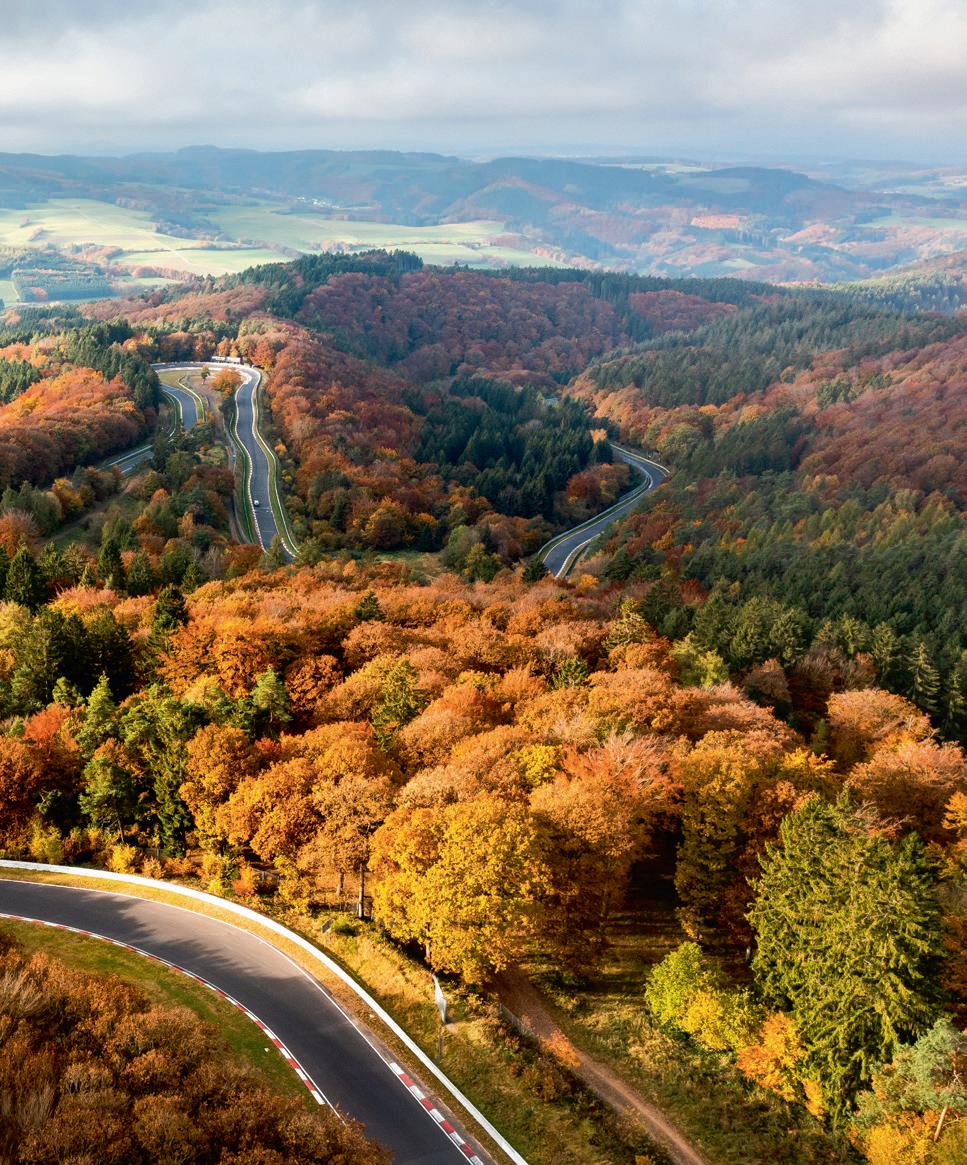
100 YEARS OF THE NÜRBURGRING

the relatively new GP course) have experienced their fair share of ups and downs over the decades. However, the German temple of motor sport has never come closer to absolute chaos and total financial disaster than in the 2004-15 timeframe, when the ill-fated Nürburgring 2009 project was founded to stop the bleeding caused by the loss-making long-term commitment to F1.
In a desperate turnaround attempt, the state of North Rhine-Westphalia, along with private sponsors, invested approximately €500,000,000 in a bloated new infrastructure, which included hotels, a fairground and the Ring Racer, allegedly the world’s fastest rollercoaster. But the venture backfired big time, and on July 20, 2012 the newly founded, privately owned Nürburgring Automotive Ltd, which could no longer meet the massive lease and credit payments, filed for bankruptcy.
The Ring was up for sale, yet neither the German ADAC automobile club nor the VDA association representing the nation’s automotive industry won the short bidding war. Instead, the famous racetrack went for a paltry €77million to Capricorn, which was later rolled into NR Holding, as still owned by the Russian entrepreneur Viktor Kharitonin.
Now reportedly permanently profitable, the Nürburgring 1927 GmbH & Co KG is making hay. Funds come not only from major motor sport fixtures such as the annual Ravenol 24-hour race, which typically attracts around 280,000
spectators, the Truck GP, the VLN series and the Oldtimer Grand Prix, but also from the Rock am Ring open-air event and, of course, from more than three dozen motor manufacturers and suppliers who use the Nordschleife as a real-life test bed between mid-March and early November, when winter idles all activities.
Not unlike the high-speed endurance runs on the famed Autobahn, extensive testing on the Nordschleife and subsequent fast lap times have become a kind of unofficial seal of approval, which can work marketing wonders for the manufacturers involved. To many enthusiasts, an outstanding performance on the Ring is worth more than the clinical data purveyed by manufacturers and magazines. “This track is a truly authentic proving ground,” confirms Jos van As, BMW’s former vehicle dynamics head honcho. “A model that does well here is also typically a cut above the rest on public roads.”
Five years after that very first Eifelrennen was staged on June 18, 1927, the organisers started fencing off the most critical areas of the circuit. In 1936, the Karussell received its famous banking. In 1938, a tunnel was built to connect the grandstands and the terraced viewing area on the other side of the widened start-finish straight.
During World War Two, endless convoys of army tanks demolished core sections of the Ring, while the Allied forces bombed infrastructure such as the Sporthotel and the original pit area. The
post-war reconstruction started with the shorter Südschleife. The Nordschleife was completed in 1950, adding the two-storied Mercedes-Benz building, which became the new home of race control, and the signature Dunlop tower.
In 1953, the first 1000km race took place. In its early years, the signature event was famous for its epic battles featuring Ascari, Behra, Brabham, Brooks, Caracciola, Fangio and Moss to name only the winningest competitors. Many races were, however, overshadowed by atrocious weather, brutal accidents and major mechanical breakdowns.
In 1963, the Karussell received its second makeover, while the Bergwerk corner was nipped ’n’ tucked. Armco began to pop up here and there, but run-off space still varied between scant and non-existent. The predominantly still-original track surface had deteriorated to a patchwork carpet over the years, too, which called for very different racing lines in the dry and in the wet. 1970 went down in history as one of motor racing’s darkest years. Hans Laine (Porsche) and Herbert Schultze (Alfa) lost their lives at the Ring. Bruce McLaren died testing at Goodwood. Piers Courage burned to death in Zandvoort. In the wake of these fatal accidents, Grand Prix Drivers’ Association representatives Graham Hill and Jochen Rindt declared the Nordschleife unsafe. They demanded 18 major conversion measures and numerous detail upgrades; these









could not be completed before the German GP, which was at short notice transferred to the Hockenheimring, although it did return to the Eifel one year later with Jackie Stewart repeating his 1968 victory in a Tyrrell-Ford.
At an expense of close to DM7,000,000, the Nordschleife was thoroughly refurbished once more in 1970-71. The 40 right-hand and 33 lefthand corners remained essentially unchanged, but the deep ditches on both sides of the track were filled, broadened and sealed. Kerbs were installed to cap the apexes of critical bends, most hedges came down, close to 10,000 trees were felled and the double guardrails were backed up by three rows of safety fences.
The legendary crests that used to send cars airborne at the Kesselchen, Brünnchen and Schwalbenschwanz sections were flattened. To improve medical aid and roadside assistance, 73 new multi-crewed marshal posts were installed along the entire length of the circuit. But it was all to no avail. On April 26, 1976, the CSI ordered the next round of safety measures; three months later, Niki Lauda’s monumental crash led to more negative headlines, and in June 1977 the authorities declared the Nordschleife unfit for Formula 1, period.
Contrary to the predictions of pessimists and naysayers, what could have been the end of an era turned out to be the beginning of a new one. While the new Nürburgring commonly referred to as the Grand Prix course overfulfilled all safety regulations, the Nordschleife was given one last
chance – and the people in charge grabbed it. In 1982, demolition crews flattened historic landmarks such as the start-finish building, the pit area and the Dunlop tower. Six years later, the Sporthotel Tribüne was torn down in favour of a nondescript modern dormitory operated by the Dorint group. In 1998, the two Rings were at long last officially connected by two short onand off-links, so today the full circle fuses both loops as one big, awesome whole.
Although the cleaned-up Nordschleife was no longer a naked harakiri piste only the best and the bravest could master, certain spots such as Bergwerk, Flugplatz and Pflanzgarten/ Schwalbenschwanz – later renamed StefanBellof-S – challenged the aerodynamic stability of the increasingly powerful and accordingly faster cars. After two more fatal crashes, the authorities implemented a previously unheardof 125mph speed limit for the Schwedenkreuz, Antoniusbuche and Quiddelbacher Höhe sections, which was lifted only after several jumps and ramps had been levelled off.
I never drove at Bathurst, but I did sample other famous ‘skull and crossbones’ venues such as the Tourist Trophy on the Isle of Man, Spa Francorchamps of Eau Rouge fame, Suzuka in the rain and Pikes Peak before it lost its gravel charm. All of the above was wide-eyed, yellowstreak, heart-in-throat stuff, no doubt about that. But nothing wrings out your guts more profoundly and plays guitar with your nerve strings more loudly than the Nordschleife, especially in the
dark and when visibility, grip and confidence are impaired by weather – often in reverse order.
Believe me: those lurid YouTube takes and fancy simulator drives are nothing compared to putting your hands on the wheel of a real thing, which will shake first your body and then your ego in a fast-forward staccato with zero room for error and no emergency-stop button.
Although one can try to learn, read and adjust to the Ring, mastering it is an ongoing, neverending task. There may be a brief high after the first 50 laps, but it’s only a mirage, because making fewer mistakes doesn’t mean you’re automatically near as slick and quick as the seasoned regulars in their underpowered tin boxes who score the big points where it matters, lap after lap.
Take the approach to Adenauer Forst, which calls for the perfect braking point. Or Metzgesfeld I and II, a successive tightrope in surroundsound 3D. Kallenhard, a tricky triple right-hander that accepts the same lock as long as the initial input is spot-on. Bergwerk, but only if you can erase that Lauda image from memory. Pflanzgarten I – small jump; Pflanzgarten II – long jump, then brakebrakebrake! Hold your breath on Schwalbenschwanz; pedal to the metal on Döttinger Höhe, then Antoniusbuche, Tiergarten, Hohenrain. A hero in the making? I wish.
Speaking of heroes, who exactly did write history... deserve more than an honourable mention... were the high-flyers of their time... perhaps even had a corner named after them? What about Stefan Bellof, who held the








Nordschleife lap record for 35 years. Or the late Sabine Schmitz, charming Queen of the Ring and veteran drift taxi driver – always sideways even in a Ford Transit. Misha Charoudin, click-rate millionaire who allegedly drove more laps on the Nordschleife than the three runners-up combined. Marcel Tiemann, who won 19 times in all sorts of odd souped-up devices such as a V8 Opel Astra (2003). Phil Hill, Ringmaster in ’62 in a F1 Ferrari and again in ’66 when he was first to see the chequered flag in Jim Hall’s Chaparral wingmobile. Timo Bernhard, who had a firm grip on this monumental circuit long before he became a Works driver and etched an incredible 5:19.55 time into the holy blacktop in a pimped Porsche 919.
The most dramatic Ring battles? There were many unforgettable nail-biters in F1 (1951-76) and F2/F3000 (1950s-2013), the ADAC 1000km (195383), touring and sports car events such as WTCC/ WTRC and WSC/DRM (1970-85) and DTM (1984-93), VLN/NLS (since 1977) and, of course, the legendary 24-hour race that dates back to 1970.
In 1934, our grandfathers might have witnessed the birth of the first Silver Arrow, when the justoverweight Mercedes-Benz W 25 was in a lastminute effort stripped of its white paint down to the bare-metal shell, a livery later adopted by Auto Union and early Maseratis. Ferrari red was the winning colour from 1950-53, but one year later Mercedes-Benz returned to the top of the rostrum with Fangio wrestling the new W 196. In 1957, the Argentinian won what was later heralded as the ‘race of the century’ in a Maserati 250F, when he caught up with and then overtook the Ferraris of Mike Hawthorn and Peter Collins in an epic stunt.
The 1960s were firmly in the hands of British champions such as Moss, Clark, Hill, Surtees and Stewart. In a memorable blind flight through fog and rain, the young Scot won the 1968 German GP in a Matra-Ford, bringing home a four-minute lead over his closest rival, and coining the term ‘Green Hell’ in the wake of his heroic victory.
Although F1 remained the main attraction, the 1000km races were much more than stop-gap supporting acts. What started with the historic red vs silver battles heated up again when Germany recovered from the war and new entrants such as BMW and Porsche joined the fray: think Ferrari 330 P4 vs Porsche 910 (1967) or Ferrari 512 S vs Porsche 917K (1970). After F1 had finally been expelled from the Ring, sports car action peaked, setting the cornerstone for even more popular blockbusters such as DTM featuring heavily modified mainstream models, NLS and the mass magnet that is the 24-hour race starring amateurs and pros, hot classics and hardcore GT3 machines. In 1995, F1 returned to the Eifel and Michael Schumacher duly won the inaugural Grand Prix of Europe, but somehow the lustre, the fascination and, mercifully, the tragedies didn’t quite make the transition from goose-pimple Nordschleife to new, super-safe, lab-like battleground, which was

not immediately embraced by fans or competitors. By that time, the Ring had evolved into a split personality: part bland world-class quick fix, part eerily mythical, fear-inducing legend.
Top-league racing went to Hockenheim in 2014, before the German GP was cancelled altogether six years later. The Green Hell hosted its last 1000km in 1983. The event reappeared on the new GP track one year later, but the appeal wasn’t quite the same. In 2005, the lesser-known winners were Hayanari Shimoda and Tom Chilton in an equally obscure Zytek 04S. The rest, as they say, is history. Twenty years later, on the eve of the centenary of the Ring’s 1927 opening, the two loops have long made peace with each other. Covid came and went, Ferrari finally broke the long-lasting Audi/ BMW/Porsche dominance in 2023, the latest laprecord holders speak Chinese and drive ultra-fast EVs with four-figure power outputs, motorbikes are no longer allowed on the Nordschleife, and the biggest Volksfest of them all is still the 24hour May weekend when fizzy wafts of bratwurst and beer neutralise the trad high-mech whiffs.
While the string of fatal accidents has thinned, fringe attractions are booming – such as Darts am Ring, Historic racing and a new six-hour WEC event. Although the GP track is a great supporting act, the emotional centre stage still belongs to the Nordschleife, that listed ancient motor sport monument that has more stories to tell than any other circuit in the world. Not to forget the random access to any number of DIY hot laps, which must make the child inside very happy indeed. Thanks to Frank Berben-Groesfjeld for his stunning images. See more in 360 Nürburgring: The Official Nürburgring Nordschleife Guide. It costs €39.95 and can be purchased at www.thedrivealliance.com.
The Nordschleife is so many different things to so many people. It’s hard to categorise, let alone prioritise the impact it has had over almost a complete century. The early days were captured in their full glory and tragedy on flickering newsreel films, immortalised in myriad clippings and photographs, rolled out in great detail in more than 100 books. Now that live TV is covering every event 24/7, action on the Ring is backed up by a bunch of video games, simulator drives for all talents and pockets, various podcasts and streaming programmes plus an omnipresent wealth of social media posts.
Of course, you can still drive up to the Ring, peep through the holes in the fence and catch a bunch of camouflaged top-secret prototypes or clusters of nerds chasing each other in bespoilered widebody hot hatches. Buying a ticket and watching the race from the grandstand (or mingling with the plebs around Brünnchen and Pflanzgarten) is a more intimate option, but in essence no authentic Nürburgring experience is complete without a scary fast lap in a Ring Taxi or, better still, at the helm of your own favourite plaything. It can’t be done? Yes it can. Check out opening hours and availability at www.nuerburgring.de. Although the Nordschleife is a pet proving ground of the global car industry, the track is open to the public most evenings between 5:00pm-7:00pm and most weekends from 8:00am-7:00pm. You pay per lap, either online or directly at the gate on the L93 between Nürburg and Meuspath, past the roundabout and the small lay-by where the local heroes like to stop for a warm-up pose. The fee varies between €30 and €35. A seat in a drift taxi can be booked for €99; new shorts and sick bags cost extra. For €3000, the organisers will sell you a season ticket that is valid on both circuits. You guessed it: there is no discount on tyres, bodywork repair or tow-truck services. The fee for a professional two-day driver-training course including trackside lunch is a very competitive €895.












Step into the golden era of motoring with the Flying Scotsman 2026, a spectacular 600-mile journey through the Scottish Highlands, created exclusively for pre-1948 cars. From the elegant start at Gleneagles Hotel, crews will take on 10 thrilling Tests and 16 challenging Regularities, navigating legendary rally roads through the Cairngorms, Aberdeen, and Inverness, before returning south for a champagne finish at Gleneagles.
This isn’t just a rally—it’s an adventure filled with breathtaking landscapes, unpredictable Scottish weather, and the camaraderie of like-minded enthusiasts. From the prologue that sets the tone, to three unforgettable days on the road, the Flying Scotsman blends competition, nostalgia, and world-class hospitality. Expect the roar of engines, the beauty of lochs and mountains, and moments of triumph as vintage machines and their crews prove themselves against the elements. Whether you’re drawn by the thrill of the drive or the magic of classic motoring, this is a rally like no other.






NÜRBURGRING
STORIES

THE FIRST TIME I EVER WENT TO THE Nürburgring was in 1970 for European Formula 2 [he finished ninth in the Eifelrennen in a Brabham BT30]. I learned the circuit in a VW Beetle rental car, and I had to go down to second gear for the climb up to the Karussell. To learn the circuit on your first visit is not particularly easy.
It wasn’t until 1974, when I went back and raced a Works Chevron B26 in the Nürburgring 1000km, that I felt I began to understand the rhythm of the circuit. That little Chevron just flew. Once you’d got the rhythm, you could start to attack the circuit. That was when a level of satisfaction for me was realised.
I did three Grands Prix at the Ring: 1974 in a Hexagon Brabham, 1975 for Team Lotus and 1976 for Penske. In 1974 it was my first time there in a Formula 1 car, and I was with a new team.
While the little Chevron was light, nimble and confidence inspiring, I set off in an F1 car with no knowledge how to make it driveable.
When I drove the Lotus 72 in 1975, I hadn’t even sat in it until I got there. Colin Chapman was asking me: “What’s the car doing – is it understeering?” I told him to just leave me alone and allow me to work up to a pace. I never felt that I got the better of the circuit in the three Grands Prix I competed in – I never felt the confidence I had in the Chevron.
As we moved into the mid-1970s, the circuit was deemed unmanageable. Marshal posts were too far apart. The other critical thing, which was
really F1’s death knell, was having a GP circuit that takes more than seven minutes to do a lap. For a 180-mile GP, you’re going past each corner only ten or 12 times. Commercially, it was a waste of space and didn’t work for TV.
When Niki Lauda had his infamous 1976 crash, I came on the scene after it’d happened. I think the fire was out, and Brett Lunger, Harald Ertl, Arturo Merzario and Guy Edwards were with him. I ran down to see what the hell had happened. Niki was able to walk with some assistance. I got down on my knees, he lay down and put his head against my thighs. He was lucid but obviously deeply shocked. I remember him asking: “What’s my face like?” I said: “You’re OK, don’t worry. The medics will be here in a few minutes and we’ll get you to hospital. You’ll be fine.” What I didn’t say was what I could see. It was his scalp. His helmet had come off in the accident [breaking a cheekbone] and his forehead had been burned, but his scalp was much worse. Parts of it were charred black. What nobody realised was the inhalation of the burning fumes from the glassfibre cockpit resins had got into his lungs. That’s what nearly killed him. Formula 1 dropped the Nordschleife after 1976. Perhaps some drivers were disappointed, but Niki’s accident highlighted the circuit’s shortcomings. He certainly had no interest in racing there again. It was a dinosaur anyway, and it would not have been a great place to take the ground-effect and turbo Grand Prix cars we had in the late 1970s and early 1980s.
100 YEARS OF THE NÜRBURGRING

NÜRBURGRING
STORIES
BRIAN REDMAN
A four-time Spa 1000km winner who also claimed double victories at the Nürburgring 1000km, Daytona 24 Hours, Sebring 12 Hours, Monza 1000km and Österreichring 1000km in an illustrious sports car career
I’D JUST TURNED PROFESSIONAL WHEN I first went to the Nürburgring. I did one exploratory lap in a Vauxhall Cresta to learn the circuit, then I had to stop because the brakes had completely gone. A BMW 1600 drew up, the driver’s window wound down and a voice said: “Like a ride round, old chap?” My first time at any speed was with Stirling Moss.
Although I was supposed to drive Peter Sutcliffe’s Ford GT40 in the 1000km, my father had a stroke and I had to go back to England. Peter had said to me: “Now Brian, remember two things. The first thing is, this is my car… The second thing is, you see all these little bushes around the track? Just remember that underneath them is 100 feet of trunk.”
I took my first of two wins in the 1000km in 1969, in the factory Porsche with Jo Siffert. That was when I got my Nürburgring gold ring. Four months ago John Fitzpatrick emailed and said: “Do you know what your ring is worth? I have just been offered £125,000 for mine…”
They weren’t going to give me a ring, but it was Siffert who insisted. That was because when I took over from Jo, Pedro Rodríguez took over from Chris Amon in the factory Ferrari, and
the expectation was that Pedro would go off into the distance. But I actually pulled out a minute and a half in the next hour.
In 1973 I shared the winning Ferrari 312 PB with Jacky Ickx. Arturo Merzario was with Carlos Pace in the other car. Before the race, the team said that if a Ferrari was leading at the halfway point, then the other car must not try to overtake. Well, guess what happened? We were leading and I was starting to relax, then right in front of the pits old Merzario comes hurtling by. Now we had a major battle for two laps. Arturo had to stop for fuel with a couple of laps to go, and they ordered him out of the car. “Get out, get out!” But he gripped the wheel with his head on top of it, and held on tight. They hauled him out eventually, and then he refused to attend the prizegiving when Ickx and I won.
I know a lot of famous people have said the Nürburgring was the most difficult and dangerous place, but I didn’t think it was. I was more comfortable there than at Spa. To me, Spa was much more difficult, because of the tremendous speed. It had hardly any corners, but you were always going so fast. I liked the Nürburgring, knew every inch of it and enjoyed it.

THIS SPREAD From an early GT40 drive in 1968 to a winning 312 PB in 1973 – and more –Redman’s 1000km career was long and illustrious.
The first person
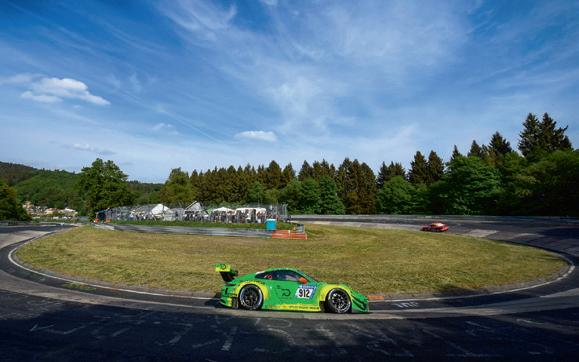
ABOVE Tandy’s first Nürburgring 24 Hours win came in 2018, in the Manthey
PEOPLE ALWAYS ASK WHAT IS THE hardest of all the big endurance races to win? I tell them that it’s the Nürburgring 24 Hours. You can have a quick car and be having a good run, but so many things can take the victory away from you. At the Le Mans 24 Hours there might be five cars that can win, but at the Nürburgring in the GT3 era there are 30 cars that can win – and 30 things that can snatch victory away.
To win it as a Briton was special – I’m only the fourth Brit to do it. Germany has played a big part in my career. I was also the first Briton to win the Porsche Carrera Cup Deutschland, in 2011. That was very important in setting me on the way to a Porsche factory deal – and then to win at the Ring with Manthey in 2018 was huge.
The track also gave me my first paid drive. At the back end of 2010 Porsche felt it needed to test the waters for the World Cup event on the Nordschleife the following year. It wanted to run a Cup car with drivers who’d never been there before, and it put three of us who were running up front in Germany in a VLN race. The team was trying to understand what was going to happen when it had 100 drivers from the different Carrera Cups out there.
I knew the place like the back of my hand: I
grew up in the Gran Turismo era and had done thousands of laps around there on my PlayStation at home. I first drove it in the flesh in 2009, racing on the Grand Prix circuit in the Formula 3 Euro Series. What’s the first thing a young driver does when he goes to the Nürburgring? Pays for some tourist laps on the Nordschleife. I did three or four in my Fiat Panda hire car with my missus alongside.
The Nordschleife is my favourite track along with the Brands Hatch Grand Prix circuit; if you multiplied the length of Brands by five, they would feel quite similar. They are both narrow tracks, in and out of trees, up and down, and super fast. That’s what people sometimes don’t appreciate about the Nordschleife: it is such a fast track with only a handful of slow corners. It’s a fast corner, a load more fast corners, then a straight and then another fast corner.
But you can’t go there and drive at 99 percent. Doing that at Road Atlanta or wherever is going to cost you three- or four-tenths. On the Nordschleife, it will add up to a whole bunch of seconds. Do that in a race, and you won’t get invited back. The proximity of the barriers does heighten the thrill, because you know that an error will be costly. Most likely it will be race-ending.





















Jean Alesi’s first Grand Prix Car - used at the ‘89 French GP by Alesi to finish an impressive 4th overall in his first F1 race at Paul Ricard. Designed by Harvey Postlethwaite and Francios Migeot, the Tyrrell 018 was a a highly e ective F1 car for the Tyrrell Team, with podium finishes for driver Michele Alboreto earlier in the season, and a Fastest Lap for Jonathan Palmer the car was a competitive proposition against the might of McLaren and Ferrari. Alesi’s performance immediately made him one of the stand out F1 drivers and brought him to the attention of Williams and Ferrari. Completely rebuilt by Front Row Racing, this car has freshly built 3.5L Cosworth DFR engine running Motec management, rebuilt gearbox, suspension and new fuel cell. O ered for sale complete with running equipment, the car wants for nothing. This is an iconic car from the glory years of 3.5L Formula 1 and ideal for some of the excellent F1 support events. Please call for more info.
NÜRBURGRING
STORIES
TIMO BERNHARD
Five-time winner of the Nürburgring 24 Hours and holder of the fastestever lap of the Nürburgring Nordschleife race circuit at 5:19.55 in a Porsche 919 Hybrid Evo 100 YEARS OF
I GREW UP WITH THE NORDSCHLEIFE: I first went aged five, when my father was racing in the VLN, and I had a big track map with all the corner names on my bedroom wall. I got to drive the Nordschleife before I had a road licence: I snuck out in a Volkswagen Passat when I was 16. I always wanted to race there, and my chance came in 2001 when I was a Porsche junior. Herbert Ampferer [Porsche’s motor sport boss] asked if I would be interested in doing the Nürburgring 24 Hours with Phoenix Racing. It had two 911 GT3 RSs and one seat left. I said: “Yes, please. I’m ready to go.” I wasn’t: I didn’t really know the track, and it was only two or three weeks before the race. In those days you didn’t need the Nordschleife permit, so I was signed up for what Porsche calls the ‘industry pool’ – the drivers who do street-car development. I got to drive the 911 GT2, which was a bit of beast. I did 22 laps and got through two sets of tyres and a set of brakes in a day. Porsche wasn’t as keen on sending its drivers to race on the Nordschleife as it is today; sometimes I had to fight to go. In 2004, the race clashed with Le Mans, but Manthey had a seat for me at the Ring. I really wanted to do it because I’d be racing for overall victory in a very competitive year. That was when Opel and Audi entered their DTM cars. We ended up third, and the next year we had an engine failure while we were leading from the BMW that won. It was heartbreaking – we’d had a real chance. My winning streak started with Manthey in 2006, which was a big moment for me. We probably had the best package in 2007 and
’08 with Manthey’s 997-shape GT3 RSR. But you can never be confident of winning that race. You might be out on slicks when it starts raining halfway around: then it’s all about survival. It was tougher in 2009 when Audi came with its R8 GT3 car. The team was pretty much our equal. I’d say 2011 was the hardest of my five victories, with all the GT3 cars and the BMW that finished second. My focus was switching to prototypes at that time, first with Audi and then back at Porsche, and I wasn’t really pushing to race on the Nordschleife.
When I was asked to go for the record attempt in the Porsche 919 Hybrid Evo in 2018, I was excited – but I knew it was going to be tough unleashing such a high-tech car on that track. I had a huge respect for the crests. If you look at the onboard lap, you can see I keep my foot on the brake at places like Schwedenkreuz and Flugplatz just to keep the nose down.
We wanted to be out by 9:00am at the latest because it gets warmer and the conditions are more difficult then. We wanted to break my idol Stefan Bellof’s record – respectfully. What he achieved back then [in 1983, Stefan posted a time of 6:11.13 seconds in a Porsche 956 during a qualifying session for the Nürburgring 1000km] was insane. In my case, the car was built for this one lap. A prototype. Lightweight construction. Special tyres. And I had the track to myself. This acceleration, the deceleration, the downforce: insane. I have not experienced lateral forces like that since. That was extreme freestyle. I’ll never forget it.
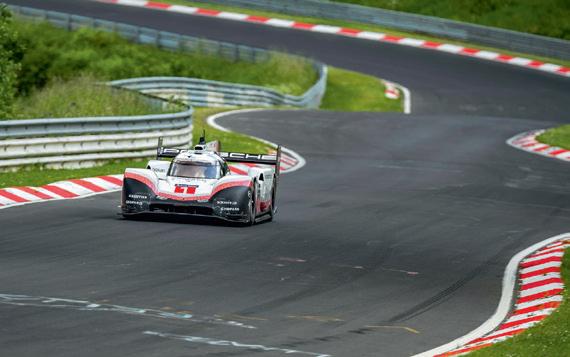


































































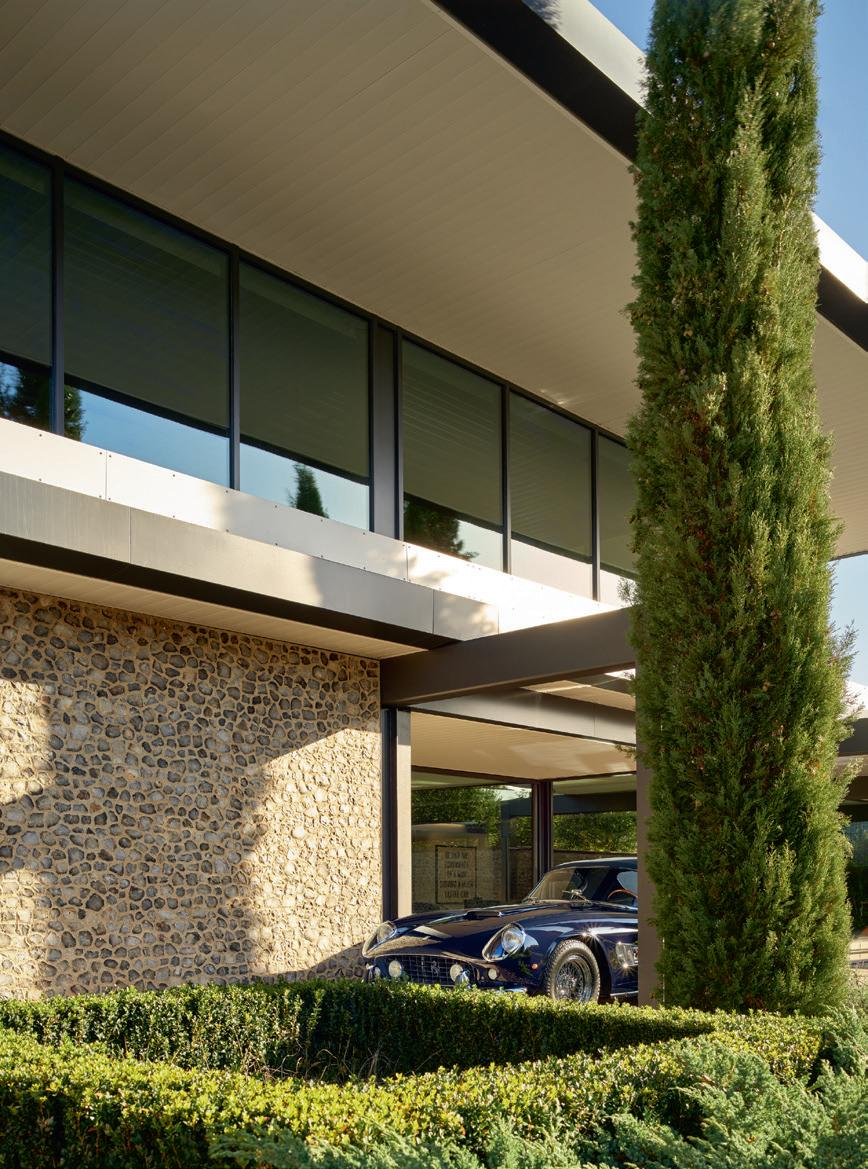
WHEN A LONG-LOST 1961 FERRARI 250 GT CALIFORNIA SPYDER SWB WITH A HOLLYWOOD
CONNECTION TURNED UP IN A FRENCH BARN, THE GOSSIP STARTED TO FLOW. FOLLOWING EXTENSIVE RESTORATIVE SURGERY, THE STAR WAS READY FOR THE SPOTLIGHT ONCE MORE

THIS SPREAD A Hollywood-ready car fit for the movies;
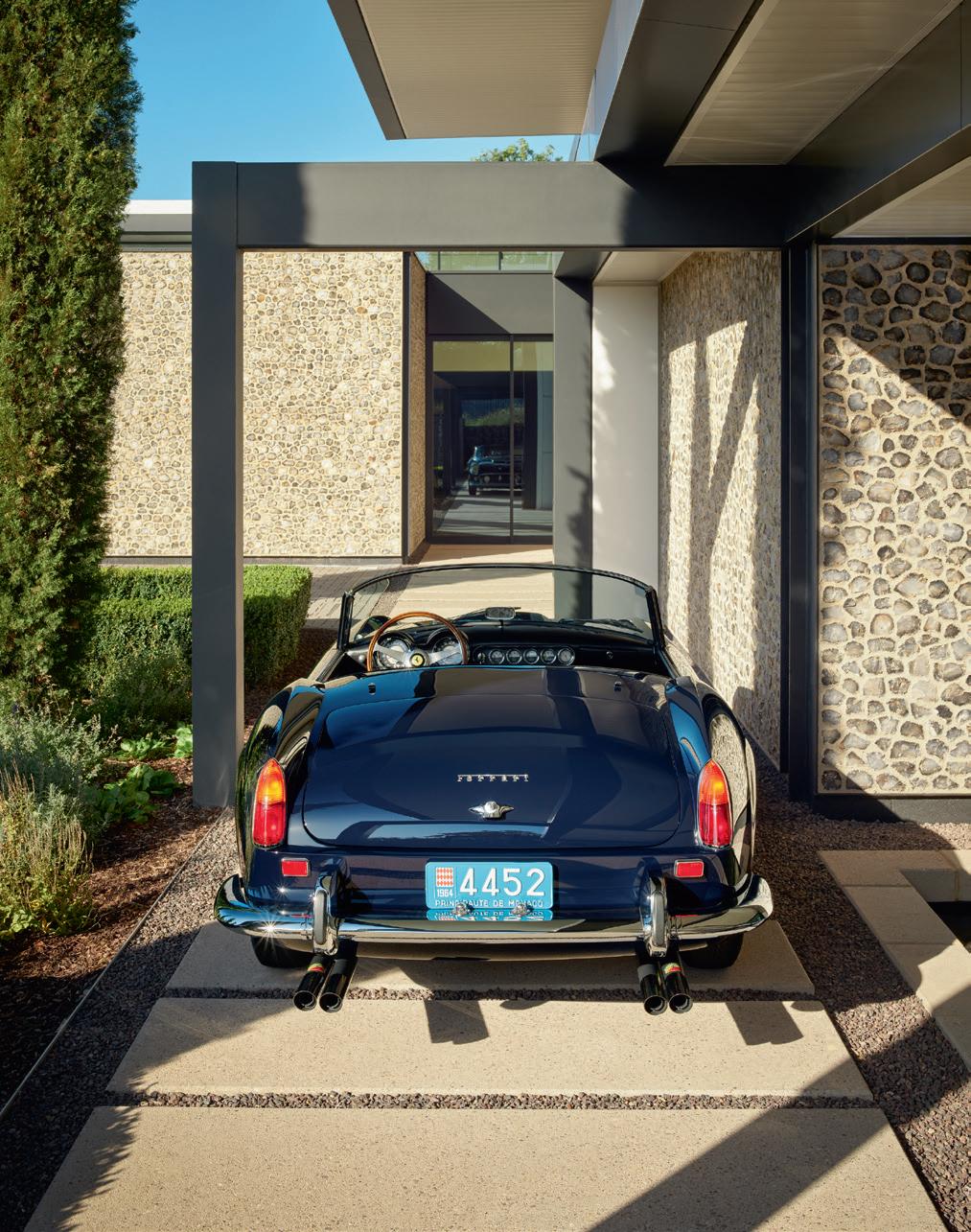
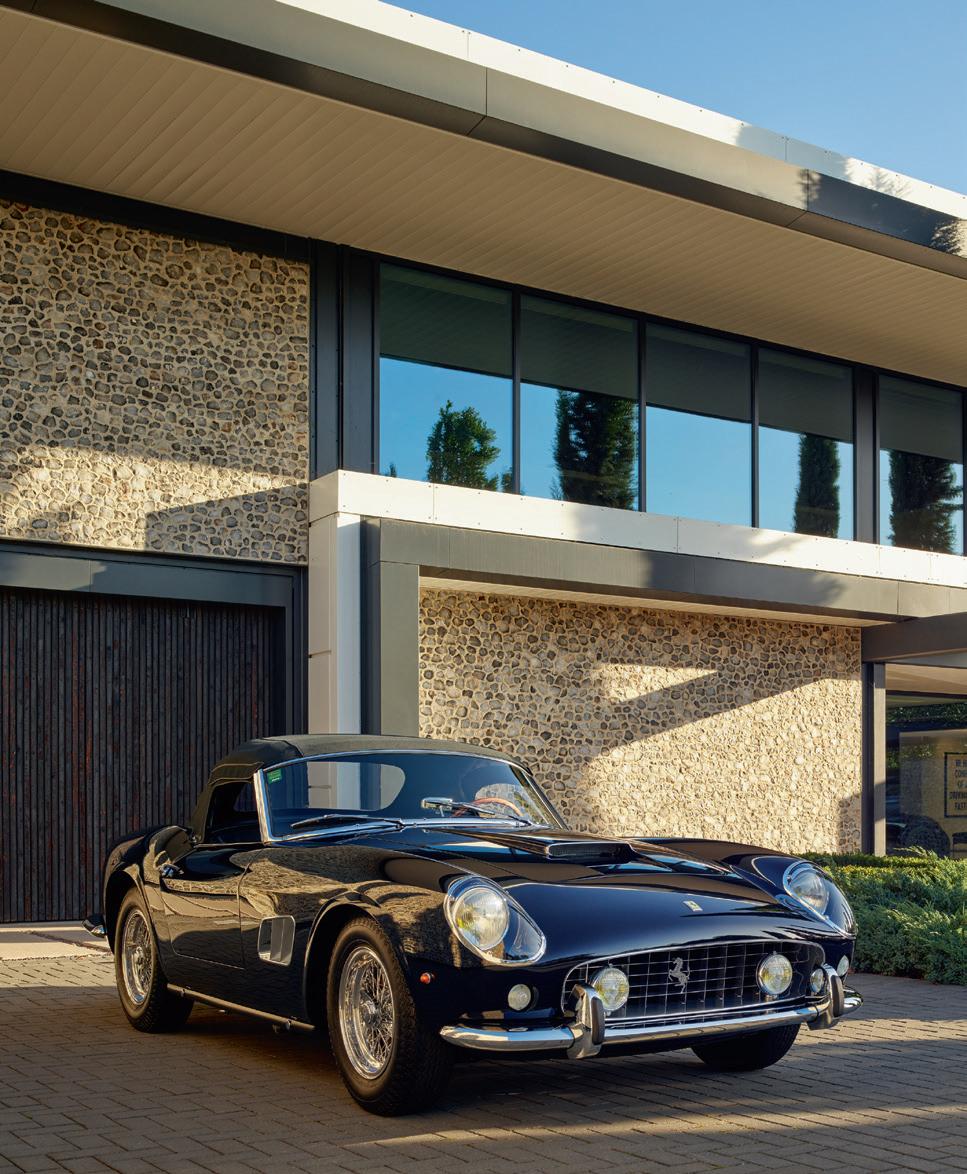

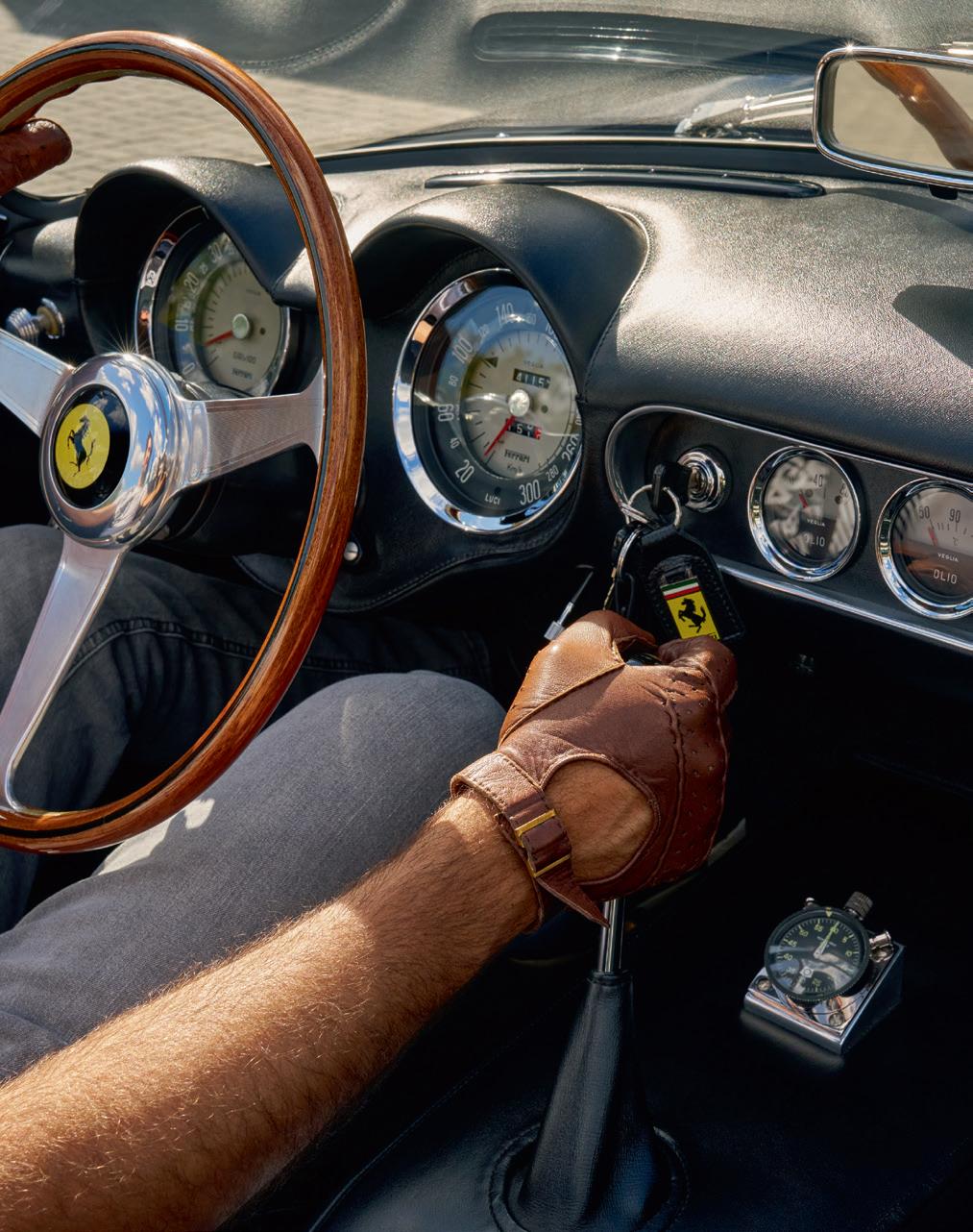


DO YOU REMEMBER THE THRILL AND surprise of seeing those very first Baillon Collection barn-find images? The rows of classic cars, dust-laden, sinking into the ground in open sheds in rural France.
These driving gloves originally belonged to Alain Delon, and amazingly they stayed with the car throughout its life. Delon also fitted the period stopwatch in the Ferrari.
And then there was the image that you’ll be able to conjure up right now, if you close your eyes. Through the open doors of a more habitable chateau garage, two yellow-headlamped exotic classics alongside each other: on the right, a 1956 Maserati A6G Frua, its paint flaking off the bonnet, its grille gaping in surprise at its fate. On the left, under unfeasibly large piles of L’Automobile magazines, a 1961 Ferrari 250 GT California Spyder SWB, looking every bit as out of place as it should in such wildly inappropriate surroundings.
That was back in late 2014, believe it or not, with the entire collection offered – very successfully – for sale by Artcurial during Rétromobile Paris in February 2015. You might remember that all 59 cars were displayed in a dimly lit hall, where music played discreetly in the background and visitors unwittingly spoke in hushed tones as though in a sacred mausoleum.
How strange, then, to be stood in bright sunlight

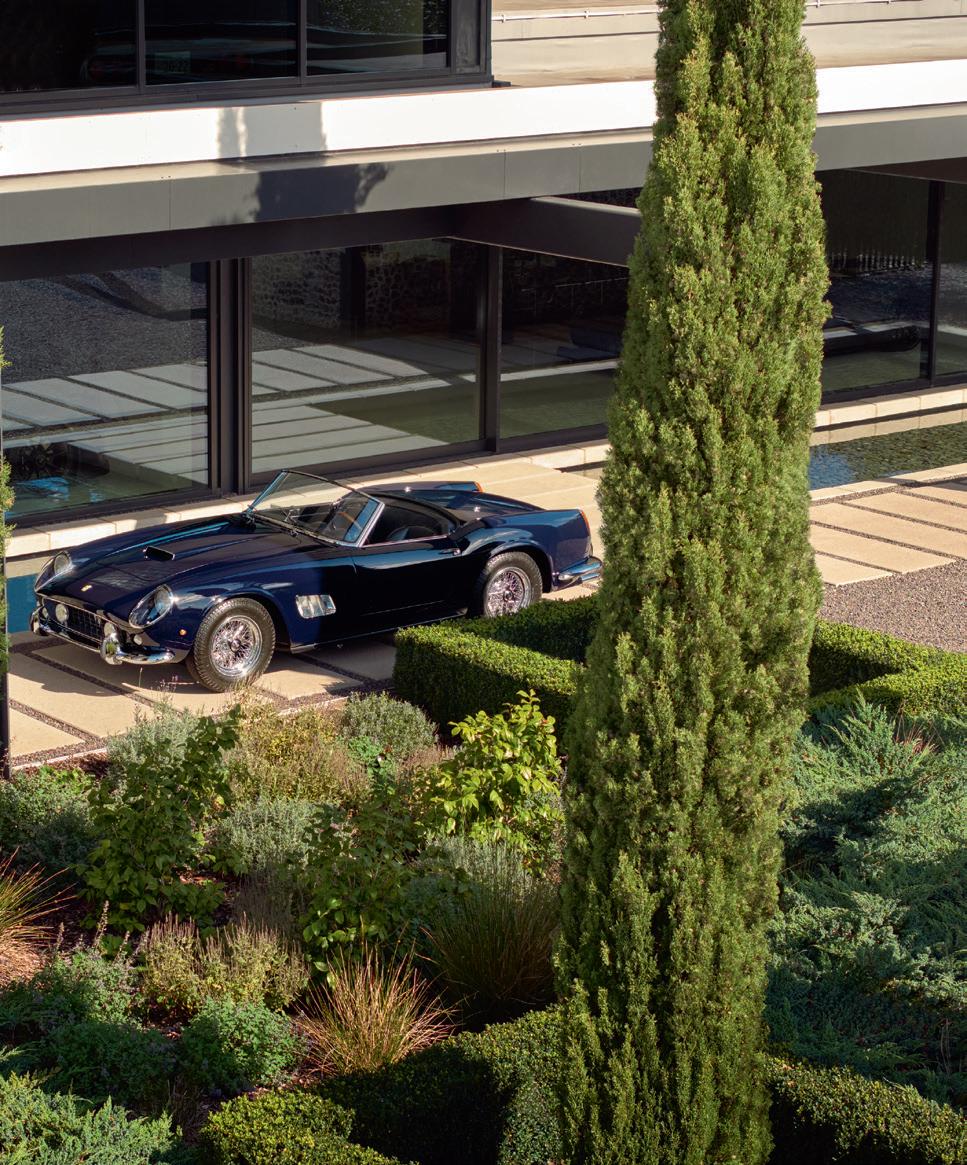



alongside the now-sparkling star of that sale, and indeed the collection, outside the pristine Kiklo Spaces car-care and storage facility in Hampshire, UK. There’s not a speck of dust on the bodywork, nor a stray leaf on the driveway. It’s a little uncanny to be reunited with one of the most famous Ferrari 250s of all time like this.
The past decade has been kind to the Baillon California, having sold at the Artcurial auction before heading to the most renowned of all Ferrari restorers, Paul Russell & Company in Essex, Massachusetts. Since the sale, it has made four public appearances, at the Pebble Beach Concours d’Elegance, Cavallino Classic, Concorso d’Eleganza Villa d’Este and Concours of Elegance Hampton Court, before discreetly returning home for a well deserved quieter life. At least until we brought it out for this photoshoot. Surely it deserves the rest, for long before it came to reside in the renowned Baillon Collection, this beautiful machine lived among the beautiful people. Its documentation and a wealth of archive images confirm its charmed life: chassis 2935 GT emerged from the factory with black Connolly leather and painted in a dark
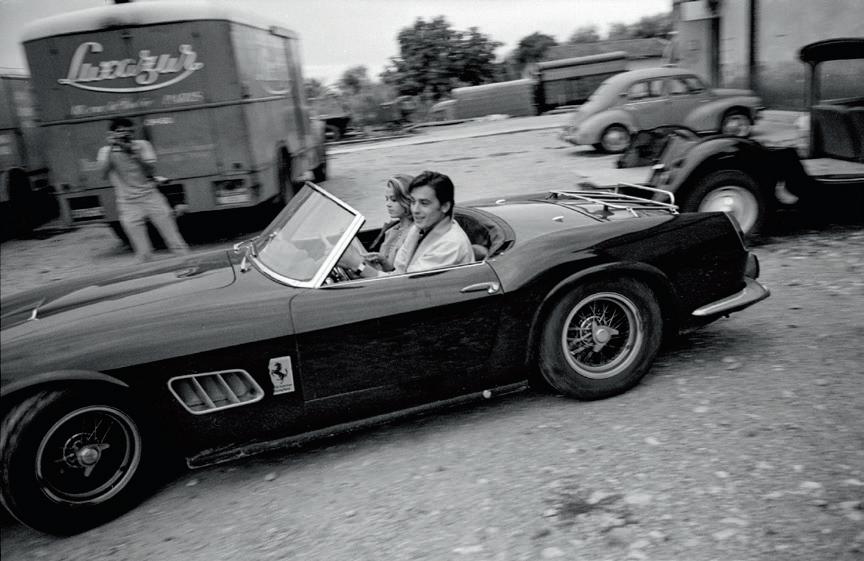
inky blue referred to as Max Meyer Bleu 467 Fiat, a nod to the American importer who’d originally proposed the more luxurious, elegant Ferrari model for the US market. ‘Fiat’ recognises the then-close ties between the two companies, and is not unusual in Ferrari paint names.
In September 1961, 2935 GT was delivered from the factory to Parisian dealership Franco-Britannic Autos (FBA), and shown a month later on the FBA stand at the 48th Paris Motor Show. It was snapped up by Gérard Blain, a French actor who starred in, and later directed, a wealth of French films. Look him up and you’ll learn that he’s best known for Le Beau Serge (1958) and The American Friend (1977), which few of us will know – but he apparently earned enough to be able to keep the Ferrari for 18 months before selling it to his friend and fellow French actor Alain Delon in May 1963.
Now you might not have heard of Blain, but Delon was a big name. He became a genuine French and Hollywood star, whose playboy lifestyle extended not only to his car choice but also to his residence in Monaco. Having narrowly escaped a Paris underworld life of crime, his big break came with his first leading role, in the 1959 film Women are Weak, and he went on to star alongside Shirley MacLaine in British film The Yellow Rolls-Royce and Ann-Margret in Hollywood production Once a Thief, among many others.
His Ferrari – this Ferrari – seems to have played an equally leading role. There are pictures of Delon with then-wife Nathalie alongside
the car, with Jane Fonda in the passenger seat during the filming of 1964 movie Les Félins and with MacLaine in a similar pose while shooting The Yellow Rolls-Royce, also from 1964.
By July 1965 Delon was done with the California Spyder. He consigned it to Michel Maria Urman Automobiles, Paris, only for it to be snapped up within weeks by none other than Paul Bouvot – the director of the Peugeot Styling Centre. It was Bouvot who, perhaps keen to make his mark on the styling, made a few alterations that would impact on the restoration decades later. But before a year was up, he too had sold it, this time to a Canadian, Robert Cooper, in Paris.
And then, in November 1971, the Ferrari moved onto what nearly became its final resting place: what we now refer to as the Baillon Collection. In fact, the California was bought by Jacques Baillon, son of the collector Roger Baillon, in Niort, France.
During the 1950s and ’60s, entrepreneur Roger had amassed a huge collection of cars with the intention of preserving them for posterity in a public museum. When his business took a downturn during the 1970s, however, Baillon’s plans had to be abandoned – and the cars began to fall into disrepair. He was forced to part with at least 50 of them in two sales – one in 1979, the other in 1985 – but he held onto around 90, including the Maserati and the California.
Roger passed away in 1996, yet it was only after Jacques died in 2013 that there was any talk

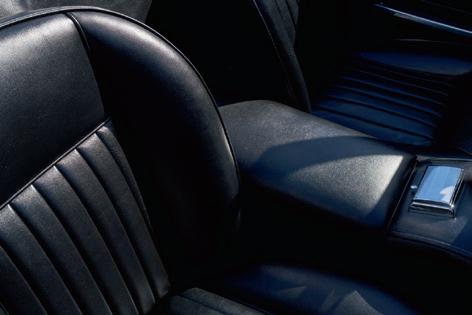
of selling the largely forgotten collection. This led to the dramatic reveal of the vehicles by Artcurial ahead of the big auction, with photographers Matt Howell (for Octane) and Rémi Dargegen (for Classic Driver) being two of only a few who were granted special permission to see the cars in their resting places before they were shipped out for public display in Paris.
The reveal took most of the world by surprise, to the point that there were several who claimed the California was a fake, due to confusion over its identity. But there were also those who asserted that they’d known about the collection – and the Ferrari – for years. Chris Vassilopoulos and his family had become aware of it, largely thanks to broker Simon Kidston.
“We’d been looking for a great California for a while,” explains Chris. “Simon was helping us with it. We actually came across a sister car to 2935 GT, but it didn’t work out. We mentioned to Simon that we would really love a shortchassis, covered-lamp model. That was the dream. We also wanted something unusual with an interesting history, ideally not in red.”
He continues: “We did a lot of research on cars that were out there and what they all did in period. The question was, how do you differentiate between them, and what makes one more special than the other? Through the research, we invariably stumbled upon this car. With Alain Delon’s history, there was an obvious attraction to it; there was loads of photographic evidence of the Ferrari in the South of France, and in Los Angeles, when Delon shipped it out there. Those images were just so iconic.
“We heard whispers about it being in France, somewhere in the countryside. We then heard that the owner of the car had passed away and that his family was thinking of selling it. We generally don’t like buying things at auction or in a very visible manner, but the Baillon family decided to go the public sale route with Artcurial; they were just following the correct process when it came to wrapping up his estate, I believe.
“So we knew by then that the car really did exist, but loads of people, including some well known Ferrari historians, said it didn’t exist any more. And when it was unearthed, there were questions around its authenticity. Was it the real deal? It had been forgotten for so many years.”
The family sent in Ferrari expert and author Keith Bluemel to inspect the car in an underground garage in Paris to verify its authenticity. “He went in there with a flashlight,” says Chris. “He was looking at markings, and chassis numbers and body numbers, and all this kind of thing. It was like something out of a crypt; it was in a really poor way.”
The family discreetly bought the Ferrari and almost immediately sent it to Paul Russell & Company for mechanical recommissioning. It was shown a few months later at Pebble Beach alongside the Baillon Maserati A6G, which had been bought by well known San Diego architect and collector Jonathan Segal.
Of course, it was a big hit there (“People were shocked to see it driving onto the lawn in that wrecked condition,” laughs Chris), but it was even more appreciated in January 2016 at the Cavallino Classic, the ultimate Ferrari
event. There, it was also the subject of a restoration symposium led by Paul Russell himself.
“There was this whole argument about should or shouldn’t it be restored?” says Chris. “Through the research, we had discovered that the paint you could see wasn’t original. It didn’t have its original interior. We believe that Paul Bouvot had removed the original leather trim and replaced it with vinyl because it was more durable. The same applied to the soft-top. He added a zip-out rear screen, which could open to allow more airflow. The story goes that he had been driving along the motorway and the top had blown off at speed, so he wanted to prevent that from happening again.”
From Cavallino, the Ferrari returned to Paul Russell for a full but sympathetic restoration, which is where he takes up the story: “It was interesting, because there was a lot of chatter in the Ferrari community about, ‘Oh, they shouldn’t touch this car. It’s the last unrestored California’, and all of this. And I had to assume that it was all out of great enthusiasm, but it was from people who had never actually laid eyes on the car.”
“A lot of people were very upset and annoyed about the fact that it was just going to be ‘another boiled-sweet restoration’ and how wrong it was to do that,” adds Chris. “I think if it was their car and they had all the information, their opinions may have been different, but it was really cool to see so many people weighing in on what they thought we should do.”
“It was very rusty. The floors were rusted through,” asserts Paul. “The bottom of the door frames were totally perforated. And there were


We deliver expert storage, care and brokerage services for exceptional motorcars and fine art. Whether handling a wonderful road or race car, or a treasured work of art, we offer a highly personal approach formed on trust, discretion and attention to detail. We are here to assist you to protect, enjoy and share the things you value most.
The 250
GT California
Spyder and 1956
Maserati A6G Frua had been stored in the Baillon family chateau’s garage.
many examples such as that of the car really seriously deteriorating. If we had not done anything then, 50 years from now it would be an unrecognisable pile of red iron oxide.
“The other side of it was that the car was in fabulous original condition, having been tucked away for so many years – and having had relatively few owners, there hadn’t been a great opportunity for people to work on it or reinterpret the car. Every last nut and bolt had never been off. A lot of it is special hardware that’s unique to that period of time. All of it was there.”
Paul continues: “We had honestly never worked on a car as untouched as that, which made it a great pleasure. It gave us a map to follow. We preserved all the original hardware and processed it, cleaned it, replated it and put it back on the car.”
The Ferrari had also been repainted more than once, but neither this nor the rust presented problems to Paul’s team, which has seen far worse in similar cars over the years. “It was not difficult, just extensive and deep because of the deterioration of the bodywork,” says Paul. “We looked for areas to find evidence of original finishes; again, in the previous work on the car, it had never been stripped.
“When we took what you might call the flashing inside the door jamb, and then just gently sanded the paint colour off, there were multiple layers underneath. There was a light grey primer, then there was light blue metallic, and then a medium blue, and then a really dark blue. There are many, many layers of paint. It added a little bit more to the idea that this car was an amazing barn find, but was not an original, untouched car. The specific shade of colour that you now see was matched from these layers of paint that we found underneath until we got all the way to the bottom.”
It was a similar story with the interior. The good news was that the original structure of the seats and the natural latex foam beneath the covers was untouched. Had the work been done well? “No,” comes the straightforward answer from Paul. Was it relatively simple to rectify? “Yes, the leather was referenced [in the factory import documentation] as Connolly VM 8500, which is the company’s really common black,” he confirms. The interior, as you’ll see in the photographs, is now exactly as it would have been from the factory.
As for the modified convertible top, the frame had been completely reconfigured, changing the rear bow and adding that zip-out rear

window. “They may have been trying to improve it,” says Paul, “but they changed it considerably. Fortunately we had another California Spyder here to copy, which made our job easier.”
Throughout this, Chris was deeply involved, even travelling to the US to spend two weeks observing and participating in the restoration process. “I had restored a Porsche years before, but I’d never gone into that kind of detail with this kind of car before. We pulled it apart, down to chassis tubes and raw-metal body panels, and took thousands of photographs.”
He continues: “They handed me a piece of the rear bulkhead, and suggested I do some hammer work to it. I spent a couple of hours doing that, and they thanked me for my work – but I think they were just being kind and probably had to redo it all. I also spent time in the engine shop and in the trim shop, which was amazing.”
Chris describes countless examples of Paul Russell & Company’s exceptional attention to detail. One was the detailed analysis of a small section of original leather in order to create a perfect facsimile for the interior; another the repair of the original seat frames and the reintroduction of the original latex seat foam, accompanied by new rubber support bands that were stamped with the original manufacturer’s crest (with a die made by the restoration team) even though they’ll likely never be seen again.
“I asked Paul things such as: ‘Wouldn’t it make sense to line up the screw heads here?’” says Chris. “And he would say no, because in period
they needed to manufacture these cars quickly, they didn’t have time to line screws up. So if you really want to be authentic, that’s how it should be. Looking back now, it was such a privilege and so rewarding to be so close to the whole journey and to see it all come together.”
The completed car had its first public outing at the 2019 Concorso d’Eleganza Villa d’Este. Crucially, it was also the first time Chris and his dad got to properly drive the Ferrari. “We were driving around the Italian lakes; it was amazing, with the sound of the car in those tunnels. Delon had swapped out the factory exhaust to a SNAP competition-style exhaust. So we fitted SNAPs, and they sound brilliant, much more like a competition car from the early 1960s.
“It has a great gearbox; a very deliberate shift, you really feel in control. You’ve got that wonderful thin, wooden steering wheel. The California is very compact, compared to, say, a contemporary car, so you can place it on the road so well, and having the roof off is obviously an experience. So, yes, it’s exquisite to drive.
“The journey with this 250 GT has been exceptional for us, and for me. It’s such an extraordinary privilege to be part of this story. Ownership of cars is really ancillary; what’s important is the moments and experiences that you know come about because of it.”
Thanks to Chris and the Vassilopoulos family, photography location Kiklo Spaces and restorer Paul Russell & Company; more details on those at www.kiklospaces.com and www.paulrussell.com.
Our events, our style and hospitality, our knowledge of the most beautiful roads and the most fascinating places.
We love the scents, colors and flavors of Italy and make them the theme of each of our encounters.


BLAIR BUNTING





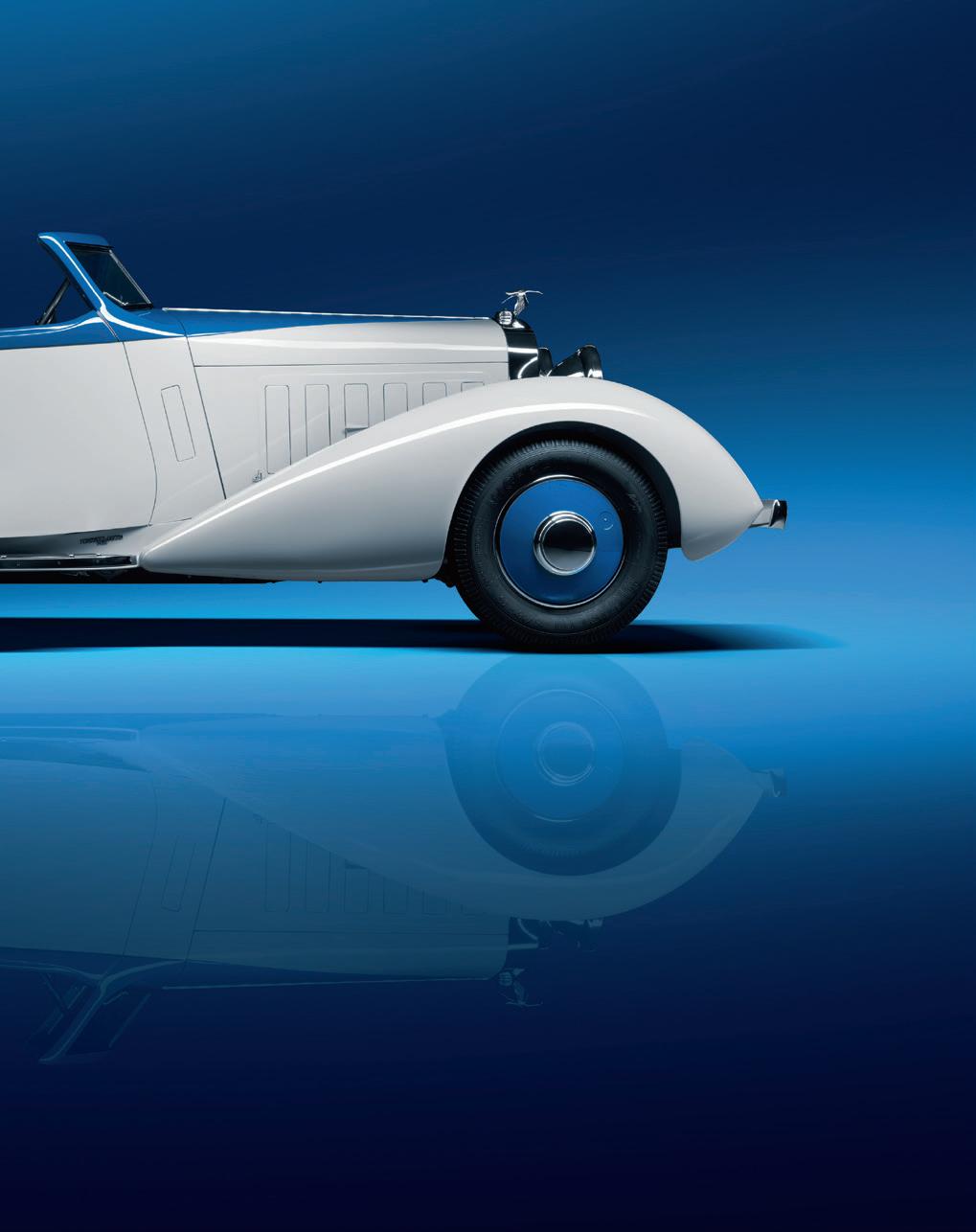

THIS SPREAD
These superlative cars were refined inside and out, as was befitting of the marque of the stork.
THEY CALLED COACHBUILDER HOWARD Darrin ‘Dutch’, but while he may have had plenty of sauce, it wasn’t Hollandaise – it was French. The proverbial American in Paris, he’d been born in Cranford, New Jersey, in 1897. He had been given the nickname by his father, who thought he looked “like a little Dutchman”. Darrin –“garrulous, quarrelsome, self-promoting” – had fallen in love with France when he flew combat missions during the Great War with the Aviation Section of the US Signal Corps, and he would return there in peacetime.
Demobilised and back in America, by 1920 Darrin had founded the nation’s first scheduled airline using half a dozen converted warsurplus Curtiss flying boats to connect Atlantic City to Florida and Nassau. Then he sold out, and paid Walter Chrysler a bargain $1200 for a brace of Delage chassis that Chrysler had bought to study. Dutch subsequently fitted them with rakish sports bodies, sold one to crooner Al Jolson, and decided that the custom body business was both fun and profitable –
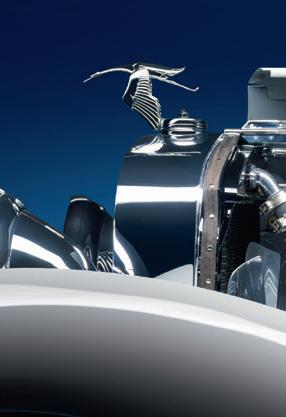


Hispano-Suizas and gave him more time to play polo to boot.
coupé de ville’s V12 was intended for “uninhibited road use”; a sister car achieved nearly 109mph at
Around that time, Darrin befriended Tom Hibbard, designer of stylish coachwork and co-founder of LeBaron Carrossiers with Ray Dietrich. When Paul Ostruk of the Foreign Motor Car Company, the New York agent for the Belgian Minerva marque – ‘The Automobile of Royalty’ – wanted to have bodies built in Europe, Hibbard (who spoke French) and Darrin took a chance and set up as Minerva dealers in Paris in 1923. They rented a showroom on the Rue de Berri, very close to the Champs-Élysées, and used Belgian coachmakers to build bodies to their designs; they later branched out to other luxury chassis and established their own coachworks at Puteaux.
“We did a terrific business,” recalled Darrin. “Paris was a city of opportunity.” Hibbard & Darrin not only sold cars to wealthy clients ranging from movie stars to King Alfonso XIII of

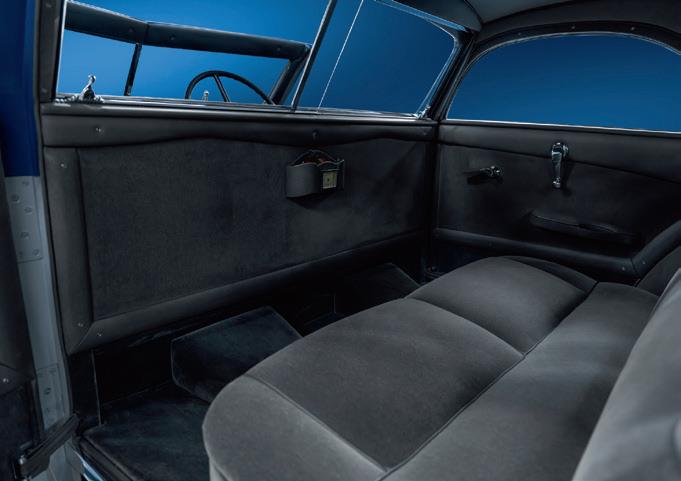
ABOVE Sitting on the ‘long’ K6 chassis, the four-door coupé chauffeur model served for formal town occasions.
Spain, but also acted as a design consultant to companies such as Renault, Stutz and Armstrong Siddeley. In 1931, when the Great Depression hit sales, Tom Hibbard returned to America and joined General Motors, but Dutch Darrin, who enjoyed the Parisian lifestyle too much to leave, stayed in France, where he found a new business partner, one Jean (Gino) Fernandez, a banker from South America who also owned a furniture factory and coachworks at Boulogne-sur-Seine. Darrin recalled him as a “fine man... with wonderful ideas but so many interests that he had not the time to devote to designing custom bodies... We had the most modern factory in France and the most important showroom on the Champs-Élysées”.
In those days, Darrin was living in Chantilly, where his neighbour was Baron Robert de Rothschild of the French branch of the famed banking family. “He had a beautiful polo field,

ABOVE The elegant Streamline Moderne aesthetic exemplified Dutch Darrin’s innate sense of line and proportion.
which he permitted me to walk over with my polo ponies,” Dutch later related.
The Baron’s British cousin Anthony (‘Tony’) Gustav de Rothschild combined his career as an international banker – the world price of gold was fixed daily by his London office, the global headquarters of Rothschild & Company in St Swithin’s Lane – with a highly successful record in horse racing and breeding. Anthony’s passion for exotic luxury automobiles had hitherto been expressed by the ownership of a rakish Gurney Nutting-bodied Rolls-Royce Phantom II Continental Sedanca Drophead Coupé.
However, on March 29, 1934 he commissioned a brace of Hispano-Suizas – a six-cylinder K6 and a V12-engined J12 – from the company’s London concessionaire, J Smith & Company (MA) Limited of Albemarle Street. Smith & Company had only recently taken up the British agency for Hispano-Suiza after many years of selling another of France’s top marques, Delage. Incidentally, it promoted the Hispano range as “super cars”, which was surely the first usage of that now sadly overworked term...
And the 1934 Hispanos – designed by the company’s co-founder, Swiss engineer Marc Birkigt – really were ‘super’ in just about every sense of the word. As The Autocar wrote of the
J12: “Fortunate, indeed, is the motorist who can own one.” That was no understatement, for the price of the J12 chassis alone in 1934 was £2750, over £1000 more than the cost of a complete Rolls-Royce Phantom II limousine.
Introduced in 1931, Birkigt’s J12 masterpiece – built to the highest standards in HispanoSuiza’s factory in the Parisian suburb of BoisColombes – was powered by a 9420cc overheadvalve V12. Just 120 J12 chassis would be built during the model’s seven-year production run, all to be clothed at the customer’s choice with the finest coachwork by top carrosseries. Hispano’s boast that its cars delivered “speed, safety, silence, comfort, elegance” was reflected by the J12’s “altogether exceptional acceleration”, which took it from 0-50mph in 9.6 seconds and propelled it to a top speed of nearly 109mph at Brooklands, which it lapped at over 95mph. Its “superlatively good” servo-assisted braking could bring it to a halt in just 26ft from 30mph.
Its six-cylinder sibling, the 5184cc K6, had been introduced for 1934 to replace the ageing H6 line, which dated back to 1919. Similar in overall dimensions to the J12, but relatively more affordable (for those whose pockets were not quite so deep) while retaining the same impeccable quality, it retailed at £1375 in chassis
A luxurious 14-day driving experience designed exclusively for classic and supercar enthusiasts. From timeless landscapes to luxury retreats, experience a curated driving adventure like no other. Limited to just 15 cars - secure your place now!
From famous alpine passes to medieval towns, we’ve blended stunning landscapes with incredible routes to take in the best Europe has to offer.

EXPLORATION & BEAUTY
Enjoy a mix of iconic sights, experiences & hidden gems through France, Switzerland, Germany, Lichtenstein & northern Italy.
Superb accommodation, with a balance of experience & downtime, this is a refined European road trip designed for comfort and discovery.
BELOW The six-cylinder K6 was regarded as Yvonne de Rothschild’s car – although she purportedly preferred the racier J12.
form and boasted a top speed of 88mph.
Together, the two Hispanos that de Rothschild had chosen represented an expenditure of some £5500 (equivalent to £500,000 today). He and his wife Yvonne commissioned a matched pair of Fernandez & Darrin bodies to clothe those peerless chassis in complementary style: a fourdoor ‘coupé chauffeur’ on the ‘long’ (146.5in) K6 chassis to serve for formal occasions around town, and for the Type 68 J12 a two-door ‘coupé de ville’ that, despite its designation, was intended for “uninhibited road use”.
Their choice of carrosserie was possibly because of the friendship between Anthony’s French cousin and Dutch – or maybe because the couple liked the Parisian chic of Darrin’s designs, such as the two sponson-winged drophead coupés (one for Greta Garbo, the other for Prince Azam Jah of Hyderabad) he had built a year or two earlier on Duesenberg chassis.
The de Rothschilds were, it seems, an ideal couple, and it’s difficult to say whose was the final decision when it came to the look of the two Hispanos. Anthony de Rothschild had met Yvonne Cahen d’Anvers of the Bischoffsheim banking family at a dinner party in February 1926; they shared a love of horses, fine art and motoring. A whirlwind courtship followed, and
they were married that June. The couple shared a profound commitment to public service, especially where their fellow Jews were concerned; in the 1930s Yvonne was president of a society that aided the safe emigration of hundreds of Jewish children from Nazi Germany.
The two Hispanos, delivered a week apart in September 1934, exemplified Dutch Darrin’s innate sense of line and proportion. Their long bonnets stretched almost as far back as their shallow vee windscreens, their sponson wings housed wheels whose spokes were concealed behind chrome discs, their driver’s compartments were open to the sky and their blind rear quarters ensured the maximum privacy for their passengers.
Accent lines dividing the cars’ two-tone –deep blue-black over grey – finish flowed from a peak behind their radiator caps (crowned, of course, by François Bazin’s sculpted stork mascot that honoured Hispano-powered WW1 air ace Georges Guynemer) across the bonnet top and round the sides of the body to meet the rear wings. Instead of running boards there were teardrop-shaped steps, and the rear of their bodies sloped gracefully down to the tail. They were the embodiment of Streamline Moderne.
Both cars were exhibited at the Olympia Motor Exhibition in October 1934. The J12 coupé,
























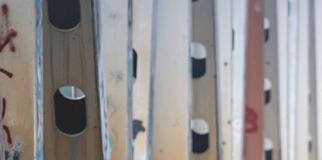



















































































displayed on the stand of J Smith & Company, was considered by The Motor magazine as “most impressive... the lines are so well balanced that it is difficult to realise that the wheelbase is actually 12ft 6in in length”. The K6 was on the stand of Fernandez & Darrin – the firm’s first appearance at the London show – where the car’s streamline body was praised by The Autocar as being “typical of their flair for line”. The Motor was even more effusive, proclaiming that “the sweeping lines, not entirely devoid of flourish, are extremely elegant and afford a pleasant relief from the orthodox treatment of this type of body”.
With her love of fast motoring, it seems that Yvonne de Rothschild was particularly fond of the J12 coupé with its “uninhibited road use”, even though the long-wheelbase K6 coupé was regarded as ‘her car’. After the K6 had been delivered, she summoned Darrin to her London home at 42 Hill Street, Berkeley Square, to discuss the car – but he held back from going for weeks, fearing he would be faced with a litany of minor quibbles from a client he’d not met face to face.
“I finally got trapped in London and had to go see her,” he recalled. “I went, and waited 15 minutes. I had envisioned an old bag – suddenly, descending the staircase, came this young girl dressed in a way that could only be described as an invitation à l’amour. Now this was a woman spelled with a capital ‘W’! I couldn’t envisage a Baroness as being anything this good!”
Sadly, Darrin’s thoughts at that moment were strictly carnal. Those lascivious visions were dispelled by words of praise: “Your work is dear to me,” Yvonne said in her native French.
“What could I say?” recalled Darrin. “I was now on my best behaviour. If she had said: ‘That car of yours – if it rains, I don’t dare use it. I take a taxi,’ I would have grabbed her and said: ‘But your body, sweet lady, is perfect!’”
Perhaps fortunately, that was the last time Dutch Darrin saw Yvonne de Rothschild, although he did try to get in touch with her subsequently, but without success: “She was always in Scotland or somewhere in Paris.”
The Hispanos, however, continued to give the de Rothschilds faithful service for years to come, in London, on the near 50-mile drive to their Ascott estate in Buckinghamshire or, during the horse-racing season, to Palace House, their base in Newmarket, Suffolk.
It was not until 1949 that they chose to part with the J12 coupé, selling it to 31-year-old Alfred James (‘Jimmie’) McAlpine, whose company Sir Alfred McAlpine & Son – it had broken away from the parent Sir Robert McAlpine company in 1940 – confined itself to civil engineering in the northwest of England. While Jimmie McAlpine kept a large private vehicle collection in the

outbuildings of his home, Gerwyn Hall in the village of Marchwiel, Denbighshire, the HispanoSuiza became his – and his chauffeur’s –favourite, and it was often seen at Wrexham Golf Club where he was president.
Frustrated by the J12’s poor rearward vision, Jimmie McAlpine had teardrop-shaped windows inserted in the blind rear quarters; he also had the car refinished in cream and carried out modifications to its boot and bumpers. After his ownership, the J12 eventually found its way into a European collection and was sold at auction in 1983, when it was acquired for the Blackhawk collection of property developer Kenneth Behring. Although Anthony de Rothschild – “a complex and thoughtful man” – had passed away in 1961 and Yvonne in 1977, the Rothschild family must have had a particular affection for the K6 coupé chauffeur, for they were to keep it until July 1984, when it was auctioned at Beaulieu by Christie’s with a claimed 38,958 miles on the clock. In 2004, the pair – both restored to their original condition – were reunited for the Hispano-Suiza anniversary at the 54th Pebble Beach Concours d’Elegance. Since 1991, this pigeon pair have formed part of the collection of the Robert M Lee Trust. This was founded by car and antique arms aficionado,
ABOVE First use of ‘super car’? Regardless, the term was befitting of the model’s high speed and rakish lines.
explorer, conservationist and ‘renaissance man’ Robert M Lee, who died aged 88 in 2016. Today it is managed by his widow, Anne Brockinton Lee. Lee considered himself to be the responsible custodian of remarkable artefacts of history. Cars from his exemplary collection – which is housed in the buildings formerly occupied by the legendary 1200-car trove of casino magnate Bill Harrah in Reno, Nevada – have won a plethora of Best of Show awards in top concours on both sides of the Atlantic, among them Pebble Beach in 2006 and again in 2009, The Quail: A Motorsports Gathering in 2009, 2012, 2018 and 2023, and the Turin Motor Show Concorso in 2016. That’s not to mention their many runners-up awards... The Lee Collection’s Fernandez & Darrin Hispano-Suiza J12 coupé was a well deserved candidate for Best of Show at Pebble Beach in 2014, and as it rolled up the ramp in front of the Pebble Beach clubhouse, it was accompanied – of course – by its six-cylinder sibling.























HISTORIC ROAD RALLY FOR PRE–1985 CLASSIC CARS
HISTORIC ROAD RALLY FOR PRE–1985 CLASSIC CARS








500 MILES IN A LAND OF MEDIEVAL CASTLES, MOUNTAINS AND MYTH
500 MILES IN A LAND OF MEDIEVAL CASTLES, MOUNTAINS AND MYTH


IMPERIAL CONCOURS • PENDERYN PROLOGUE • 20/20 TESTS/REGULARITY BALANCE
IMPERIAL CONCOURS PENDERYN PROLOGUE 20/20 TESTS/REGULARITY BALANCE



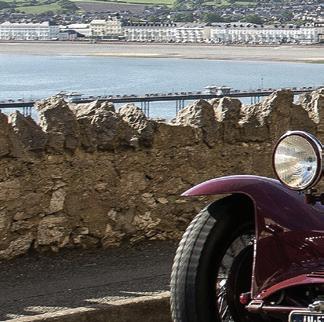









New






THE THREE CASTLES TRAIL
New category open to past entrants: simpler roadbook, no competition. full details and entry information www.three-castles.co.uk INFO@THREE-CASTLES.CO.UK




www.three-castles.co.uk INFO@THREE-CASTLES.CO.UK


GRAHAM
A MOTOR SPORT
. HIS BROAD-MINDED ATTITUDE WAS EQUALLY AS IMPORTANT TO HIS SUCCESS: YOU NAME IT, HE DROVE IT. ALL OF IT


MOTOR SPORT UNDERWENT MANY radical changes in a 20-year period from the mid-1950s. From cigar-shaped cars in British Racing Green to the ‘mobile fag packets’ of Gold Leaf Team Lotus; skinny, treaded tyres to big, fat slicks; streamlining to aerodynamics; and tubular spaceframes to monocoques. Norman Graham Hill saw it – and drove them – all: single-seaters, sports-prototypes/GTs and saloons – often on the same day. Each was fastidiously recorded in his little black book.
Whether it be racing, rallying or recordbreaking, Hill preferred to keep busy. This dated from when he was a relative unknown nursing half a pint at Mayfair’s Steering Wheel Club in the hope of gleaning a useful snippet/contact, or better yet the occasional drive, to when he remained the last of the establishment ‘big names’ still willing to rub tyres with the young thrusters of early 1970s’ Formula 2.
His curriculum vitesse was bewildering as a result: front-, mid-, rear- and even twin-engined (a mud-plugging Mini Moke); inline, vee and flat; air- and water-cooled; fours, sixes, eights and 12s, plus half-litre singles, an H16 and whistling turbines from Rover and Pratt & Whitney; 1.0litre ‘screamers’ to 5.0-litre ‘big-bangers’; front-, rear- and four-wheel drive; shaft or chain; lowdrag to ‘skyscraper’ high wings; four-, five- and six-speed gearboxes; positive-stop sequential, pre-selector or H-pattern.
He maxed them all on ovals, street circuits
OPPOSITE Hill even drove at Indy; an eventual win there complemented his victories in F1 and at Le Mans to make him the only driver ever to take the legendary Triple Crown of Motor Sport.
ILLUSTRATION
RICARDO SANTOS


OPPOSITE
Rallying satisfied Graham’s need for speed during the winter; his Rapier helped the Rootes Group to win the Team Prize in the 1962 Monte Carlo event.
in 1955, he had agreed to prepare and service a Jaguar C-type for Romanian-born, Kensingtonbased adventurer/wheeler-dealer Dan Margulies, on the promise of a drive or two: he spun it at Castle Combe, then co-driving Margulies backed it into a wall during the ten-hour night race on Sicily’s Messina street circuit. Between times, Hill had acted as its riding mechanic in a there-and-back blat along the length of Sardinia. There being no passenger aero screen, he was thankful for the goggles and helmet (made of compressed cardboard) that he had bought in a Cagliari cycle shop.
His enthusiasm was plain to see. The more discerning spotted the determination, efficiency and sangfroid underpinning it. Motor Sport magazine’s influential continental correspondent, Denis Jenkinson, did not yet know the name of Team Lotus’ refueller – Hill’s role as reserve
Hill and road courses, over mountain passes and through forests, on every continent bar Antarctica: from Morocco’s Ain-Diab to South Africa’s East London and Westmead; at Lakeside in Queensland and Riverside in California; at Interlagos and Laguna Seca; up Prescott and Shelsley Walsh; from Albi to Fuji; around the Nürburgring’s Nord- and Sudschleife; at Buenos Aires and on the salt flats of Bonneville; at Brands Hatch in Kent and Kent in Washington state; at Nordic Karlskoga, Kinnekulle Ring and Keimola; and at Zandvoort, Zeltweg and Zolder. He was quick in anything – not just Lotus, BRM and Brabham, or Ferrari and Porsche –anytime, anywhere. He drove a 4.7-litre V8 Ford Falcon Sprint – “Into a mountain,” admittedly –on the 1964 Monte Carlo Rally; put a ‘supercharged’ 1600cc Escort TC – a Smiths electric motor blowing air into its fuelinjection trumpets – on pole for the Oulton Park round of the 1968 British Saloon Car Championship; and won a six-hour heat in a 3.0-litre V6 Capri RS2600 – its onboard TV camera transmitting through a whippy, roofmounted aerial – at Paul Ricard’s 1971 European Touring Car Championship meeting. When he had despaired of landing a Works seat at Lotus – latecomer Hill was too useful to boss Colin Chapman as a mechanic – he signed for Twickenham’s John Willment in August 1957. Although the plan to build and then pilot a Formula 2 car failed – it never turned a wheel in anger – Hill nevertheless enjoyed his first fully professional drive; he was on the verge of victory in the BRSCC’s National 1500cc Championship race at Bank Holiday Brands Hatch when the superior Lotus of Chapman, recovering from a spin, swept past Willment’s eponymous sports car. Duly noted.
Hill had tried everything and all sorts that season to prove himself: an ageing sit-up-andbeg F2 Connaught that stalled on the grid for Goodwood’s Lavant Cup; an Aston Martin DB3S sports car that frightened him silly until it was discovered that its front shock absorbers had been refitted empty of oil; and the Jaguarengined sports car of the two Johns – Ogier of Essex Racing, and the Portuguese-born Tojeiro – that shed a front wheel at Brands.
At least he was driving regularly by now. Back
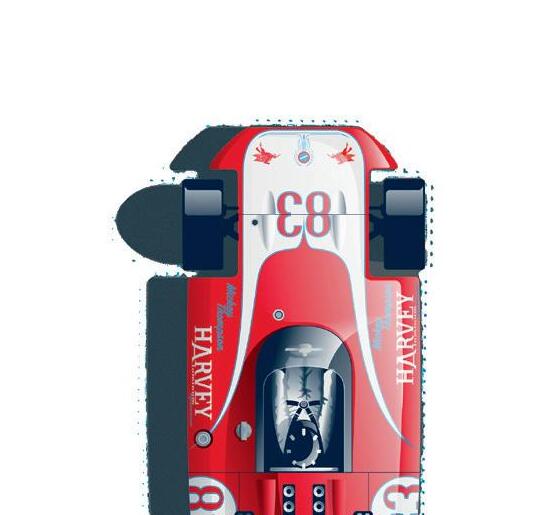
driver at Le Mans in 1957 was secondary – but he was hugely impressed by his unhurried accuracy.
Chapman finally caved after Hill drove a Works F2 Cooper – and was paid £100 for doing so – in September’s BRDC International Trophy at Silverstone. Although he finished 13th after spinning, Graham’s moxie in attempting to unlap himself from team/category leader Roy Salvadori was compelling.
A £1000 retainer, however, was no sinecure, although sufficient for Hill to buy his first new road car: an Austin A35. A share of the prize money helped – he would win in Lotus’ Seven, Eleven, 15, 16 (the only single-seater of this bunch) and 17 – but diversification was vital if he wanted to look after number one.
A £25 share in Speedwell Performance
Conversions of London’s Golders Green saw him hooning around Silverstone in an A35 – his
event for them, a two-hour/two-driver affair at a grisly RAF Lakenheath in November 1959. Another display of unbridled enthusiasm. Rallying helped fill his winter hunger gaps, too. He steered a Riley 1.5 and a Ford Anglia 105E in the Monte Carlo Rallies of 1958 and 1960, albeit without luck or success, and helped the Rootes Group to win the Team Prize of 1962 by finishing tenth overall in a Sunbeam Rapier. His 1959 RAC Rally performance as a late replacement in a Ford Zephyr warranted better than his eventual 49th position – he was fastest in class on six of the special stages – but penalties accrued during a delay stuck behind a crashed team-mate on a road section could not be overcome.
Oddball for-TV events were another offseason option during the 1960s: Hill hurled a Monte Falcon up and down Prescott Hill Climb and its return road in 1964, finishing ninth in a

a week spent at Goodwood putting 10,469 miles on an Anglia by way of a publicity stunt.
Stirling Moss paid Hill the ultimate compliment by selecting him as his long-distance wingman for 1961. They co-drove a Maserati T61 ‘Birdcage’ at Sebring – its exhaust manifold broke during Hill’s first stint – and would have won the Targa Florio for Porsche, and the GT class at Le Mans, in a Ferrari 250 GT SWB bedecked in Rob Walker’s colours, but for, respectively, a shattered differential on the final lap and a radiator pierced by a sheared coolingfan blade. They led a snow-hit Nürburgring 1000km, too, before retiring because of engine failure; after which they commandeered a Porsche 356B Carrera coupé and won its class.
Hill should have won the Sebring 12 Hours of 1960 and 1962, too. On the first occasion, he and (his most regular) co-driver Jo Bonnier made a late switch of Porsche 718 RS60 due to a suspected slipping clutch in practice. Their replacement blew its engine at mid-distance, while the car they had rejected won by nine laps. On the second occasion, Hill ricked his back helping to unload tyres and had to cede to Lucien Bianchi, who helped Bonnier to win by ten laps in Scuderia SSS Repubblica di Venezia’s front-engined 3.0-litre V12 Ferrari 250 TRI/61.
Hill would, of course, win at Le Mans. Eventually. In an all-singing-and-dancing (mainly
BELOW For the 1964 Monte Carlo Rally, Hill drove a 4.7-litre V8 Ford Falcon Sprint – albeit “into a mountain...”.
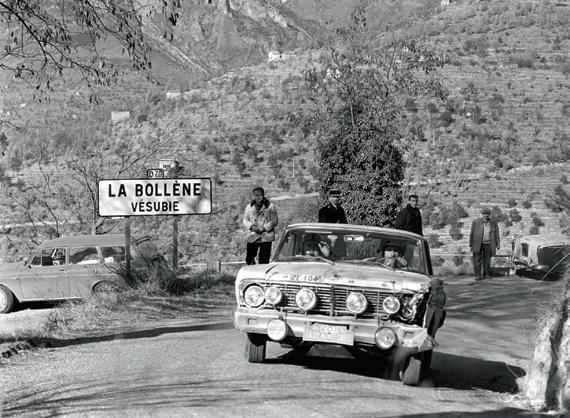



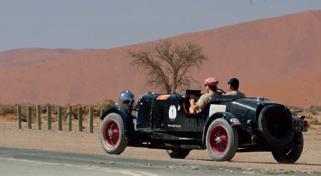

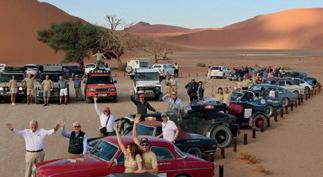


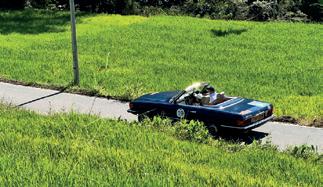



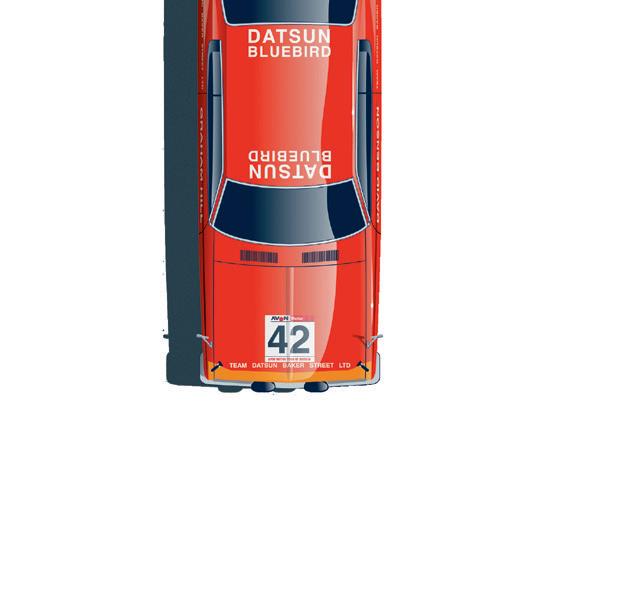
LEFT Hill would famously drive absolutely anything – including this motorised bathtub at Brands Hatch, Kent in 1961.
singing) 3.0-litre V12 Matra MS670 in 1972. Adding this to his brace of F1 world titles and an Indianapolis 500 win to complete a unique Triple Crown. He had, though, already led briefly from its previous run-and-jump starts – despite a left leg bandied and shortened by a motorcycle crash of the late 1940s: in 1962, aboard Aston Martin’s handsome Project 212, a slippery 4.0-litre straightsix front-engined GT coupé; and in 1966, in Alan Mann Racing’s 7.0-litre V8 mid-engined Ford GT MkII. Both of these attempts ended in mechanical failures, but Hill did finish second in 1964, in a privateer Ferrari 330 P co-driven by Bonnier.
His outings at La Sarthe in the turbine car built by BRM for Rover – in open-topped form in 1963, and as a coupé in 1965 – were diverting rather than competitive. An early off into the ‘safety’ sandbanks damaged its engine’s cooling system on the latter occasion, forcing a reduction in performance that saw it overtaken by a Triumph Spitfire on the Mulsanne Straight. Codriven by Jackie Stewart, the turbine car was, however, the first British machine home: tenth.
The four-wheel-drive Lotus 56 turbine of 1968 was a much more serious contender, at Indianapolis. Hill wedged this futuristic ‘wedge’ in the middle of the front row – at 171.208mph – and started as the clear favourite. Maintaining a conservative pace, as he had in victory in 1966, he was holding fourth place when a front
wheel broke free; he hopped from the resultant wreckage to retrieve it from down in the ‘groove’. That sangfroid again.
His Indianapolis win, in a 4.2-litre V8 Lola T90-Ford, had been secured as a rookie – the first to do so for 38 years – with likely fewer than 50 practice laps behind him. (Hill was a late replacement at Mecom Racing for Walt Hansgen, mortally injured testing a Ford GT at Le Mans.)
But this was not his first experience of The Brickyard. In 1963, he had walked away from the “diabolical” saucer-shaped, tiny-tyred, Chevyengined ‘roller skate’ built by Mickey Thompson – part genius, part snake-oil salesman – when another fleeing wheel flicked him into the wall during practice. Hill knew where and when to draw the line. In 1964, he would refuse to drive Alpine’s Renault-engined F2 car at the Pau Grand Prix because it was clearly unfit.
Nor was the Lotus turbine his first experience of total traction, aforementioned Twini Moke notwithstanding. In 1963, he drove the Ferguson P99 for Walker’s team in three rounds of the Down Under series, soon to be codified as the Tasman Cup. (A much more clement way of bypassing a gloomy UK winter.) Its front-mounted Climax ‘four’ augmented to 2.5 litres for this campaign, and featuring Dunlop’s Maxaret antilock braking system, the car proved hot and bothersome work. When at last the rain came,
at Lakeside in February, it proved unable to make the anticipated gains – on dry tyres, admittedly – and Hill had to settle for a distant second place. In the days before the unseen hand of downforce increased its steadying – some would say insidious – grip on the sport, four-wheel drive was the Holy Grail. Hill’s second-fastest time in practice for Mosport’s Telegram Trophy IndyCar race of June 1968 – he crashed irreparably on an oil slick minutes later – was the false dawn that persuaded Chapman to persist with the technology, sometimes in conjunction with unresponsive turbines, on road courses for longer than he ought.
Hill’s second spell at Lotus was not only more financially rewarding, thanks to Ford’s wish to create a ‘superteam’ alongside the peerless Jim Clark – plus, the sponsorship genie had been released when the paddock gates of Queensland’s Surfers Paradise were grudgingly opened to allow their Lotus ‘fag packets’ to race in February 1968 – but it was also indicative of an increasingly strictured/structured sport.
Hill was still busy, busy with F1, F2, IndyCars, Tasman and saloons. Yet the days of packing his racing kit for a trip to The Bahamas purely on the off-chance – an uncompetitive MercedesBenz 300 SL ‘Gullwing’ in the 1960 Nassau Tourist Trophy, as it turned out – had gone. Only once during the three seasons from 1967 did


For the third year in a row CKL has won a class trophy from the world’s most prestigious and hotly contested concours, Pebble Beach. This 1953 Jaguar C-type - Chassis number XKC 044 - was awarded the second-in-class trophy in the extremely competitive ‘Post War Sports Racing’ Class
he drive anything that wasn’t Lotus- or Fordrelated: a Works Porsche 910/8 sports-prototype, in which he was faster than co-driver Jochen Rindt before retiring from July 1967’s Brands Hatch six-hour race because of a dropped valve. Even the Cannon trials car that he shared with Chapman “with some gusto” in the March of that same year boasted an engine from the Blue Oval. The same held in 1970, even though Hill was no longer a Works driver.
On-a-handshake privateer teams such as Walker’s were waning. Tommy Sopwith’s Equipe Endeavour, for which Hill had won on the Jaguar E-type’s racing debut, at Oulton Park in April 1961, had long since gone. Colonel Ronnie Hoare’s Maranello Concessionaires, whose Ferraris – 250 GTO/64, 330 P and 250 LM – Hill had guided to victory in Goodwood’s Sussex Cup and RAC Tourist Trophy, Montlhéry’s Paris 1000km and the Reims 12 Hours in 1964, was enduring a long lull. And John Coombs’ Guildford-based outfit, for which Hill had become the getaway driver’s getaway driver in Jaguar Mk2 3.8s from 1962-63 – and had also won in its original ‘Lightweight’ E, ‘big-banger’ McLaren-Elva Mk1-Oldsmobile, and F2 Cooper and Brabham – bucked the trend until 1973.
Forty-something Hill was beginning to look like a relic, too, the last link to the past as a foreign country – “…they do things differently
there”. Although he was admired now more than ever because of his fortitude in overcoming severe leg injuries sustained in a tumbling crash at the 1969 GP of the United States, he was deemed neither still on the ultimate pace nor in the highest demand.
Yet he would win again in F1 – the two-heat International Trophy of 1971 – and in F2, for Ron Dennis’ fledgling Rondel Racing. On both occasions he drove Brabhams. And Henri Pescarolo, his initially doubtful 1972 Le Mans co-driver, would happily admit his amazement at Hill’s unflinching commitment, as the sun set, the rain fell and the mist descended.
Hill, in turn, would have to admit that he underestimated the demands of creating at short notice his very own single-car Formula 1 team in 1973. These pressures allowed him fewer opportunities elsewhere: a Matra at the old Spa, with its throwback 160mph lap between ditches, trees, telegraph posts and houses, and a somewhat less glamorous and over-matched Datsun 180B SSS in the Avon Tour of Britain. He had to hand over the former to Pescarolo, who went on to set the old Spa’s forever-fastest race lap, and to finish in 17th position in the latter.
Although Hill’s team was running two cars in F1 by 1974, he somehow found the time and headspace to contest the International Race of
Champions – a dozen of America and Europe’s best of the best in identical Chevy Camaros, on ovals and a road course – as well as to assist Hollywood A-lister Paul Newman in setting international speed records at Utah’s Bonneville in Ferraris 365 GTB/4 and 512 M. Just ‘bits of fun’, such as the three-lap, all-Mini demonic ‘demo’ that he won by mere feet at the 1960 British GP, and the bumper-to-bumper thumper in matching Austin 1100s that he lost by mere feet at Snetterton in 1962 – but all no doubt noted in that little black book.
Time was catching up, albeit not as quickly as cruel fate. Hill glimpsed his future in the young Tony Brise, rocketing through the field of Monaco’s Formula 3 race of 1975, and struck a deal with him on the very day that ‘Mr Monaco’ himself failed to qualify for the first time in his then-record 176-Grands Prix career.
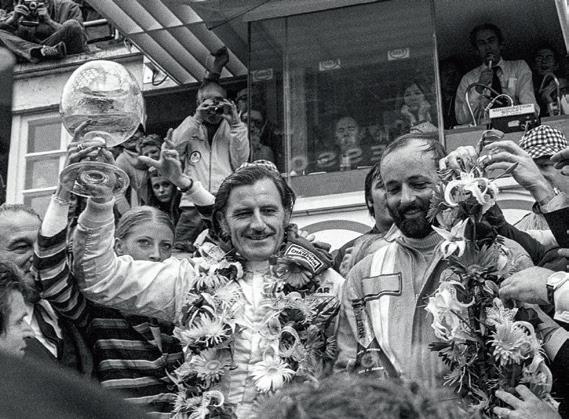



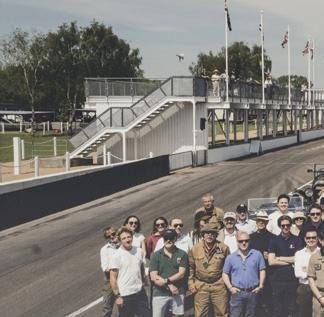




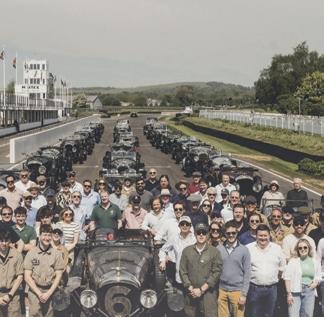
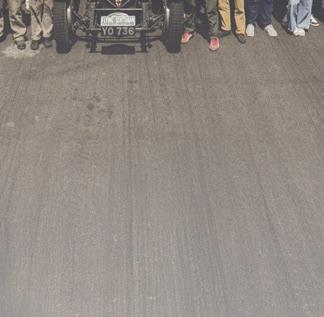


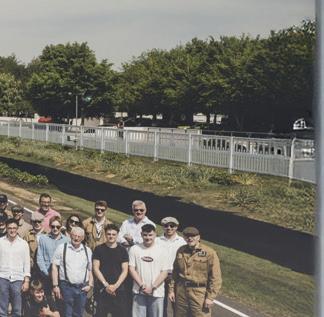
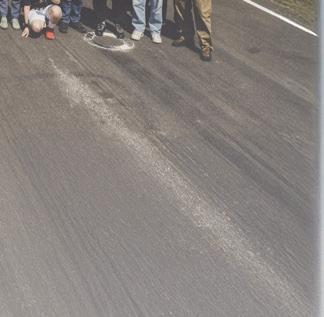




IT LOOKS AS THOUGH IT HAS CRASHlanded from another planet. It is possibly the greatest car ever made… if you’re ten years old. Everything about this machine was seemingly crafted to excite pre-shavers. The Aztec sci-fi throwback was created by Giorgetto Giugiaro, a man not usually given to acts of whimsy. It was a birthday present to himself, or rather to the company he co-founded. Oh, and just to heighten the weirdness quota, it initially wore Audi logos – but Lancia content was rife thereafter. And the best bit? Il Maestro conceived the car while he was barely out of his teens. It’s just that realising his ambition took him three decades.
While envisioned as a one-off show queen, it ultimately spawned a big-money production car, although ‘production’ is a relative term. The Aztec was built to honour the 20th anniversary of Italdesign, and it was first seen at the Turin Motor Show in April 1988. It shared stand space with the fixed-head Aspid coupé and the one-box, 6+2 Asgard people carrier, with each ostensibly



ABOVE Access to the divided cockpit is via conventional doors and rather less conventional gullwing cowl sections. There were never two steering wheels – it was a clever design illusion.

Italdesign Aztec sharing the same platform and lower body panels. The Aztec represented Giugiaro’s vision of how the two-seater roadster would evolve over the next half a century or so. Also, distinct from its stablemates, this prototype was a runner.
Giorgetto looked to the past to project the future. In a roundabout way, the Aztec was inspired by the General Motors Firebird III from 1958. The great man had been a big fan of this ‘jet-set’ concept car as a young pup. Shortly thereafter, he mapped out his ideas for a midengined two-seater that similarly employed a dual-cowl arrangement. However, they were put to one side after the wunderkind began his design odyssey with Bertone in 1959. That said, you could argue that these renderings influenced the Chevrolet Corvair Monza-based Testudo concept car that was built four years later, but in watered-down form. The full-on flight of fantasy would have to wait a while.
The irony is that Giugiaro has claimed in


umpteen interviews, some with members of this parish, that he grew to dislike quirky concept cars; those and exotica in general. The 1970s in particular saw him embrace the rational and revel in the mainstream. All of which made the arrival of the Aztec all the more improbable given that he was by now comfortably into middle age. But then it was built as a means of celebrating a milestone birthday, so he had an excuse to let his hair down. Reaction following the big reveal was mixed, though. Road & Track, for example, said: “The next century is but 12 years away, and Giugiaro wants a piece of it.”
Rival artistes were divided. Citroën’s former styling chief Carl Olsen told Autocar & Motor: “I can’t really tell where Giugiaro is going from this. I don’t think it’s his best work.” GM’s design czar Chuck Jordan disagreed, telling the same title: “What I saw on the stand this morning was the best work he’s done since the Medusa [concept
ABOVE Analogue technology is utterly and delightfully of its time. Thunderbirds are go indeed...
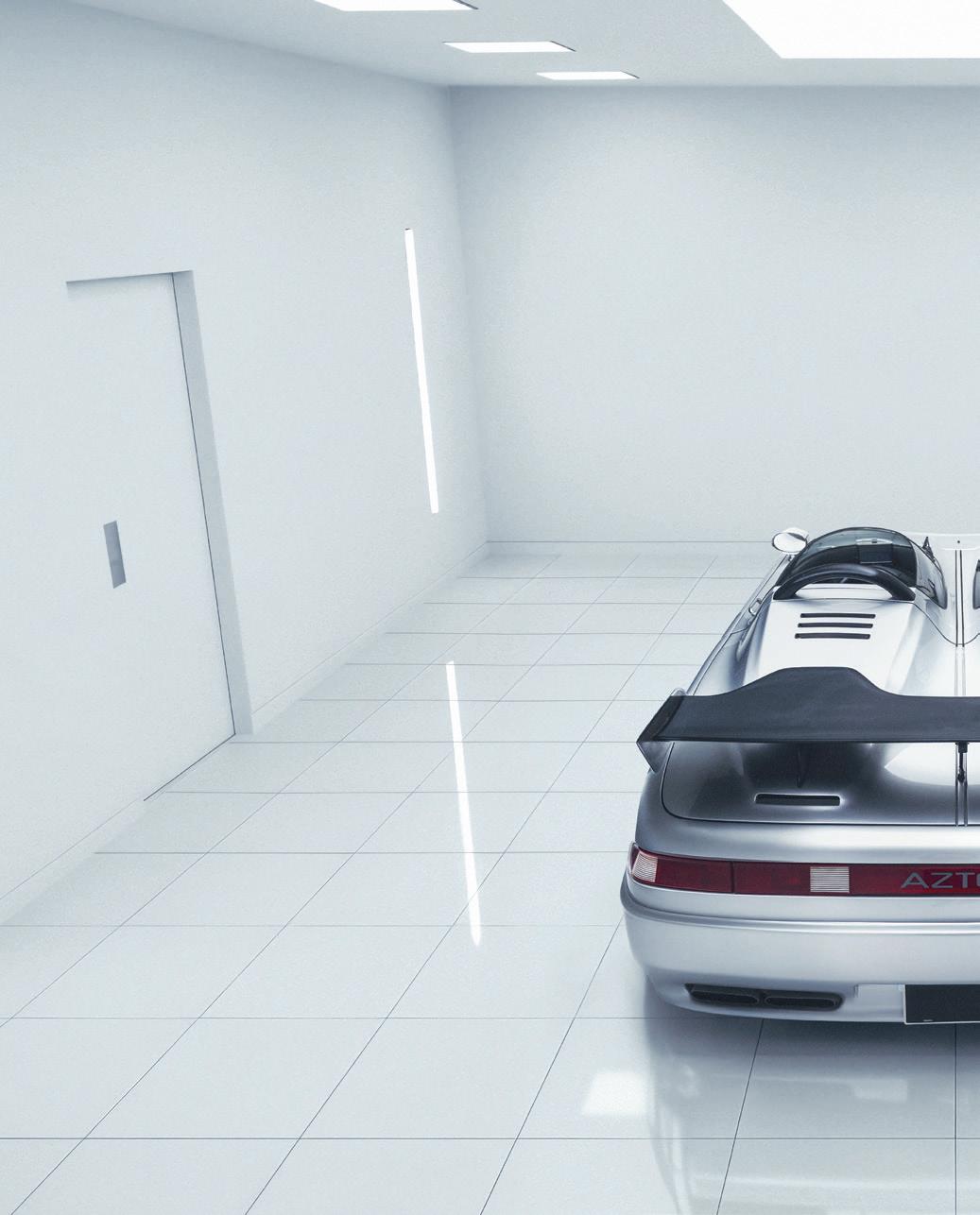

car] in 1980.” A circumspect Peter Stevens, meanwhile, said: “Anything by Giugiaro has to be taken seriously.” And so on. It is safe to say that the Aztec polarised opinion – but then show us a concept car worth its salt that doesn’t.
The Aztec featured a five-cylinder unit from an Audi 200 Turbo that was sited amidships. Nevertheless, the link between Italdesign and the German marque was a mite hazy. Audi donated engines to Italdesign, but it was hard to discern whether there was any official backing beyond that. Giugiaro cryptically told a media scrum that the Aztec and its more ‘sensible’ siblings were mere calling cards. “They are here because we need to reach out and find new business and new clients,” he insisted. “For sure, they use Audi engines, but we are looking for production possibilities elsewhere. It is not good for a styling studio to be tied to one manufacturer; your designs can be tied to that link.”
The truth is, there had never been any intention of the Aztec being made in series. It would have become just another show car lost to history had it not been for Mario Myakawa. This Japanese tycoon was so taken with the Aztec that his Compact concern adopted the design. He acquired rights to the project for an undisclosed sum, and there was bold talk of 200 replicas being made, each priced at a whopping £225,000 ($300,000) apiece. There was just the small matter of where they were to be made, and by whom – given that Compact
didn’t have any manufacturing facilities at all.
Giugiaro and his business partner, engineer Aldo Mantovani, created Italdesign (né Studi Italiani Realizzazione Prototipi) in 1968, and they decided early on not to construct cars in volume. They relented only once, and even then it was by proxy and under duress. Back in the late 1970s, Lamborghini had been engaged to build the Giugiaro-penned BMW M1 in series. However, the marque was teetering on the edge of oblivion at the time, so it fell to Italdesign to rescue the project. Giorgetto and his team roped in umpteen subcontractors to keep the dream alive, and the stress of herding so many cats left a mark. Giugiaro wasn’t about to endure a repeat performance.
As such, he recommended Savio. This storied Turinese outfit had been in existence since 1919, and it was reasonably well known for its coachbuilt offerings and own-brand utility vehicles during the 1960s and ’70s. The 1980s saw it stick mostly to fashioning ambulances and armouring saloon cars for the Italian judiciary. That, and building prototypes for Fiat and creating bodyshells for small-run offerings such as the Lancia Delta S4 Group B rally car. It was tasked with refining the Aztec for a production run, which was no easy task.
According to most period reports, the Italdesign prototype employed an Audi Quattro four-wheel-drive system, although in hindsight this is debatable (the set-up may have been something a bit more rudimentary, given the

packaging requirements). The ‘production’ version, by contrast, was a mash-up. The chassis/ platform and attendant running gear came from a Lancia Delta HF Integrale, the floorpan being reconfigured accordingly. Incomplete cars were then shipped to the MTM tuning house in Germany, where 250bhp 2.2-litre Audi units were mated to the Italian underpinnings, the engines being mounted transversely.
MTM was also responsible for homologating the Aztec for road use (having said which, it was dubbed the AZ Tech in Japan because ‘Aztec’ was already taken). The transformation from concept car to production reality took an age, although there was a promotional boost of a kind after the original prototype appeared in 1990 timetravelling monster epic Frankenstein Unbound starring John Hurt and, bizarrely, rock god Michael Hutchence. An Aztec also acted as the course car during the 1991 Monaco Grand Prix, by which time Compact had decided to make just 50 examples and price them north of £375,000 ($500,000).
However, the scheme gradually unravelled to the point that the Aztec was quietly killed off a year later. As to the vexed question of how many cars were made, the consensus appears to be 18 – not including the original prototype, which was retired to the Italdesign factory museum. A few sources insist the final number was closer to 12 but, either way, it’s a rare beast. VIN 001, [currently owned by P1 Exotics] is on display until May 2026 as part of the Totally Awesome! exhibition
LEFT The Asgard, Aztec and Aspid were built for the 1988 Turin show, to mark Italdesign’s 20th anniversary. They ostensibly shared the same platform and lower body panels.

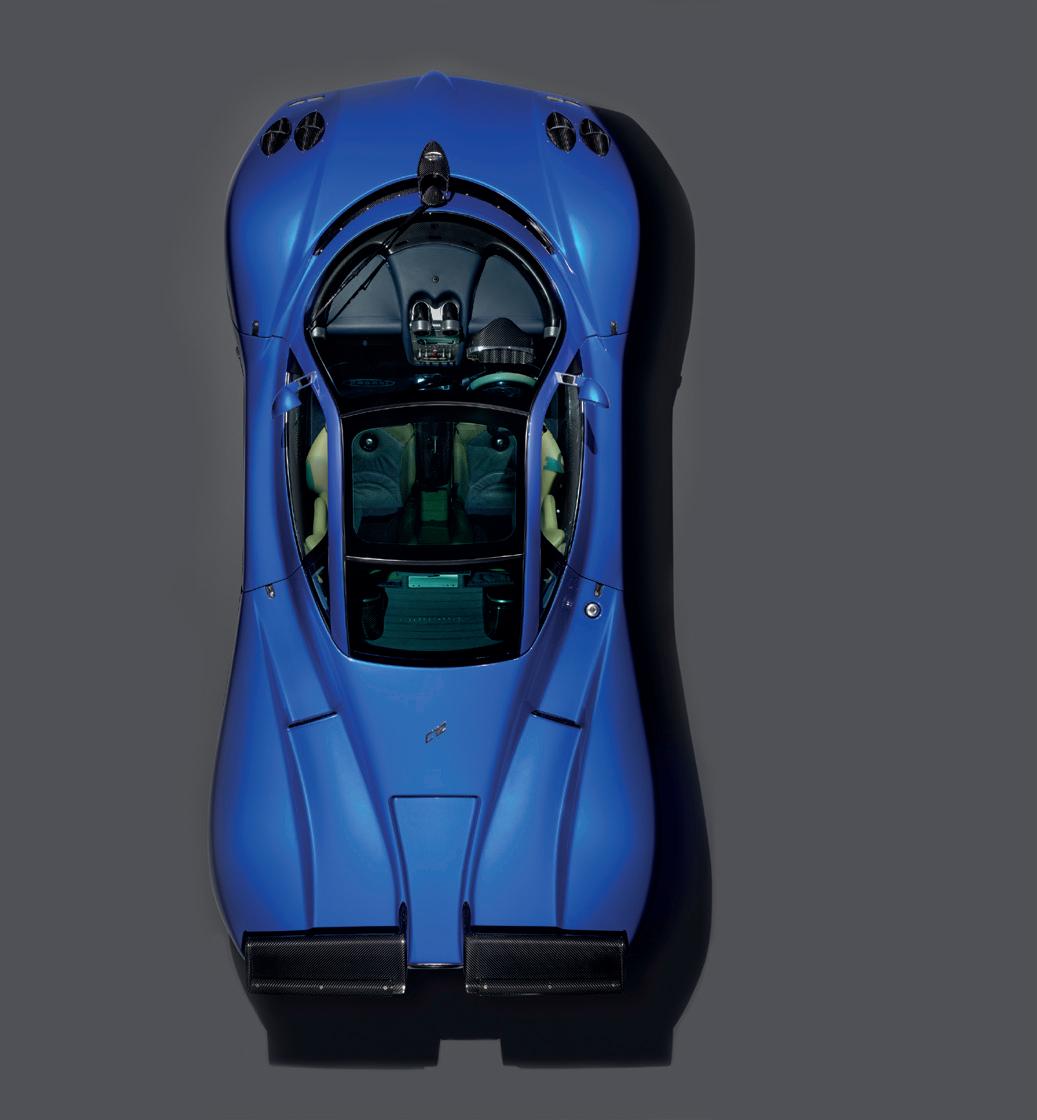


RIGHT An improbable production future awaited this flight of fancy; depending on what source you believe, somewhere between 12 and 18 examples were eventually built.

at the Petersen Automotive Museum. What’s clear is that the Aztec hasn’t lost the power to shock, not least because the styling wasn’t diluted during the transition from concept car to production reality. Of course, some might argue that this may not necessarily have been a good thing. It rather depends on your aesthetic sensibilities – but even the most stone-hearted of design pseuds will crack a smile on first contact. It’s impossible not to. The Aztec tickles your inner child. There was nothing else like it 37 years ago, and it remains awesome today in the old-fashioned sense of the word. It’s just so… crazy. That said, the nose appears almost conventional and the pop-up headlights anchor it to the 1980s. Once engaged, they rise vertically with an air of theatricality. You half expect to hear the theme music from Thunderbirds.
Cooling outlets are sunk into the front valance to funnel air to the canted, front-sited radiator, while swage lines run from the bonnet and around the cockpit sides before emerging into the finely chiselled rear deck. There’s a neat – or merely loopy – detail wherever you look, not least the tinted Perspex elements sunk into the doors. They also serve as openings for the engine cooling vents. The curved cabin cowls, meanwhile, were supplied with glazed domes. They attach by means of fiddly clips and are a bugger to align properly. Then there are the rear spats, not forgetting the external gauges, buttons and general randomness (surely every car should
have a manometer and a removable thermometer). You cannot help but marvel at the fact that there is an external gauge that measures the efficiency of the engine’s air filter. That, and wonder why the decals claim it has racer-style air-jacks (it doesn’t). Oh, and try to make sense of the operating commands that are written down the rear flanks (your life won’t be complete without knowing what ‘Bolt Driver – 233’ means). According to the original press pack, such ‘service centre’ instructions were operated via a keypad. Type in a triple-digit combination and the, er, ‘functions’ became functional. Except they didn’t, or don’t. This was more flimflam.
The Aztec isn’t the easiest of cars to get into, either – but then, you would be amazed were it otherwise. The driver’s door opens only a few centimetres, which in turn releases the locking mechanism for the gullwing cowl section. You then need to push up the top section, which is assisted by a hydraulic ram, before next swinging the door open fully. It isn’t the most intuitive means of ingress – you don’t know what you don’t know – but it stops being a palaver once you have received proper instructions. There is only one way of doing it properly. All others will end with something breaking, most likely your fingers. On having threaded your way into the Aztec, and then returned the door and canopy to their closed positions, there is an odd feeling of familiarity and foreignness. The first thing that strikes you is the car’s girth, something that was
much commented on when the Aztec was first seen in 1988, much to Giugiaro’s chagrin. At 1981mm (78in) across it’s almost as wide as a Ferrari Testarossa from the same period. The sense of enormity is amplified by the dividing strip between the cockpit nacelles. It is at neck level because you sit so low. As such, the Aztec seems to be all bodywork once you’re in situ.
The driver’s area itself is oddly disappointing, though, because the orange-on-black instruments and the Clarion stereo seem so, well, normal. Contrary to what has often been written about the Aztec, it doesn’t have two steering wheels. It’s just an illusion. The ‘wheel’ on the passenger side is there for the sake of symmetry and, up close, it’s merely a half a wheel that acts as a grab rail. There is a half a metre (two feet) between occupants, but it feels concurrently spacious and claustrophobic without the ‘bubble-tops’ in place, which is perhaps the least strange aspect of the Aztec.
Nothing dates so quickly as a vision of the future – but who cares? There’s romance at play here. From the driver’s seat, it’s hard not to idly daydream of Syd Mead-esque cityscapes; of some new world predicted in a pulp novel a long time ago. You may even (invariably will) find yourself uttering a line from a popular movie or two (“Where we’re going, we won’t need roads,” is a dead cert). That’s the beauty of the Aztec. It transports you, even while stationary. Thank you to the Petersen Automotive Museum. Find out more at www.petersen.org.




ERCOLE SPADA
1937 – 2025

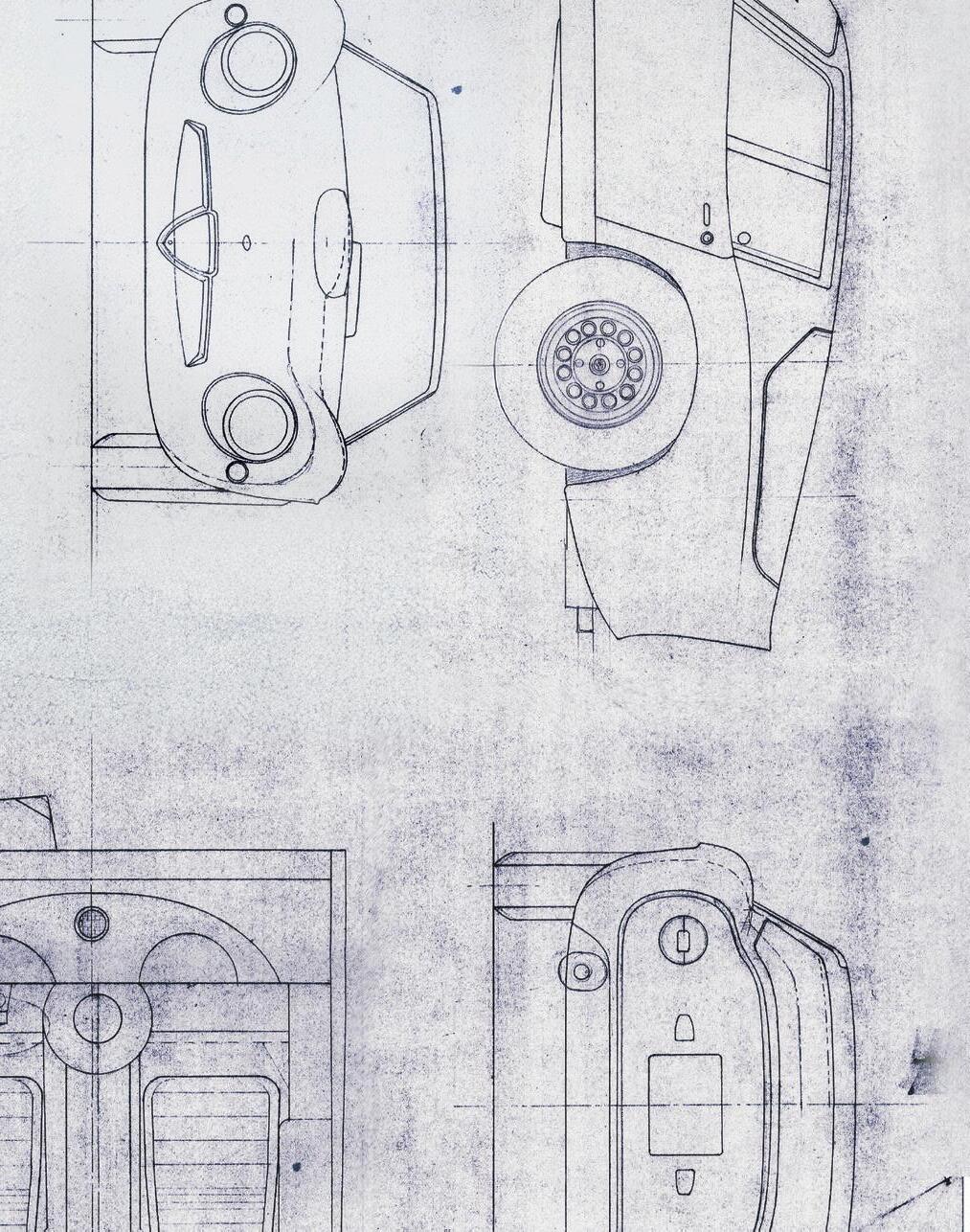
AUTOMOTIVE LEGEND ERCOLE SPADA – FATHER OF SUCH ICONIC MACHINERY
AS THE ASTON MARTIN DB4 GT ZAGATO, ALFA ROMEO GIULIETTA TZ AND BMW
5-SERIES E34 – PASSED AWAY IN AUGUST
2025. THE WORLD LOST A BEAUTIFUL, COMPLEX MAN WHO MAINLY LET HIS DESIGNS DO THE TALKING

“L’IDEA ERA…” “THE IDEA WAS…” EACH time someone asked about the ins and outs of his work, Ercole Spada balanced the answer in his aristocratic, almost sculpted head – always for longer than was comfortable, as if he’d never before given it any thought. Obviously, he had. Ercole wasn’t a stylist. He was a genuine designer who always started from an elaborate concept. Italian car designers are all smooth operators, they say – dandies making wind, flapping hands a l’Italiana, swimming in self-confidence, rattling like machine-gun fire. Spada was very different – a humble, soft-voiced man who was often misunderstood, and who silently carried a rockheavy burden on his frail shoulders.
My wife/photographer Lies and I first met Ercole’s son Paolo on a boiling-hot Monza racetrack in 2008. Spada Jr was just making a name for himself as a designer with his
Codatronca, a Corvette-based Stealth fighter on 19-inchers that took his father’s legacy to Darth Vader and beyond. Since Ercole was always around somehow – as an inspiration, or as an overshadowing power – we had tried to fix up an interview with the grandmaster as well.
Unfortunately, the man didn’t show. The airs and graces of a diva, we assumed. We couldn’t be more wrong. Ercole simply didn’t fancy stealing Paolo’s thunder. However, why didn’t we pull up a chair the next day at the family’s mountain home in Sestriere, where the elder Spada and his wife Antonietta were fleeing to avoid the worst excesses of Italy’s hottest summer?
It was a disarming and intimate meeting, further sugar-coated with some cake. As it turned out, we were crashing Ercole’s 71st birthday party. Much later than foreseen, Lies and I returned home, glowing with bliss, and
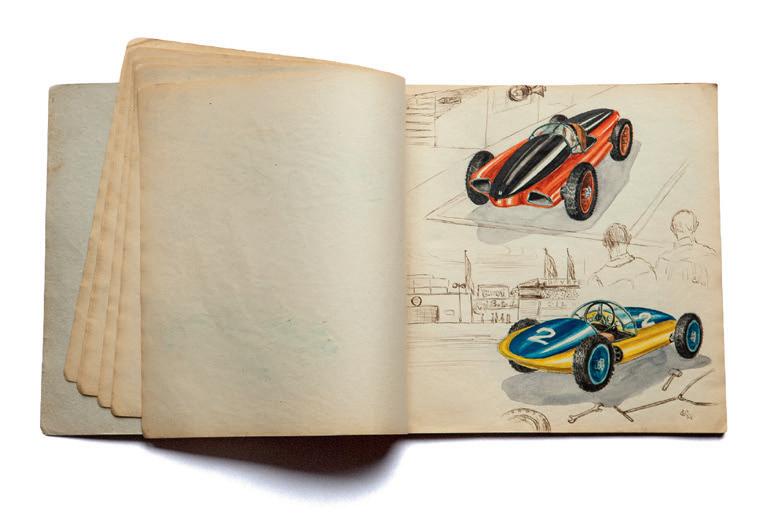
ABOVE Ercole loved to draw cars from a very young age, initially utilising used pages that he glued together to make a booklet.
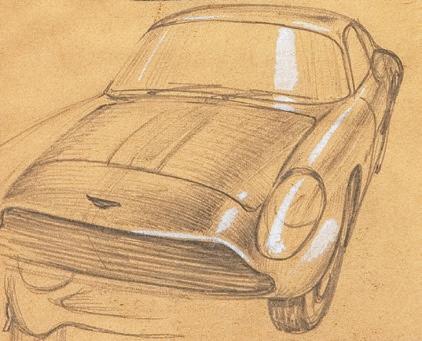
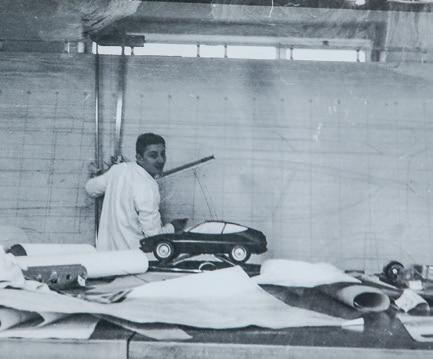
with two fantastic stories in our rucksack. Driving Paolo’s Codatronca had been great. But the tête-à-tête with Spada was one to frame in our memories forever.
We always kept track – Paolo and us, at least. Ercole was no caller or emailer. He was happiest at home in Moncalieri, quietly enjoying the retired life with Antonietta, devouring specialist books about cars and design, collecting scale models, amiably lingering in the background when Paolo’s next project seemed too ambitious, chewing over his own opinion without boring, let alone intimidating, his son. Then, one blue Monday, both gentlemen took us by surprise –tentative, stuttering. Did we, maybe, consider their story worth a book? And if so, would we…? They seemed embarrassed by their own audacity. Boy, did we? Such an honour: we felt chosen.
It wasn’t easy. A proud, sharply dressed individual, Ercole very well knew his own worth. But he was no smooth-talker continually singing his own praises. He was no nostalgic soul who compulsively commemorated his glory days, either. Rather, he looked to the future. Yet his story was so inspiring, romantic and almost naive, it had to be preserved for eternity.
As a kid, Ercole loved to draw. Cars, cars, always cars. Aged 11, since there wasn’t any fresh
paper around at home, he glued used pages together to make a booklet: Il Progresso dell’ Automobile. Good looks were appreciated, but progress was his real fascination. Obviously, he studied technology later – design schools didn’t exist. After study hours, he skimmed all the car magazines, or he studied the race results in Monday’s newspapers. The drivers’ names varied constantly. But among the manufacturers, one brand always surfaced: Zagato.
After his military service, Ercole sent out only three short yet ambitious application letters: to Abarth, Alfa Romeo and Zagato. The subsequent interview with Elio Zagato was even shorter: did this youngster possess a driving licence, and could he draw full scale? Of course, he’d never done the latter before. No way had he had access to such huge sheets of paper. But for once, Ercole dared a little white lie. How hard could it be anyway?
“Elio was more nervous than me. It later transpired he’d never received an application letter before and was curious to know who’d made the effort. He hired me on the spot,” Ercole recalled.
The Aston Martin DB4 GT Zagato was Spada’s second job – a delicate beauty. Yet decades later, he was still lost for words when I inquired as to how a 23-year-old debutant had pulled off such a feat. “E, cosi...” “Eh, like this…” Panic in three

ABOVE Elio Zagato gave an untried but determined Ercole his very first design role. Spada didn’t disappoint...
pairs of eyes. Such sparse comments don’t fill thick books. Paolo felt responsible, probably.
“Papa, ti prego, parla, parla.” “Talk. Please.” Sadly, the legend remained mute – his sad-doggy eyes silently screaming for help. Luckily, Paolo knew his dad. He gave him a pencil and tore off some paper – as economically beige-ish brown as wrapping paper, just like in the old days. It worked – kind of. While Ercole’s best hand produced smart little doodles, he tried to explain the ideas behind the Bristol GTZ, Aston DB4 GT Zagato and Osca 1600 GT Zagato – three icons for three iconic brands, all born during his first year at his first employer.
A debut with a big ‘D’, even if nobody realised this novice in his nerdy white dust coat was shaping the future with medieval tools. There was no clay, no scale models, no nothing. All Spada had was a drawing board in the workshop, while experienced craftsmen hammered aluminium panels into moving art next to him.
“Ercole, cosi? The awful racket, the hefty odours: it was like war in there. My drawings were black from all the dust before they got finished.” Very well realising he lacked appropriate wording to describe the atmosphere – while nobody had ever bothered photographing the place where the magic happened – Ercole made us an offer
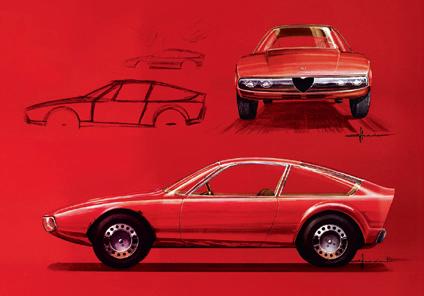
ABOVE ‘Flashy’ Junior Z was just one of many collaborations between Zagato and Alfa Romeo.


BELOW Ercole designed the Ford GT70 concept, a potential GT40 successor, during his six-year tenure at Ghia.
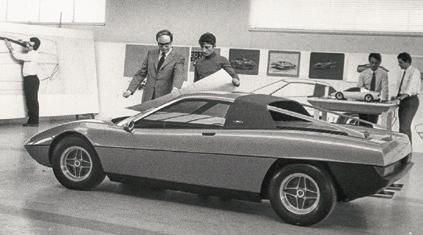
we could not refuse: what if he produced a meticulous, charming drawing for our book?
Zagato was not a design house. Not like Pininfarina or Bertone. Zagato prepped race cars, yet with feather-light aluminium bodies instead of hotter camshafts or ravenous carburettors.
“Hard to imagine I was its first designer. Before me, those cars just happened. If a Zagato design turned out to be more beautiful than the vehicle it was based on, it was mainly a lucky consequence of the uncompromising pursuit of speed.” That’s exactly why Aston Martin had rung Zagato’s bell in 1960: its DB4 was lagging behind the lightning-fast Ferraris. Sixty-odd years later, the universe judges this Aston as one of its most divine creations. Ercole begged to differ.
“It may be attractive and well balanced, but there’s nothing innovative about it. Why on earth did I incorporate flared wheelarches? Because everyone else did,” he reflected harshly. It was a beginner’s mistake he wouldn’t repeat.
That’s when Alfa Romeo called. After the Giulietta’s little four-pot screamer was squeezed to the max, while Zagato’s Giulietta SZ variant already flirted with anorexia, the company had to find additional speed elsewhere to beat the Lotus Elite. Fortunately, Ercole had picked up an idea from a library book on aerodynamics: a long tail that was ruthlessly cut off – Codatronca in smooth Italian. Since Zagato didn’t have a wind tunnel, the Milan-Bergamo autostrada served as its proving ground – Elio pedal to the metal, Ercole in the hot seat counting lamp posts, calculating
BELOW The E32 7-Series was a key achievement while working with BMW.

their speed. “We had fabricated a temporary aluminium tail that we could quickly attach to a regular SZ. For our first run, we’d hidden the tail in a ditch. Next, we ran with this assembly in place to check which was fastest. Wonderful times; truly pioneering work. Our modifications had nothing to do with styling. They were the result of our quest for efficiency.” It worked. Zagato’s Giulietta TZ dominated races and Spada’s name remained linked to this clever idea forever.
More remarkable designs followed in rapid succession, including a cute Appia Sport, a snazzy BMC Mini-Kat, a modernist Hillman Zimp, a sensual Fiat 850 and the avant-gardist Flavia Sport from 1962. “Lancia wanted something to turn heads. They got it. But it wasn’t arty for art’s sake. It was clean, fluid and aerodynamically sound.” Ercole’s 1965 Lancia Flaminia Zagato Super Sport radiated such glamour, even actor Marcello Mastroianni desperately needed one, while the Fulvia Zagato seduced thousands of would-be Mastroiannis.
There was also a cheeky Alfa 2600, a fierce Lamborghini, a second Fulvia that never reached series production, an attractive Rover 2000 TCZ coupé and an elegant Fiat 125, whereas the flashy Alfa Junior Zagato was again assembled in its thousands. It was all controversial work with one common thread: a clever underlying concept. “Typically, my designs were less well received. Only after a few years, people recognised their value. Eventually they became dedicated fans.”
Despite enjoying unbridled creative freedom,
Ercole still moved to Ghia in 1970: “Zagato was unique. But I wanted to experience how professional design studios functioned. Elio mainly looked at racing. It became increasingly irritating how his lack of any future vision prematurely killed many promising projects.”
Many of my questions remained unanswered during our lengthy talks, Ercole merely looking helpless and remorseful. It often took days, or weeks, of pondering and digging in his own head before sharing his response over the phone. Thinking was his second nature. Calling wasn’t.
Only after a few months, something else began to dawn. Paolo wasn’t their only child. Ercole and Antonietta had two sons. But Andrea was barely 14 when he lost his merciless battle with cancer. A disaster. They were tough times anyway. After six pleasant yet hardly productive years at Ghia, Ercole had embarked on the biggest adventure of his life by joining Audi first and BMW later. In Munich he had been responsible for the legendary second 7-Series with the subtlest of rear spoilers, and for the E34 – the most balanced 5-Series ever.
Life in Germany was rough for the young family, though, while Ercole was not properly armed for either the corporate game or advanced politics. Still, when Andrea fell ill, the Spadas could instantly return to Italy, be among their trusted ones, give their poor boy the best possible care. There was no rush. There were no worries about his salary, either. Why didn’t he return to work only when he felt ready? Ercole never forgot




this grand gesture. For the rest of his life, he drove BMWs. A loyal, sensitive man with a sad glare in his eyes no comedian could massage away.
Spada’s designs were explicit and daring, but his vocabulary remained sparse and his gratitude subtle. One day, Paolo, Lies and I showered lavish compliments on la mama’s octopus pasta. Ercole hardly said a word. All Antonietta got was an almost invisible squeeze on her upper arm. Yet never before did we witness so much love condensed to such human dimensions. A beautiful but frugal man.
A little while later, we travelled to Touring Superleggera in Milan. For reasons only Italians understand, Zagato’s archive was stored at its competitor’s premises. Rummaging through his original drawings, Ercole proved ruthless towards his younger self. “Brutta, brutta. This is hideous. That’s even more repulsive.” We had to lobby hard to use these fabulous images for the book. Touring was absolutely fine with it. Spada, on the other hand...
Next, it seemed logical to visit Zagato – again for reasons only Italians understand, Zagato and Touring are neighbours. When a sharp, screeching voice asked who dared to ring the bell unannounced, Ercole managed only: “Il giornalista Belga Bart Lenaerts.” It hadn’t occurred to him that his name carried far more weight – especially around here. Even so, minutes later he brazenly slipped into Zagato’s secret offices for a trip down memory lane. Nobody dared stopped him. A modest but self-assured man.
Ercole could have been wealthy if he’d kept one of his masterpieces aside. Back then, nobody wanted such worn-out race cars. Now, they all fetch fortunes. But money barely interested him. It certainly wasn’t a valid criterion by which to
assess his work. He was proud about the Alfa Romeos TZ1 and TZ2, the Aston DB4 and particularly the Osca Dromos he designed as a freelancer later. But he was just as delighted with the Fiats Tipo and Tempra, the Lancias Dedra and Delta, and the Alfa 155, which all saw the light of day under his watch between 1988 and 1992, when serving as IDEA Institute’s design director. Although these five models acted in totally different segments, they shared the same chassis, windscreen and even door inners. It was another ground-breaking concept, albeit this time to save money and keep these suffering brands afloat. Ercole was immensely frustrated when the Italians subsequently managed to water down this ingenious idea, while Volkswagen consistently perfected it and eventually made fortunes.
When we ultimately presented our Spada book at Belgium’s leading car museum, Autoworld, Ercole was determined to give a speech about his five best designs. Beforehand, we could already feel the awkward silences weighing down upon the audience. Once more, however, the man took us by surprise. Despite his poor English, he suddenly chatted like a politician on MDMA –his panache fuelled by a rare glass of wine.
Later that same evening, it seemed smartest to rely on hire bikes to grab dinner in the city centre. Again, Ercole was unrecognisable. Cycling, for the first time in 50 years. The dinner was lovely. Still, he was as impatient as a kid at a fancy fair. “Shall we take another ride? Per favore?” During dessert, he thanked us – stammering, whispering. The book was magnificent, he believed, but he was above all eternally grateful with how we’d captured the loss of Andrea – subtle yet spot on. No big words. Just a warm squeeze on the upper arm. Afterwards,
he went cycling through night-time Antwerp, all by himself, cheerfully ringing his bell at every soul of good intentions. A playful, complex man.
We remained close friends forever. Whenever we were in Turin, we shared a generous dinner table – usually at Gennaro’s, a boisterous Italian with a messy dining room and delicious seafood. While Paolo and I were making a noise, loudly discussing the car industry’s latest rights and wrongs, Ercole sat gleaming behind mountains of pasta allo scoglio. When the discourse leaned too far towards cars or, God forbid, towards himself, he would gently turn to Lies, asking how she or our daughter were doing. A reserved, warm man.
We could ask him anything. Of course he wanted to paint all the Maseratis from the Panini collection in his signature watercolour style for us. Obviously he didn’t want any money. Three weeks later, we received 20 three-quarter front views, and one Maserati that was presented from the rear. “Its nose is just too ugly.” A generous yet stubborn man.
One Saturday evening in August 2025, while he was sheltering from yet another scorching summer in Sestriere with Antonietta, Spada’s passionate heart stopped after 88 years. Although a brutally unfair act of faith, this was in some ways also as appropriate as it could possibly be. Ruthless decay hadn’t been for him – a proud, persevering man. Thanks to Ercole, I got to drive the DB4, TZ1 and TZ2. But being able to spend so much time with him was a unique privilege. A beautiful, modest, proud, loyal, sensitive and self-assured yet stubborn, frugal and complex man is no more.
The Spada book by Bart Lenaerts and Lies De Mol is available from www.waft.be.
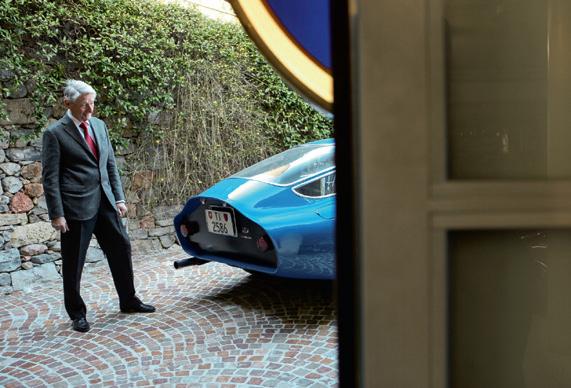



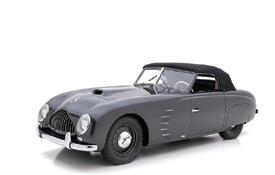





GENUINE EFFORT OR SMOKE AND MIRRORS? CREATING A QUOTA OF ROAD CARS TO LEGITIMISE A RACING MACHINE HAS LONG BEEN A GAME OF SKILL VS CHANCE, AS OUR LIST SHOWS



WORDS
LEFT AND BELOW
Mitsubishi Pajero Evolution dominated the 1997-98 ParisDakar. Nissan needed to build only one road-going version to qualify Skyline GT-R LM for Le Mans.

WHEN it comes to the ParisDakar rally-raid in all its various guises, Mitsubishi has enjoyed greater success than any other marque. The Pajero Evolution was offered in production form from 1997 to ’99 as a means of homologating a competition variant. The car employed a 3.5-litre 24-valve V6, double-wishbone independent suspension that was largely unique to the model and a two-door body with sculptured scoops, blistered arches and spoilers. Around 2500 were built, which allowed the competition variant entry into the T2 Class. The result was outright honours for Mitsubishi in 1997-98.


Nissan Skyline GT-R LM

THINK of Peugeot during the Group B era, and the 205 Turbo 16 springs to mind. However, the company also homologated the most improbable vehicle ever to compete in the class. Fielded at the behest of the marque’s concessionaire in Africa, the GpB 504 pick-up – or bakkie to use regional parlance – wasn’t particularly quick but it was unkillable. It was the tortoise in a field composed largely of hares, and it finished eighth overall on the 1983 Safari Rally. Kenyan ace David Horsey won 1984’s African Rally Championship in a Pug pick-up, too.

ONE of the greatest driver’s cars of the past decade, this steroidal hatchback was pitched by its maker as being a “World Rally Car for the road”. Distinct from most other models here, the three-cylinder, fourwheel-drive mini-thug never scorched a special stage in anger. Designed in conjunction with the Gazoo Racing WRT, it met then-current World Rally Championship regulations. However, Toyota ultimately decided not to campaign the car, so it was launched purely as a production model in 2020 to considerable acclaim. A front-wheel-drive variant was also offered in Japan.
SCROLL back to the mid1990s and the World Sportscar Championship had been consigned to history. GT racing was now the hot ticket, and rules were lax in the extreme as organisers sought to fill grids. In 1995 Nissan built two cars for a tilt at the Le Mans 24 Hours, both of which were rear-wheel drive (as opposed to the regular car’s four-wheel drive), and equipped with 400bhp-plus RB26DETT turbo straight-sixes. One finished tenth, while its sister machine retired. Remarkably, in order to qualify as a ‘production car’, Nissan needed to build only one road-going version…

CITROËN enjoyed a strong run of rally results in the 1960s and early ’70s with the DS and, to a lesser extent, the SM. In recent decades, it experienced World Rally Championship supremacy with Sébastien Loeb to the fore. However, the 1980s weren’t so kind. While there were class wins with variations of the Visa, this turbocharged BXbased Group B monster proved a flop. Although 200 road cars needed to be built in order to homologate the rally variant, it’s unlikely that even half of that were made. Some unsold examples were later scrapped.
to homologate a
rather than a competition car.

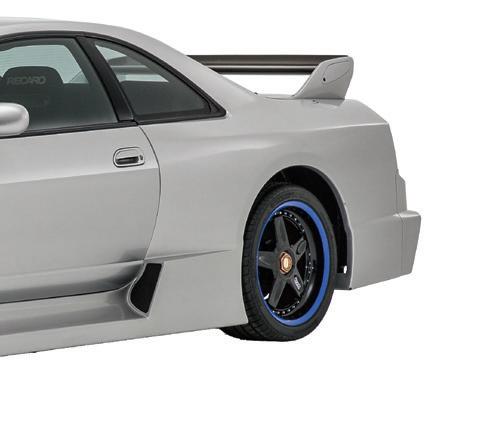
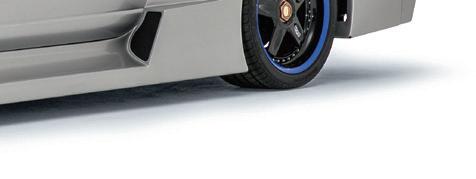
ONE of the great mysteries of rallying is how the Works Chrysler team managed to homologate an Avenger with a twin-cam BRM cylinder head. Such a road car had been mooted in the early 1970s, only to be killed off after just a small batch of heads had been made. In a remarkable sleight of hand, homologation paperwork was obtained and the heads then dusted off for a motor sport application. The first Works Avenger-BRMs competed in March 1975. Stars such as Chris Sclater campaigned them, but they were only intermittently successful.

THE British Touring Car Championship was at its glorious best during the Super Touring era. However, the arrival of Alfa Romeo in 1994 put a lot of noses out of joint. The 155 was bit too fast for some, who complained that the spoiler set-up was illegal. Not so. The rules dictated that 2500 road cars needed to be made in order to homologate the race version. The difference here was that spacers were provided to raise the rear aerofoil, and rivets to extend the front splitter. It was up to the owners if they wanted to use them or not.

SKODA has enjoyed a long and illustrious career in motor sport. Its rear-engined models may have been the butt of many a joke way back when, but it owned the 1.3-litre class on events such as the RAC Rally of Great Britain for decades. With the 1290cc 130 LR, matters took a turn for the hardcore. It may have resembled a showroom model, but this new strain was built to Group B regs, complete with a trick alloy cylinder head, largely bespoke suspension plus aluminium doors and bonnet. One placed a remarkable sixth overall on the San Remo Rally in 1986.
THIS was an exercise in homologating a race engine rather than a car per se. Think back to the late 1960s, and Ford needed to build the requisite number of 429ci V8s for use in NASCAR. However, rather than stuff them into the Torino or Mercury Cyclone that would actually be raced, the Blue Oval charged Kar Kraft with putting them into Mustangs. The race powerplant featured alloy heads, staggered valves and so on. Even detuned for the street, this big-block unit was rated at 375bhp. No fewer than 857 cars were made in the first year, with a further 500 in 1970.

OF the umpteen Australian homologation specials, there was more than one variant of this four-door supersaloon. The VL Commodore SS Group A in particular enjoyed a fine, if brief, career on-track. This strain was built to meet FIA rules requiring 500 road cars, the new bodykit encompassing various aero tweaks, while the A9L small-block V8 featured trick heads. Cars were raced in Australia and the WTCC in 1987, the highlight being victory in the James Hardie 1000 at Bathurst.

ABOVE AND RIGHT Nissan R390 GT1 was a hypercar before the term existed. MercedesBenz sold 502 brawny 190E 2.5-16 Evolution IIs – all of them black.

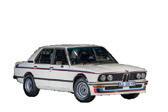
SOUTH Africa has a rich history of homologation specials, and the 1976 530 MLE (Motorsport Limited Edition), taking on the dominant Ford Peranas in the Modified Production category, was more successful than most. Each of the 110 E12-series 5-Series road cars had a hottedup 3.0 M30 straight-six and lighter-gauge panelling. Weighty items such as air-con were also removed. The track variant cleaned up – and the car also discreetly inspired the M535i.

ARGUABLY the best Australian homologation special ever (it rather depends on whether you prefer Holdens), 300 roadgoing variants were produced of this muscular supersaloon, the ultimate iteration of the GTHO series. If the stripes didn’t alert you to the fact that this was no ordinary Falcon, the spoilers and the Shaker bonnet scoop certainly did. The latter was in place to clear the air cleaner atop the hotted-up 351ci Cleveland V8. Phase IIIs blanketed the podium positions in the 1971 Bathurst 1000.
THIS strikingly exotic Nissan was built to contest the Le Mans 24 Hours. It was also a hypercar before the term existed. In order to qualify, the road car had to be homologated first. A loophole in the rules meant that only one needed to be built, and the roadregistered R390 was a reputed handful to put it mildly. That said, Nissan offered to build replicas of this TWR/NISMO co-production at $1 million a pop, but this was PR smoke. The twin-turbo V8-engined monster proved quick in race trim, yet it didn’t have the best finishing record during its two-year programme.

THE Mini Cooper in any of its many flavours was a thing of wonder, as well as a winner in umpteen disciplines of motor sport. Unlike many other iterations, the 970 S was purely a homologation special. Based on the Mk1 variant, the numerical designation denoted its cubic capacity. It was a means to an end; a way of staying competitive in the thriving 1.0-litre category of series such as the British Saloon Car Championship. As many as 963 were made from June 1964 to April 1965.

BASIL Green had form when it came to hotting up Capris, having inserted V6s into them before the factory did. The V8 Perana, though, was something else entirely. Road cars were built from 1970 to ’72, each with a 5.0-litre Windsor small-block and Mustang Toploader ’box. Around 400 were made – 300 more than was necessary for it to compete in the Modified Production series. The likes of Bob Olthoff and Basil van Rooyen dominated, the latter also introducing a rival of his own – the V8 Chevrolet Firenza.
BELOW Ford Capri touring car racer bred more than one iteration of the RS2600 up to 1973.


Mercedes-Benz 190E 2.5-16 Evolution II

VOLVO purportedly built 500 special variants of the 240 Turbo, with a rear spoiler, flatter bonnet, larger turbo intercooler, water injection and more. The FIA/FISA inspected 23 cars, and the paperwork was rubber-stamped on the understanding that the other 477 homologation cars had been built. They’d been shipped to the US, apparently. In reality, they didn’t exist, while the 23 that did were subsequently stripped of their racy bits. Volvo won the 1985 European Touring Car Championship…
THIS brawny Merc was first seen at the 1990 Geneva Motor Show. It raised eyebrows, not least because its short-stroke M102 four-cylinder produced a handy 232bhp. It could also rev to 7700rpm. Of perhaps greater import, however, was the physical makeover. The bodykit may have appeared outré on a road car, but this was a homologation special. A minimum of 500 replicas needed to be made in order to make the race variant legal. The Works team demanded greater downforce, and they got it thanks to the glassfibre add-ons. In the end, 502 were sold – all of them black.

YES, this was another ‘road car’ with only token nods to Highway Code adherence built during the GT1 era of racing. Toyota Team Europe and Dallara created this wild device in a bid to win the 1998 Le Mans 24 Hours. It drove a horse and cart through a homologation loophole regarding build numbers – and functionality. For example, it was meant to be able to carry a suitcase… It could, just about, assuming said luggage was oddly shaped and stowed in a virtually inaccessible place.
FORD’S touring car racer of choice in the early 1970s was the Capri, although there was more than one iteration of the RS2600 on which the competition model was based. The first 50 were built in March 1970. Dubbed Plastikbombes, they boasted glassfibre bonnets, bootlids and door skins. The side glazing was made of Perspex, and much of the cabin trim was removed in a bid to get the weight down to the desired 900kg. The short-stroke V6, meanwhile, was later equipped with fuel injection. Variations on the theme were produced up to 1973.

THIS glorious rally special made an impact during its brief spell on the frontline. It was conceived by Dealer Opel Team boss Tony Fall, with Cosworth building a four-cylinder based on that employed in the proven Kadett GT/E. Irmscher took care of the physical makeover. Walter Röhrl’s Rothmansliveried car claimed Monte Carlo and Ivory Coast honours in 1981. However, Opel placed greater emphasis on fielding the Manta thereafter.
BELOW 288 GTO was arguably the first homologationspecial supercar. Its motor sport career didn’t take off.


THIS touring titan is a cuckoo in the nest here given that the road car was homologated after the race variant. Even then, the street-legal GTR was created under duress. BMW withdrew from campaigning top-flight sports-prototypes in 2000 as it focused on F1. Its touring car programmes were annulled, too. However, it remained in the ALMS (American Le Mans Series) GT group. This allowed special race engines to power ostensibly production-based cars as long as ten road-going reps existed. BMW dominated, winning seven rounds.
Arch-rival Porsche wasn’t pleased and demanded BMW provide evidence that it had built ten 4.0-litre V8-engined, partially carbonfibre-skinned, M3 road cars. The firm then built a batch – the kicker being that three were destroyed postproduction and BMW kept the rest. As such, nobody could buy one. The regs were changed shortly thereafter so that 1000 cars needed to have been built beforehand to comply.


IT was one of the most audacious acts of homologation chicanery ever effected. Think back to the end of 1992 and the World Sportscar Championship had expired. Group C died with it, although cars built for this class were given dispensation to compete at Le Mans a year later. GT racing clearly represented the future, though. Interest in campaigning production car-based offerings was definitely on the rise. Then German team boss Jochen Dauer rocked up at Le Mans in 1994 with what appeared to be an old sports-prototype.
The Porsche 956 and its 962 descendent had owned the 24hour race from 1982-87. Dauer had produced a road-going version, which was somehow then re-homologated as a GT machine. And thus, a race car that had been turned into a road car became a racing car again. It won outright with assistance from Porsche (a sister car finished third). This upset those who’d fielded legitimate GT racers, but the rules were vague when it came to defining a ‘production car’. The 962 LM wasn’t invited back, though.

UNLIKE the vast majority of Group B cars, the RS200 had a look all of its own. It wasn’t a hatchback that had been given a Frankensteinian makeover. Ford had spent two years developing the Escort RS 1700T, only for returning team principal Stuart Turner to can the project. He reasoned that it wasn’t fit for purpose, so the Blue Oval started afresh. It fell to a freelance designer to map out this brave new world. Tony Southgate had no prior experience of rallying, but he had previously been responsible for Indy 500 and Le Mans winners. Ford’s John Wheeler developed project ‘B200’ thereafter, the first part denoting Group B, the numerical designation referring to the 200 cars that needed to be built for homologation purposes. The model placed third overall on its maiden WRC start on the 1986 International Swedish Rally, but that was as good as it got. The RS200 never was a great force prior to the axing of Group B, but it subsequently excelled in rallycross.

PORSCHE withdrew from Works involvement in sportscar racing following the 1988 running of the Le Mans 24 Hours. It offered below-theradar support thereafter, and went so far as to build the 911 GT2 that privateers raced with moderate success. It returned to top-flight competition in 1996 with a car that was similarly 911-based – if you believed Porsche. In reality, it was a mite different to the point where it shared only the front and rear lights with a mainstream production model. This mid-engined device shared significantly more of its DNA with the 962 sportsprototype of old, not least its twin-turbo 3164cc flat-six, and its first time out was a four-hour race at Brands Hatch. A brace of road cars were registered in ’96, while 20 road-legal Strassenversion GT1s with 996-style headlights were made in ’97. A single 911 GT1-98 road car was built to homologate the ultra-hardcore 1998 variant.
THINK back to the early 1980s, and vowel-laden exotica tended to be fast but flabby. The arrival of the 288 GTO in 1984 changed all that. It was arguably the first homologation-special supercar. However, unlike its fabled ancestor, the 250 GTO from two decades before, it achieved precisely nothing in motor sport. This gorgeous machine was adapted to race in the Group B category of the World Endurance Championship, whereby 200 replicas needed to be sold before 20 ‘evolutionary’ models could compete (Ferrari eventually exceeded expectations by producing 272). While it resembled a 308 GTB, only the doors and windscreen were carried over. The same was true of the tubular chassis, which was altered appreciably, while its twin-turbo 32-valve V8 was mounted inline rather than transversely. When multiplied by the FIA’s 1.4-litre ‘turbo equivalency’ formula, this all-alloy unit mustered a notional 3997cc – or 4.0 litres – from 2855cc. However, while Group B rallying flourished – if only briefly – the circuit-rooted side foundered due largely to manufacturer indifference. As such, the Ferrari’s motor sport bid never happened.


B rallying.
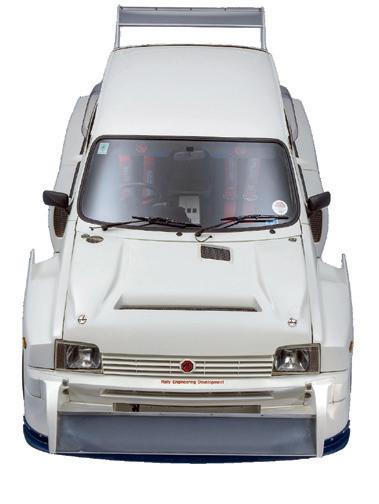

VAUXHALL dovetailed rallying with circuit racing for much of the 1970s, with an emphasis on the latter. However, that all changed towards the end of the decade, when Luton’s finest committed all of its resources to off-piste motor sport. It did so via a hardcore variant of the Chevette, the HS2300 arriving in 1978. Homologation rules stated that 400 cars must be built, but although the Bill Blydensteintended Works entries were fielded before the requisite number had been produced, the Griffin soon ran up against officialdom for other reasons.
You’re never a cheat until you get caught, and the Chevettes with their 2.3- or 2.6-litre four-bangers proved a bit too quick for some. Rivals protested, and it transpired that the cars were a bit more exotic than the homologation paperwork suggested. Even so, they went on to enjoy great success once they were to the letter of the law, and when driven by the likes of Tony Pond, Jimmy McRae, Terry Kaby and Pentti Airikkala. The last of these claimed the 1979 British title in the evolutionary HSR.
FEW cars epitomised the madness of Group B rallying more than the 6R4. It looked freakish and had the performance to match, but the category was killed off before it had a chance to shine. Devised by British Leyland Motorsport (later Austin Rover Motorsport), it fell to Williams Grand Prix Engineering to create the first prototype. However, plans seemed to change with the wind. Initially, it was to feature a V8 engine. Then it was going to have a Honda V6 – and the design was quite a long way down the road to completion – but this unit didn’t materialise.
It was only late in the day that the own-brand 3.0-litre 90º ‘V64V’ V6 was created. It resided where the rear seat and shopping normally went. This four-wheel-drive monster may not have succeeded in top-flight rallying, but it shone at national level, while Didier Auriol claimed the 1986 French title with his R-E-D-prepared example. All told, 205 cars were made, with a one-make race series being created to help shift those that were unsold.
Mercedes-Benz CLK GTR
THE return of MercedesBenz to the sportscar arena was brought about by the death of the DTM (Deutsche Tourenwagen Meisterschaft) and the International Touring Car Championship in 1996. The implosion of top-flight touring car racing meant that the marque had nowhere to compete (although it sponsored engines used in single-seaters). As such, subsidiary AMG embarked on a rushed GT1 programme with a car that was notionally rooted in the CLK production model.
The test mule was based on an ex-Labre McLaren F1, with the finished article boasted a carbonfibre tub and a 6.0litre V12. It employed only the grille, headlights and rear clusters from the CLK. In order to qualify, 25 road cars were mapped out, although only one was completed in 1997 – the model’s first year in competition, which ended with honours in the FIA GT Championship. In the end, 28 cars were built over two years, including six roadsters. The CLK GTR soon made way for the CLK LM, which is best known for performing repeat backflips at Le Mans in 1999.
THIS PAGE Ford’s RS Cosworth proved a hit both on-track and on the rally stage. Maserati’s MC12 briefly starred in top-flight GT racing.

THE Escort dominated rallying during the 1970s and into the early 1980s. However, it was slim pickings thereafter. The Mk3-based RS 1700T was aborted early on when it became clear that a rear-wheeldrive car was going to be outclassed by four-wheel-drive weaponry. Save for Gartracmodified cars that were ineligible for anything other than club-level rallying, that was it for the Escort until 1992, when the RS Cosworth appeared. All this said, the newcomer owed much of its architecture to the Sierra Cosworth. It proved an instant hit as a road car, and was quick off-piste when homologated for Group A. The RS Cosworth claimed honours on five rounds of the World Rally Championship in 1993, and it took three more wins a year later. However, the Works team was shuttered in 1994, and a rule change regarding turbo restrictors proved a setback thereafter. Even so, the model claimed a further win in 1996 and two more in 1997 when fielded by the Belgian RAS squad. As an aside, the RS Cosworth also proved quick ontrack, with victories including the Willhire 24 Hour in 1994.

AUDI drop-kicked rallying into a different orbit with the Quattro. Aside from making four-wheel drive a must-have, it also popularised forced induction. Hannu Mikkola claimed maiden honours on the 1981 International Swedish Rally. Success begat success, Audi taking further big wins (and titles) a year later, while A1 and A2 variants were in the hunt to 1984. Nevertheless, the arrival of mid-engined Group B fare foreshortened the car’s career. Drivers complaining of understeer due the noseheavy stance, and pushed for something a bit more… bespoke. Audi’s board, however, was adamant that it’d only sign off on a car that closely resembled a production model. While midengined prototypes were built in secret, the marque publicly responded with the Quattro S1. It was visually similar to the old car, albeit with a 320mm-shorter wheelbase, but rather different. It comprised composite panels, with much wider wheelarches, and front bodywork robbed in part from the 80 saloon. Exactly 214 cars were made, 164 being sold to the public.

FIRST seen in concept form at the 1983 Geneva Motor Show, the ‘Gruppe B’ styling study foretold the supercar that was to follow. The definitive 959 emerged at the 1985 Frankfurt Motor Show but, contrary to popular belief, it shared little with the 911. Even the glazing was new. It was a technical tour de force: a study in streamlining (its drag coefficient was just 0.31Cd), with a rear-slung flat-six, dry-sump lubrication and sequential turbo set-up. It also had 4WD, with production cars running to anti-lock brakes, adjustable dampers, a sixspeed ’box and run-flat tyres. Some of this may sound pedestrian now, yet that wasn’t the case 40 years ago. Porsche didn’t recoup its investment despite the egregious £140,000 asking price, but that wasn’t the point of the exercise. It was about bragging rights. With 200 cars required for homologation, 283 were built, and the 959 claimed honours on the Paris-Dakar in 1986. The 961 derivative racked up a class win at Le Mans that same year.


MASERATI was once a marque steeped in motor sport. Road cars were secondary to its competition programme until the firm officially withdrew from racing in 1957. There were sporadic returns thereafter, and a few successes as an engine supplier, but there hasn’t been much of a concerted effort to venture back on track over the past 50 years. That said, there was a brief interlude in which Maserati came to own topflight GT racing, and it did so by fielding a… Ferrari Enzo. However you sugar-coat it, the MC12 wasn’t a Maserati so much as a redraughted Maranello product. Nevertheless, the body was drastically reworked to the point that only the windscreen was carried over.
Fifty road cars were built for homologation purposes in two distinct batches (the last 25 examples made were 150mm shorter). Twelve further MC12s were constructed for circuit use, and the model first ventured trackside in late 2004 in the GT1 category. A Works entry claimed honours at Zhuhai International Circuit. Factory-run and privateer MC12s went on to claim a further 39 scalps.
BELOW Lancia’s 037 was the first rally car built explicitly to Group B regulations rather than adapted to suit.
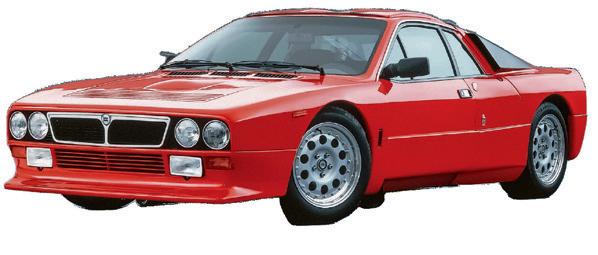
Lancia Rally 037

ONE of the all-time rally greats, the Cinq was also a fun, if lairy, road car. It was a parts-bin special, the rear suspension having been robbed from the Alpine A310. The five-speed gearbox came from the 30 TX; it was rotated through 180º and allied to the 1397cc fourcylinder unit sited amidships. Renault pioneered forced induction in motor sport, so it was no great surprise that the 5 Turbo boasted a Garrett AiResearch T3 turbo. Then there was the body. The cartoonish exterior makeover has long been attributed to Marcello Gandini. In fact, it was penned in-house by Marc Deschamps (Gandini did the interior). Homologated to compete in Group 3 and Group 4 of rallying (and later Group B), the 5 Turbo won first time out, Jean Ragnotti taking the Monte Carlo Rally in 1981. ‘Jeannot’ also triumphed on the Tour de Corse in 1982 and ’85, by which time the car was generally on the backfoot against four-wheeldrive rivals. Such was the road model’s popularity, 4987 were made in various series.

THIS hottest of hot hatches represented a fantastic return on investment. It was developed on a tiny budget and went on to win the WRC. It was also one of a pair of concurrent projects that emerged from Lotus Engineering in the late 1970s (the other being the DeLorean DMC-12). Unlike some other ostensibly similar cars built with competition in mind, this one was received with open arms by the dealer network, which desired a halo product. Chrysler played it straight with homologation. Group 4 regs necessitated at least 400 to be built, Lotus both supplying the marquespecific 2172cc ‘911’ units and performing a rushed development programme for the production cars. They were assembled to rolling-chassis stage at Linwood in Scotland, then delivered to Norfolk. Lotus built the engines, imported the ZF ’boxes and opened a satellite factory at Ludham airfield where the powertrains were installed. Each finished car was then sent to Chrysler/Talbot in Coventry for final checks.


THIS hugely charismatic rally weapon was created for marketing reasons. Lancia was winning everything with the Stratos, but some senior insiders within parent firm Fiat petitioned for something, well, Fiat-shaped to be rallied. The resultant 131 Rally boasted a trick long-stroke, dry-sump, fuel-injected, twin-cam fourcylinder with a cast-iron block and an aluminium 16v head. Its front suspension was akin to that of a regular 131, albeit reinforced, but the independent rear end was all new.
The body, meanwhile, bore the silhouette of a production version, but retained only the inner structure. Its front panel, wings, bonnet and bootlid were glassfibre, while the doors were skinned in aluminium. Fiat went on to claim three WRC manufacturers’ titles (1977-78, 1980), while Bertone took on much of the road-car build work. As to how many Stradales were built, it depends on whose estimates you credit; 400 were needed to appease the rule-makers, but some sources claim around 600 were made.
THE 037 was the first rally car built explicitly to Group B regulations rather than adapted to suit. Initial plans called for a ‘new’ Stratos. Project SE 036 would have employed a longitudinally mounted, Ferrari 308-sourced 3.0-litre V8 amidships. The brilliant Sergio Limone plotted this brave new world, but the scheme came to naught due to its relative complexity, the proposed cost of manufacture and the small matter of the engine being too bulky.
Limone also put forward a proposal that was akin to the Renault 5 Turbo using the Fiat Ritmo (Strada in the UK) as a donor. This idea gained traction, but so did another; a new kind of sports car with a longitudinally mounted four-cylinder unit amidships. Project SE 037 won the toss – and thank heavens it did. Contrary to popular belief, the 037 owed little to the Montecarlo production car save for the mid-engined layout and the centre section. The 037 won the WRC in 1983, and as many as 207 road cars were made.

Dodge Charger Daytona
THERE have been several cars built specifically with NASCAR in mind, but few have reached legendary status – and not just inside the US. You could argue that the sharply snouted Charger Daytona isn’t among their number, but bear with us. The Dodge was created to win high-profile stock car races, with the aero nose and massive rear aerofoil helping the model claim NASCAR’s first 200mph lap, at the now-Talladega Superspeedway in March 1970.
Homologation rules saw 503 road-going versions built, of which 70 were equipped with a 426ci Hemi rather than the more usual 440ci Magnum unit. However, the car that followed in its wake is better known internationally. The Plymouth Superbird was a refinement of the Charger Daytona, but the rules now stipulated that two cars needed to be built per marque dealer. As such, as many as 1935 were made. However, NASCAR banned aero mods and restricted engine size to 305ci for 1971, so the Superbird was offered for one year only.


THE Delta S4 – aka S4 Corse – was perhaps the most radical vehicle ever to compete during the Group B era of international rallying, which given the competition is really saying something. Project SE 038 was notionally related to the Delta hatch, but you had to squint to see the resemblance. The car boasted a DOHC 1959cc fourcylinder unit amidships that employed a turbocharger and a supercharger – or ‘volumetric compressor’ in Lancia speak. This was reputedly the first car ever to feature such a ‘twin charging’ arrangement, whereby the blower provided the oomph at low rpm but disengaged once the turbo had spooled up. The freakish body comprised carbonfibre front and rear sections plus doors made of Kevlar. The S4 won first time out on the 1985 RAC Rally of Great Britain. As for homologating the model for production, Lancia got away with fudging the figures. As few as 45 Stradales were made, which was somewhat short of the requisite 200.

threw a huge amount of money at winning the WRC during the 1980s. This wasn’t just a competition programme; it was a rebranding exercise with the mighty Turbo 16 to the fore. Responsibility for creating this blunt instrument fell to Peugeot Talbot Sport in Paris, and run under the aegis of Jean Todt. Nothing was off-limits save for the need for the new four-wheel-drive supercar to resemble the 205 production model.
A turbocharged 1775cc four-cylinder motor was created out of an XU diesel unit, but with a 16-valve DOHC head to run on petrol. Under FIA equivalency regulations, whereby displacement was multiplied by a factor of 1.4 for forced-induction set-ups, the end capacity was 2485cc. This meant the T16 would slot into the 2000-2500cc category. Peugeot homologated the 205 T16 without inflating the numbers made. Subcontractor Heuliez fashioned 200 road cars, which enabled the build of 20 evolutionary competition variants. Et voilà, the Turbo 16 went on to bag two WRC titles.


TOYOTA has enjoyed great success in rallying over the past five decades, even if it has sometimes courted controversy (to put it mildly). The fourwheel-drive GT-Four was its frontline weapon for many years, although strictly speaking there were three iterations, all of which resulted in brilliant road cars. The ST 165 variant appeared in 1988 and claimed its first WRC win a year later in Australia. The following season saw Carlos Sainz crowned World Champion, the model scoring a total of 13 WRC victories. The ST 185 version arrived in 1992. It dominated the WRC to take the manufacturer spoils in 1993-94, plus drivers’ title for Sainz (1992), Juha Kankkunen (1993) and Didier Auriol (1994). It won 16 rounds of the WRC, while the ST205 strain bagged 1995 Tour de Corse honours – only for Toyota to be stripped of its points (as were its drivers) amid a cheating scandal. The team was also barred in 1996, which rather ended play for the ‘Super Round’ Celica.
THE death of Group B in 1986 meant that Lancia – or rather the Abarth competition department – was obliged to build a car for the Group A category. The Delta HF 4WD secured the 1987 World Championship of Makes title at a canter. It also won the first two rounds of the following year’s series before the Integrale picked up the baton. Launched at the 1988 Frankfurt Motor Show in roadcar form, this newest strain packed a larger Garrett T3 turbo and an extra 20 horses relative to the outgoing model. Blistered arches embraced fatter tyres and grey 15-inch alloys, the 56:44 front-to-rear torque split imbuing it with preternatural levels of grip. Capable of 0-60mph in 6.6 seconds on to a 133mph top end in road-going spec, this was a peerless point-topoint car. This latest strain dominated the 1988 WRC season, bagging manufacturer honours well before the end of the campaign. There would be umpteen variations thereafter, the Integrale claiming its fifth consecutive WRC title in 1992.


THIS PAGE Both BMW’s 3.0 CSL and Lancia’s Delta Integrale forged highly successful motor sport careers.

THERE were several iterations of the CSL, the last initial denoting Leicht (Light). The original 1971 edition was developed by Alpina. It emerged 200kg lighter than the model that bore it, but only 165 were sold. As such, it was somewhat short of the 1000 cars mandated by homologation regulations. BMW took over for 1972, having poached Ford’s Jochen Neerpasch and Martin Braungart to spearhead the motor sport division. The new strain gained the straight-six from the 3.0 CSi, with Bosch fuel injection and a capacity hike to 3003cc.
Displacement was further enlarged to 3153cc in 1973, which meant 206bhp in road trim. Of greater interest was the wild external makeover, not least the deep front spoiler, the roof-mounted air deflector and the aerofoil that sat atop the existing rear spoiler. The first 110 cars were delivered with said wing requiring home assembly because it hadn’t been Type Approved. BMW got away with this blatant fiddle, though. The CSL ‘Batmobile’ took six European Touring Car Championship titles between 1973 and 1979.


THE story of the GT40 has been told umpteen times – and rarely the same way twice. Then there’s the inevitable tug of war regarding who did what, which nationality should take credit (the British claim the GT40 as its own, as do the Americans – only more vociferously). Get past that and the important bit is that the car existed in the first place. The Ford wasn’t a brilliant racing car, but it was a good one. It was tough as old boots, too, which explains why it eventually excelled in endurance racing (and how). It was also built with a money-no-object budget, former competitions manager Stuart Turner once quipping that Ford spent more on winning at Le Mans than NASA did on the Moon landing. This would explain why the Blue Oval was able to produce an initial run of 50 road/race cars to compete in the Group 4 GT class rather than as a sportsprototype. And the company was only just getting started...

TO be fair, we could have included half a dozen Escorts here without breaking a sweat. The RS1800 won the toss because of its near-mythical status. It was launched in June 1975, cars being built at the Advanced Vehicle Operations facility in Aveley, Essex (where the Mexico and other RS cars had been assembled previously). Power came from a 1.8-litre variant of the Ford-Cosworth BDA twin-cam unit that was allied to a five-speed ZF ’box. The 1600 Sport initially served as a basis, although later cars were derived from RS Mexicos. They arrived complete from Germany before being stripped of their engines and converted to RS1800 specification. The wins kept coming. Timo Mäkinen won the RAC Rally in 1975 in one, and the model was undefeated on this event to the end of the decade. The RS1800 claimed 20 WRC victories to ’81. As to the vexed question of how many road cars were made, the consensus is 109. As such, a lot of smoke and mirrors were involved in homologating it.
BELOW A ruse cloaked in smoke and mirrors? Nevertheless, the audacious 250 GTO dominated the grid.

IT was an audacious act of homologation flimflam, and it worked a treat. For 1962, the CSI (Commission Sportive Internationale) decreed that the World Sportscar Championship would make way for the International Championship for GT Manufacturers. As such, GT machinery would take centre stage, which ostensibly meant something rooted in a production model. Regulations stated that 100 cars needed to be built to meet homologation requirements. Ferrari took a more lateral approach when it came to interpreting the rules. It built an out-andout racer instead – and then fibbed outrageously.
The Prancing Horse made just 39 GTOs (‘O’, preposterously, standing for Omologato, or Homologated) from December 1961 to May 1964. It insisted that the GTO was merely an evolution of the 250 GT SWB, of which the requisite number had been made. Aided and abetted by race organisers who wanted Ferraris on their grids, the ruse worked. And how. The GTO dominated, winning 28 rounds over three seasons.

THE Subaru Legacy claimed the marque’s first-ever World Rally Championship victory on Rally New Zealand in 1993. Its replacement had already made its competition debut during the previous round, Rally Finland. It was the car that came to redefine the brand. An Impreza in ‘555’ warpaint conjures Colin McRae catching air on his way to the 1995 WRC drivers’ title; of Carlos Sainz and Richard Burns also starring during what was arguably rallying’s last great era before singlemake hegemony took hold.
The Impreza in its assorted guises accrued three drivers’ crown, as many manufacturers’ gongs and 46 WRC wins. As such, picking one variant is no easy task, so we ducked out and went for a car based on a homologation special. The STi 22B is arguably the most desirable of all Imprezas, being rooted in the STi Version IV Type R; 399 were made for the home market in 1988, and 16 for the UK (plus five for Australia).
Mitsubishi Lancer/ Carisma ‘Evo’
TIME to fess up: we have grouped several iterations of four-wheel-drive supersaloons together here. As with the Ford Escort and Subaru Impreza, we could have included endless variants given that there were ten distinct generations of Lancer/Carisma. Oh, and endless subspecies, not to mention nation-specific editions. Also, not all of them were rallied. Those that were scorched special stages, in particular during the midto late 1990s when steered by Finnish star Tommi Mäkinen.
The Ralliart Mitsubishi versus Prodrive Subaru battles became the stuff of legend, and Mäkinen generally held sway, claiming consecutive drivers’ titles from 1996-99 aboard Evolutions III, IV, V and VI. Tellingly, Mitsubishi won only one manufacturers’ crow, though (in 1998). While the marque’s fortunes on special stages dwindled into the following decade, it continued to make electrifying road cars. Our favourite remains the British-market Evo X FQ-400, the FQ bit standing for F****** Quick. Yes, really.

ABOVE Whatever flavour you preferred, there was no denying that the


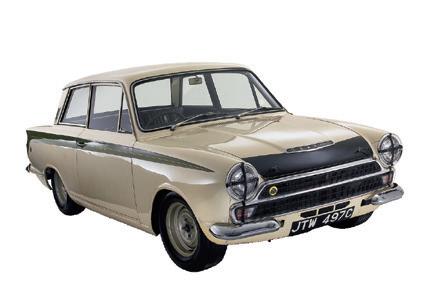
ABOVE The car that started it all: the Lotus Cortina is regarded as the first homologation special based on a mainstream production model.
THE E30 series M3 matters on so many levels. Unlike some homologation specials, it sold on its own merits. BMW didn’t struggle to shift cars. Quite the opposite – it couldn’t make enough of them. It shared relatively little with the model that spawned it, and it remains one of the greatest driver’s cars ever to turn a wheel. The really impressive part is that it would continue to be lionised even if it had never ventured trackside in anger. That it won big in touring car racing, and even won a round of the World Rally Championship, is merely the icing on a highly calorific cake.
IT was the car that set the template for homologation specials based on mainstream production cars. Win on Sunday, sell on Monday and all that. Original plans called for 1000 Lotus-ised Cortinas to be homologated as Production Touring cars for the International Sporting Code’s Group 2 category. Lotus founder Colin Chapman had long been keen to produce an engine in-house, and with a timely injection of funds
for the five-bearing Ford Kent bottom end.
Following substantial revisions by Cosworth’s Keith Duckworth, it was inserted into the Cortina hull, along with heavily reworked suspension and light alloy skins for the doors, bonnet and bootlid. Production of the Lotus Cortina began in February 1963, but it wasn’t until the September that it was eligible to race. During the car’s maiden outing at Oulton Park, BELOW The M3 is
The M3 concept was first touted as far back as 1981, when it was announced that the Group 1 category of touring car racing was to make way for Group A. This meant that the designated weapon of choice would need to be made in
relatively large numbers (5000 units in the first 12 months of production). However, BMW persisted with variants of the 5- and 6-Series with varying degrees of success, before revisiting the idea. The M3 arrived in 1986. The iron-block four-cylinder unit here was largely new, as was much of the bodyshell. Only the bonnet was common to the M3 and a regular 3-Series. Even the rake of the rear screen was different. The M3 went on to claim major titles and honours in umpteen blue-riband events, and it was one of only a few Group A cars that were adapted to Super Touring regs for 1991. Road-machine sales remained buoyant to 1990, with BMW building far more M3s than homologation requirements necessitated. As many as 17,970 were made (including 786 convertibles), with a quarter heading Stateside.





















BELOW Sierra RS Cosworth has achieved both ‘legendary’ and ‘iconic’ status.
Ford Sierra RS Cosworth
THESE days, just about everyone or everything is considered legendary or iconic. In performance-car lore, however, few homologation specials have ever been more deserving of both terms than the Sierra RS Cosworth. This was the 1980s wild child; a Ford that could trounce exotica thanks to its competition-bred, turbocharged 2.0-litre ‘four’. When it broke cover at the Geneva Motor Show in concept form in March 1985, few could have envisaged the impact it would make, both on-track and in popular culture.
Ever since the Capri had been usurped in touring racing in the early 1980s, it had fallen
to the front-wheel-drive Escorts to maintain Ford’s relevance. Even then, there were only class positions to fight for.
A new car was required, and the Sierra was the obvious choice. It was rear-wheel drive, aerodynamic and it needed a marketing boost. During the project’s embryonic stages in early 1983, there was plentiful discussion over which engine to use: either the 2.0-litre Pinto unit or the 2.3 Lima fourbanger as employed in Ford’s US-market Merkur XR4Ti.
The latter model enjoyed some success, Andy Rouse having used one (badged as a Sierra) to clinch the 1985 British Touring Car
Championship, but this was patently a short-term fix. The definitive solution came in the form of a Cosworth 16-valve head on the Pinto engine. That, and a turbocharger and fuel injection. A programme for 5000 cars was approved, with sales scheduled to start in September 1985. Meanwhile, in Germany, Cologne Motorsport engineer Eberhard Braun set about refining the base car’s outline for track usage. Changes were made to the front end, but it was what was occurring out back that caused a degree of consternation among those charged with selling road cars. The massive rear spoiler may have divided
opinion, yet it was equally impossible to ignore. Officially launched in July 1986, 5545 Sierra RS Cosworths were manufactured, of which 500 were dispatched to Tickford for a makeover; with 5000 identical cars built for Group A acceptance, regulations allowed for at least 500 further ‘enhanced’ editions. Enter the mighty RS500. Announced in July 1987, and homologated a month later, this latest variation was a true competition tool. Continuing from where the regular production car left off, the new strain featured what became known as the YBD engine, which was based around
a stiffer cylinder block and came equipped with a massive Garrett T04 turbo as well as a larger air-to-air intercooler. From a road-car perspective, the differences weren’t that marked – a 20bhp hike to 224bhp – but race-tuned engines could exceed 500bhp. ‘Cossies’ bagged touring car titles as far afield as Germany, New Zealand and Malaysia. Ironically, this achievement ultimately led to its downfall. The Sierra was too successful, to the point that the Super Touring regulations were ushered in for 1991. The reign of the fire-spitting turbo Ford was over – but the memories it left behind are ingrained.








Market watch: Buying and driving a Porsche 914 178

Market analysis: Who is swaying record price trends? 184 Watches and art: Patek 3940, and artist Joel Clark 186
Collecting: What’s hot in retro videogaming world? 188
Books and products: Latest must-reads and luxury goods 190

By Richard Dredge
With its impressive drive, great parts availability, easy DIY maintenance and affordable pricing, this classic deserves far more recognition than it receives

only a rear-engined car will do. Of course the front-engined transaxle models have their fans, too, while the mid-engined Boxster is one of the all-time great performance-car bargains. However, the Boxster wasn’t the first Porsche with its powerplant in the middle, because the Stuttgart company had been there more than a quarter of a century before, with the 914.
This model came about because in the mid-1960s Porsche wanted to expand, while Volkswagen needed to ‘sex up’ its image. A collaboration was the perfect solution, with VW’s Heinz Nordhoff and Porsche’s Dr Ferry Porsche agreeing to sell their own versions of a mid-engined sports car from German industrial styling firm Gugelot Design.
VW would sell a four-cylinder 914, while Porsche would market a six-pot version. But Nordhoff died in spring 1968, and his successor Kurt Lotz had no interest in VW building sports cars. After protracted negotiation, a new firm was formed, owned 50/50 by Porsche and VW. VW-Porsche Vertriebsgesellschaft GmbH’s sole product was unveiled at the September 1969 Frankfurt Motor Show. The VW-Porsche 914 replaced the Porsche 912 and the VW Karmann Ghia Type 34 (the Type 14 continued). The fourcylinder 914/4 would be built by Karmann in Osnabrück; the sixcylinder 914/6 body was constructed by Karmann then shipped to Porsche in Zuffenhausen to be finished.
In early 1970 the 914 went on sale across mainland Europe, where it received a lukewarm response thanks to its high prices for a VW (although it was cheap for a Porsche), controversial design and disappointing performance in four-cylinder form. The confusing branding didn’t help – although in the US the 914 was sold as a Porsche, which made buyers easier to find.
The 914 was a disaster in the UK, where it was expensive compared to the Jaguar E-type 4.2, Ford Capri 3000 GT and Triumph TR6. They were dated in comparison, though; the 914 featured rack-and-pinion steering, fuel injection, disc brakes all round and a five-speed gearbox. Over a four-year period fewer than 100 914s were sold in the UK, things being further hampered by a
lack of RHD option. Crayford offered a £550 conversion, but only a dozen cars were reworked, most exported to other Commonwealth countries where RHD was mandatory.
In late 1970 VW-Porsche explored pulling the plug, but it persevered and in August 1972 the 914/6 was discontinued and replaced by the 914/4 2.0-litre. Come the end in December 1975, a fairly healthy 118,915 had been made, including 3318 with the six-cylinder engine.
If you’re in the US or Europe you’ll find your perfect 914 a lot more easily than in the UK, where it’s reckoned that there are just 250 examples. Kevin Clarke is the 914 Register secretary for Porsche Club GB. He says: “The entry point for 914 ownership can be as little as £10,000, for a project 1.7-litre car, but at this level restoration costs might run away from you. If you want something usable you need to part with more like £15,000. You’ll be doing well to buy a 2.0-litre 914 for less than £20,000, and even then it will need tidying.”
He continues: “The best 1.7- and 1.8-litre cars can command £30,000, but the 2.0-litre engine carries a premium because it’s a different and better unit. These typically sell for £25,000 to £35,000, although the very best examples can command up to £45,000. This is still some way short of the entry point for six-cylinders. Projects start at £50,000, with usable but scruffy examples closer to £70,000,
while the best 914/6s are worth around £100,000. Some sellers try to charge a premium for right-handdrive 914s, but they’re hard to sell. The quality of the conversion is poor, the driving position is awkward and the fuel tank is smaller.”
Long-standing owner of multiple 914s Bruce Manning adds: “If you are buying a 914/4, the 2.0-litre engine is the one to go for. It’s usefully more muscular than the 1.7- and 1.8-litre units, and it also sounds better. Six-cylinder 914s are the ultimate prize, but maintenance costs are greater than for the 914/4, which is why there are more neglected 914/6s around than you might expect. The carburetted six is also a lot thirstier than the injected four; it does little more than 20mpg compared with closer to 30mpg.” He goes on: “Six-cylinder 914s are very rare in the UK and they carry a huge premium over a 914/4, but it is worth paying the extra if you can afford it. When you put money into a six-cylinder car it is easier to get the cash back, so the best restorations tend to be of 914/6s. While the values of four-cylinder versions have dropped in recent years, those of six-cylinder 914s have held steady because collectors tend to want these halo models. It’s worth taking a look at the 914/6 Registry (www.stazak.com/914reg) before committing to buy.”
The 914’s profile is still very low in the UK, although it is higher in Europe and thriving in the US – so shopping there can be very worthwhile. However, while there
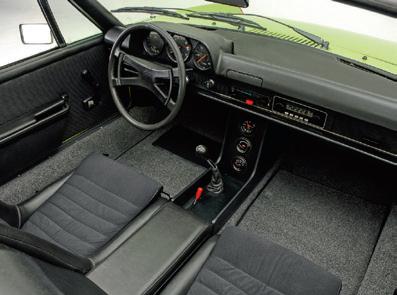
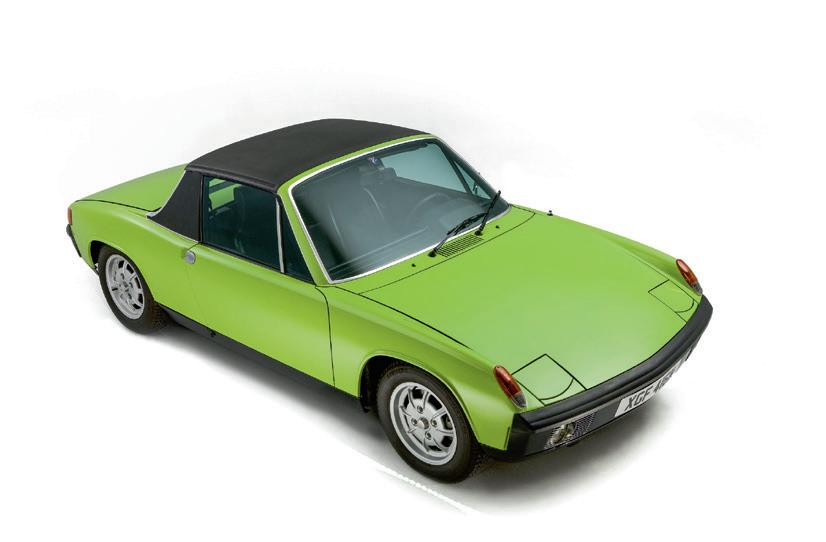
are several key specialists in the US, including Auto Atlanta (www. autoatlanta.com) and Martin MidEngine (www.martinmidengine. com), along with 914 Werke (www.914werke.com), American asking prices tend to be high. Values are lower in Europe, where there are also some excellent specialists such as Mittel Motor (www.mittel motor.de) and Design911 (www. design911.co.uk). Meanwhile, www. elferspot.com is a very good place to see what’s available.
Hagerty Price Guide editor John Mayhead explains: “In 1970 the 914/6 was homologated as the 914/6 GT in preparation for rally and race competition, with a lower, widened and stiffened body, a special motor sport engine and a host of other fuel, suspension and drivetrain modifications. Around 40 were built by Porsche to full GT specification, with a further 200 or so kits sold to convert existing bodies – variously by the
THIS SPREAD
Most examples should be fairly sound inside and out, but beware body bodges and inappropriate engine swaps.
‘Fluid handling and excellent stopping ability let you really exploit the power’
factory, dealers or individuals.”
He continues: “Today, the 914/6 GT is the most collectable of all road-going 914 models. Values vary, with the highest prices reserved for the original 40 full factory GT-spec cars, but M471-option cars [see Timeline] are also highly sought after. The relatively rare 914/6 is also in demand from collectors, and is roughly twice the price of a 914/4. Of these, the 2.0-litre engines command a small premium over the earlier 1.7- and 1.8-litre models.
“The most interesting valuation element is the very large disparity between US and UK values for all variants of the 914. The cars are exceptionally rare in the UK, with a small but supportive enthusiast group. In the US they are much more accepted as a desirable Porsche model – an opinion enhanced by their warm welcome at highly influential events such as Luftgekühlt and RADwood.
“Values in the US of all models
have risen by around 40 percent in the past ten years, but the top of the market may be cooling: the past four 914/6 GTs to be offered at public auction all failed to sell. This included one of the original 1970-71 Porsche Works cars driven by Vic Elford and with Monte Carlo Rally history, offered by Broad Arrow at The Amelia 2024 auction, estimated at $1.2 million to $1.5 million. The outlook is fair: the 914 is not the most beautiful car, but it is nonetheless a very capable driver, unusual, rare and a key part of Porsche’s history.”
Bruce says: “The last 914s were built half a century ago, so any examples that have made it this far are likely to be essentially sound –but beware of tarted-up or bodged cars; it’s easy to get your fingers burned. I’m currently restoring a 914/6, and the more I delve the more I find. Most 914s are cherished and
914 debuts at September’s Frankfurt Motor Show: 914/4, with VW 411 fuelinjected 1.7 engine, and 914/6 with Porsche 911T 2.0 flat-six (both can have semiauto Sportomatic). 1970 sees ’box dropped for 914/4 after only 20 orders. 914/6 to retain Sportomatic option throughout production, but fewer than 50 ordered.
914 on sale in Europe and US at start of year. Latter buyers reasonably keen, but few UK takers when 914 arrives in May. Trackonly 914/6 GT boasts 908 front brakes and beefedup rear chassis section. Crayford RHD conversion introduced at Earls Court Motor Show in October.
Optional M471 package appears for 914/6 in May. Has wide-wheelarch bodykit and 6 x 15in wheels to look like wider 914/6 GT; only around 40 ordered. From August, 914/4 and 914/6 get adjustable passenger seat.
1972
914/6 dropped and replaced by 914 SC in August, (S is 1.7), with Porschedeveloped, enlarged VW Type 4 2.0 four-cylinder motor. Soon after, to avoid confusion, it’s renamed 914 2.0 and S is dropped for 1.7.
1973
In August 914/4’s 1.7-litre unit taken up to 1.8 for 1974 model year. B-pillar sail panel now vinyl as standard.
1974
Porsche buys out VW’s stake in VW-Porsche Vertriebsgesellschaft GmbH. In August, steel bumpers replace rubber items to comply with US 5mph impact regulations.
1975
Final 914 built in December; model replaced by Porsche’s 924 collaboration with VW/ Audi. Delay because 924 isn’t ready, so 912E with 914 2.0 engine and Bosch L-Jetronic fills gap for one model year only, in 1976.

PORSCHE 914 VALUES ARE SIGNIFICANTLY HIGHER IN US THAN UK
All variants of the 914 achieve higher prices in the US than in the UK. Values shown are for a car in Excellent condition in USD ($). US UK
the community is relatively small, especially in the UK, so any example you’re thinking of buying is probably known by long-standing owners.”
According to Kevin, all 914s have the same weak spots, with rust being the most likely problem. The battery tray is usually the first area to go, and once corrosion takes a hold here, the whole engine bay can quickly follow. If left, the rear suspension mountings rot through and the car collapses around its wheels. Also check the sill steps, door bottoms, plus both front and rear boot floors (the rear light seals can leak) and the floorpans behind the seats. Remove the targa top then try to open and close the doors; if the bodyshell is weak you may not be able to close them or refit the roof panel.
All powerplants are generally reliable, and everything is available to effect a rebuild if there are any problems. The correct unit must be fitted, because 914 values are
RIGHT When it comes to 914 values, there is a large disparity between US and UK pricing.
affected by engine displacement. The 1.7-litre motor should have a serial number starting with a W, although from the 1972 model year US examples had an EA code, and from the 1973 model year the Californian US 914s were EB.
The 1.8-litre engine’s number should start with EC for a US example, and AN for European spec, while the 2.0-litre unit begins with GA (US), GB (European) and GC from the 1975-76 model year for US impact-bumper 914s. If the serial number doesn’t begin with any of these, it’s probably a 411, 412 or Type 2 unit, which will significantly devalue the car.
Six-cylinder 914/4s are unusual because of the conversion cost, but they are around. Some American owners have even fitted V8s, but these will always be a 914/4 with the associated Volkswagen Type 47 chassis number; only genuine sixcylinder cars carry a 914 Porsche VIN, which adds kudos.
The 914/4 featured Bosch fuel injection, and while some owners are not comfortable maintaining this set-up, preventative upkeep is possible up to a point. The ideal 914 has the original injection system still fitted and correctly adjusted. While the equipment is reliable, it can go wrong and repairs are expensive – which is why carburettor conversions are not unusual. However, these invariably result in the engine not running as nicely (especially if the original camshaft has been retained), plus fuel consumption will be increased and power reduced.
Potentially more serious are perished rubber fuel pipes in the engine bay. They go brittle, leading to leaks and possibly a burnedout car. Other common problems include seized rear brake calipers, tired rear suspension springs and failed instrumentation, but spares availability is very good. Many parts are still available from Porsche, while a lot of mechanical

1969-1973 (1970-1973 MY): 914/4 1.7
ENGINE NATURALLY ASPIRATED FLAT-FOUR, EIGHT VALVES, 1679CC, BOSCH D-JETRONIC FUEL INJECTION
POWER 80BHP (72BHP IN THE US FOR THE 1973 MODEL YEAR)
TOP SPEED 107MPH
0-62MPH 13.9SEC
1973-1975 (1974-1975 MY): 914/4 1.8
ENGINE NATURALLY ASPIRATED FLAT-FOUR, EIGHT VALVES, 1795CC BOSCH L-JETRONIC FUEL INJECTION FOR NORTH AMERICA, TWIN SOLEX CARBURETTORS FOR EUROPEAN CARS
POWER 85BHP (76BHP IN THE US)
TOP SPEED 110MPH
0-62MPH 12.1SEC
1973-1975 (1973-1976 MY): 914/4 2.0
ENGINE NATURALLY ASPIRATED FLAT-FOUR, EIGHT VALVES, 1971CC BOSCH D-JETRONIC FUEL INJECTION
POWER 100BHP (95BHP IN THE US AND 88BHP FROM THE 1975 MODEL YEAR)
TOP SPEED 117MPH
0-60MPH 10.5SEC
1970-1972 (1970-1972 MY): 914/6
ENGINE NATURALLY ASPIRATED STRAIGHT-SIX, 12 VALVES, OHC, 1991CC TWIN TRIPLETHROAT WEBER CARBURETTORS
POWER 115BHP
TOP SPEED 123MPH
0-60MPH 8.7SEC
bits are shared with other VW and Porsche models. 914 Rubber (https:// 914rubber.com) has reproduced many trim and hardware parts, and Restoration Design (www. restoration-design.eu) offers all sorts of body panels.
Compared with the contemporary 911, the 914 is a doddle to drive quickly. While the former model can easily be provoked into exiting corners backwards at high speed, the latter has ample grip. Placed in the middle of the car, the air-cooled four-pot could take the 914 to 107mph with its modest 80bhp, so if you are a speed demon you will not get your kicks here.
However, the 2.0-litre cars feel far more lively and are even better to pilot, while the 914/6 is the best of all for its spicier soundtrack and extra grunt. Whatever you buy, it should have beautifully fluid handling and excellent stopping ability thanks to disc brakes all round, letting you really exploit the power.
Despite packing relatively little grunt, the 914 tips the scales at under a tonne, so not only is it quicker than you’d think, but it’s fabulously agile, too. The only fly in the ointment is the gearchange;
while the 914 is fitted with a variation of the 911’s transmission, the smaller machine’s tortuous linkage doesn’t make swapping cogs an experience to savour. However, upgrades are possible, and you can adapt to it; from the 1973 model year the early rearshift gearbox was switched to an improved side-shift transmission.
Kevin notes: “Slotting a sixcylinder engine into a four-cylinder car spices things up, but is rarely cost effective. That’s why you’re better looking for a 914/6, although they are not easy to track down, which is the reason why most such conversions have taken place.”
Bruce adds: “I have been around these cars for 30 years and I still love the driving experience, the camaraderie and the interest every trip generates. These models stand out – and people love them as a result. Parts availability is good, and prices can be very low. Throw in easy DIY maintenance and excellent technical help through the clubs, and the 914 is a classic that deserves far more recognition than it receives.”
Many thanks to Kevin Clarke and his 914 Register secretary predecessor Bruce Manning for their help. Both are members of Porsche Club GB (www.porscheclubgb.com).
By John Mayhead, Hagerty
How the ultra-wealthy are swaying record price trends –and what it means for the rest of the collector car market
A FEW WEEKS AGO, I LOOKED at a chart of global auction records that had been created by Hagerty’s US Automotive Intelligence team, and it struck me that until around 2011 the upward progression of prices had been relatively gradual. Since then, it has been anything but – even if the extraordinary €135 million ($142m, £115m) MercedesBenz Uhlenhaut Coupé sale of 2022 is discounted as a one-off.
I decided to dig deeper, and that’s when things started to become interesting. I wondered whether the record had any correlation with top incomes, so I overlaid a Fed chart that showed the US top one percentile annual income. It matched very closely until – you guessed it – 2011, and the global record for a public car auction sale exceeded the average top earnings just once in the preceding 22 years, in 1990. Since 2011, the record has exceeded top earnings nine times. That’s notable, because the record in 1990 was set only weeks before the market spectacularly crashed.
The amount of money being spent on the very top machinery has increased dramatically over the past few years: in the last decade, the number of vehicles insured by Hagerty worldwide and valued at more than $5m has increased tenfold, and so far this year there have already been more cars sold in this price category at public auction than in any year other than 2015.
There’s another element at play here, too: the huge gulf between top prices paid in the US compared with everywhere else. Notwithstanding US buyers purchasing abroad, 19 of the 23 cars that have sold for over $5m this year so far at public auction have done so in the US –an 83 percent dominance. It’s no
surprise that one of the top sales from Monterey 2025 was auctioned there despite long-term ownership in the UK: the 1961 Ferrari 250 California Spider Competizione achieving an above-estimate $25.3m at Gooding Christie’s, smashing the model record. A few days previously, Mecum had announced that Ferrari 250 GTO serial number 3729GT –a car that had previously been offered by a prominent UK dealer – will be featured at its Kissimmee auction in January 2026.
Some may speculate that such an increase in prices, especially in one country, makes this sector of the market inherently unstable, but I think that assessment fails to take into account the huge societal changes that we have experienced over the past two decades. The dominance of the internet and social media, the increase in global trade, the 2008 financial crisis and the Covid 19 pandemic... These events have between them increased the delta between the most wealthy and the rest of society; the ultrarich – those who can drop many millions on a car without a second thought – are now much wealthier in comparison to everyone else, even those who are ‘just’ superrich. Maybe the Fed’s top first percentile is just no longer a high enough bar, and record prices are now set by the top 0.01 percentile. There is also a demographic change, and that’s affecting tastes: in the 12 years between 2005 and 2016 inclusive, Enzo-era Ferraris accounted for ten of the top annual auction sales worldwide. Since then, the record has been held by three such Ferraris, two McLaren F1s, three 1950s racing cars (two Mercedes-Benz, one Aston Martin) and a pre-war car; in other words,
TOP INCOMES VS GLOBAL AUCTION RECORDS
Auction record
Auction record trend
US top one percentile income

ABOVE Will Mecum’s 250 GTO no. 3729GT continue trend set by Monterey sale counterpart?
a total mix. This change in topend tastes came about at the same time as Hagerty started seeing Generation X take over from the Baby Boomers in terms of ownership and purchasing power. So, at the very top level of wealth, dropping $25m-plus on a car maybe isn’t the big deal it once was, and Gen X’ers seem to have an eclectic taste. While in the leading paragraph I dismissed the Mercedes-Benz Uhlenhaut Coupé sale of 2022 as a one-off, maybe it could actually be a taste of things to come.


By Jonathon Burford
The 3940 kicked off Patek Philippe’s modern era and set a course that the brand still follows today
TWO DIFFERENT YEARS CAN be identified as the end of the vintage era and the beginning of the modern era for Patek Philippe. For many it is 1989: the brand’s 150th anniversary, when it introduced the defining Calibre 89, along with the references 3974 perpetual-calendar minute repeater and 3979 repeater only, combined with the groundbreaking Art of Patek Philippe Antiquorum auction in Geneva. Yet, for me, 1985 marks the beginning of modern Patek. That year, Philippe Stern stewarded the introduction of two references – the perpetual calendars 3940 and 3970 (the latter with a chronograph) – and set a course that Patek still follows today.
This was a bold move. The Swiss mechanical watch industry was only just emerging from the Quartz Crisis. Many brands were simply looking for ways to survive, adapt and navigate uncharted waters. Stern, however, was in a unique position: because his family owned Patek outright, he could make long-term, far-reaching decisions, while many other companies were focused only on immediate survival. What Stern launched in 1985-86 kicked off the era of Patek’s serially produced high complications at a time when many brands were bowing to the Quartz revolution. Until then, references such as the 2499 were made virtually to order, with only around 360 examples of the reference produced over 35 years (and some 600 of the ref 3448 made from 1962-81). By contrast, up to 7000 ref 3940s were created from 1985-2007, along with around 4000 ref 3970s over 19 years.
The 3940 redefined Patek’s design language for the next 30 years. The simplicity and elegance of its layout – and its distinctive typography – remain extraordinarily timeless. Gone were the cut apertures above the hands on the 2499 and 3448 for day/month displays, to be replaced by day/date/month and leap-year indications set within sub-registers. It was so sophisticated and forwardlooking, you can still see its influence in today’s Patek line-up, with the ref 5327 barely an improvement on the perfection of the 3940 original.
The dial’s genius was matched by one of the great modern movements. The Calibre 240 began as an offcentred micro-rotor movement used
in an Ellipse model, but Stern saw an opportunity. He added a perpetual-calendar module, while managing to retain its remarkable slimness (3.75mm). This brilliant movement still powers the modern ref 5327, among other references.
Fortuitously, the 3940’s launch coincided with the 225th anniversary of Zurich retailer and Patek partner Beyer Chronometrie. The first 25 examples celebrated this milestone and relationship. Each dial bore the retailer’s name and an individual number beneath the moon-phase indicator. These spectacular pieces, with their golden dials and enclosed snap-on case backs (a vestige of the vintage era), are among the most coveted of any modern Patek.
After the Beyer edition, Patek made the 3940 in four series, each with small visual differences. The first featured solid case backs, hallmarks on the case flank at 9 o’clock and recessed sub-registers. The second had bevelled subregisters and a larger signature. A cross separated the third’s leapyear indication, and the fourth bore the ‘Sigma’ dial designation and non-serif typography.
Still comparatively undervalued given their importance and rarity, the reference is attracting growing interest. Beyers can reach $300,000plus; good, unpolished first-series pieces are increasingly accessible only to the most well funded and dedicated collectors. The third and fourth series, however, remain relatively available and affordable (particularly the slightly less desirable Roman-numeral variants).
Cases can soften around the lugs and lose hallmark definition with repeated polishing, but dials rarely develop patina (other than the golden-dial versions). Study the case proportions and check for the original certificate if possible. Post’97 examples used deployant clasps rather than buckles (I believe as a dress watch it is best worn with a buckle). While I generally gravitate toward white-metal dress watches, a crisp first-series example in yellowgold must be considered one of the most charismatic and desirable ‘modern’ Patek Philippes ever made. Writer Jonathon Burford is SVP and specialist at Sotheby’s watch department. For its ongoing watches sales, see www.sothebys.com.
By Rupert Whyte
FOR AS LONG AS JOEL CLARK can remember, he’s been drawn to creativity. From an early age he felt instinctively artistic. After finishing school in the early 1990s, he enrolled in art college, exploring a wide range of disciplines: fine art, painting, drawing, photography, sculpture and graphic design. It was the last of these that ultimately captured his imagination, leading him into a career in advertising. He worked first as a creative, then as a creative director – a path that took him from London to Melbourne, then to Dublin and finally back to London again. Before art college, Clark spent three months on a Youth Training Scheme with a sign-making company near Silverstone race circuit. The company supplied decals and liveries for touring car, rally and Formula 3 teams. “This was before computerised vinyl cutting,” he recalls. “Anything that wasn’t a standard font had to be cut by hand – brand names, logos, everything. In three months I learned to use a scalpel to hand-cut just about anything.”
Years later, while working as a creative in Melbourne, that skill resurfaced. “As a team-building exercise, we were asked to create a portrait of a colleague. I made mine using hand-cut vinyl, so the final piece was essentially a giant sticker.” His team was blown away – none of them had ever seen anything like it. That moment planted the seed: one day, Clark thought, he would make art this way full time.
After the 2008 financial crash, freelance work in advertising became increasingly hard to find. Joel persevered until 2013, but by then the passion had gone. “Work was drying up. I wasn’t enjoying London anymore, and I wasn’t enjoying advertising,” he recounts. “One morning I woke up and thought, it’s now or never – I’m going to be an
Joel Clark’s striking hand-cut artworks are playful, bold and unapologetically graphic
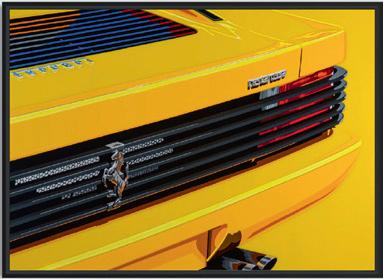
ABOVE Clark’s vividly coloured signature style works just as well on automotive parts as it does in the two dimensions seen here.
artist full time and make it work.”
From the start, Clark’s goal was to do something different. Hand-cut vinyl as an artistic medium was virtually unexplored at that time. Its bold, graphic quality and flat, vivid colour perfectly suited his vision – and it became his signature style.
In addition to his traditional two-dimensional artworks, he often turns automotive parts into his canvas; doors, bonnets and other panels transformed into striking works of art. His pieces explore the relationship between the car and the world it inhabits – past, present or imagined. A Porsche 928 bonnet might carry
the mirrored reflection of Lloyd’s of London, a Porsche 908 door might capture the essence of the Spa-Francorchamps circuit, while a fragment of a Porsche 917 or a Renault Formula 1 engine cowl could be reimagined with racing livery and light reflections.
“It’s up to the viewer to interpret what they see,” Clark explains. “Each piece offers clues, but the story is yours to create. My work is meant to make you stop, look closer and really think about what you’re looking at.”
His latest collection takes the form of oversized stickers inspired by the iconic designs of 1980s and 1990s events, teams and races. Each piece is mounted and framed while still on its original backing paper, preserving its identity as a real, physical sticker. This series pushes his use of vinyl as a medium to its fullest expression – playful, bold and unapologetically graphic. Prints of Clark’s work start at £50, while his oversize stickers are priced from £130.
Writer Rupert Whyte runs Historic Car Art, www.historiccarart.net, selling original works and posters.
By Nathan Chadwick
Just as with the classic car world, the demographics of collectable video games are reloading. We find out more
VIDEO GAMES HAVE NEVER been bigger, with gaming now embedded in the mainstream. But while you might think that the latest and greatest titles, offering better graphics, ultra realism and complex game mechanics, might dominate, that’s not really the case.
Retro games have transitioned from being a niche to something publishing studios see as a core market, as retrogames.co.uk’s Jason Moore explains. “There’s now much more coverage – on YouTube, for example, retro gaming content is everywhere,” he says. “Companies are constantly re-releasing titles or producing remakes. Older material is often used to inspire new games, driving interest in the originals.”
Jason points to Silent Hill as a good example – the fresh remake for the Sony PS5 is bringing new people into the hobby because of the reviews, and the videos and coverage it attracts. This fuels interest in specific formats – the original Silent Hill came out on the PS1 in 1999.
Other factors drive the push for old formats, too – essentially, new games’ always-online nature and constant updates. “On the PS5, the disc is just the trigger to download the 150GB game from the web, and older gamers don’t like that,” Jason explains. “Another factor is that new games are huge. In the PS3 era, you could complete one in 30 hours, and now it’s a selling point if a game takes 150 or more. Adults rarely have that kind of time; few want to sink so many hours into a single title – we get bored and move on.”
That same sense of moving on applies to gaming systems from the very dawn of the hobby, such as the ZX Spectrum. “The next generation are not interested, and as people

pass away, there are fewer collectors – it is difficult to persuade someone who grew up with PS1 to go back to the ZX Spectrum, ZX81 or Atari. They are so far removed from what modern players are used to,” Jason says. “Spectrum and Commodore fans love those systems, but many already have full collections. They have every game they played as a child, every game they wanted and every game they did not want. I sold a ZX81 game this year for £1000, so there is still money in tapes, but it must be pristine and extremely rare.”
So what’s hot right now? “As more generations are added, the collectors move along. Those who collect ZX Spectrum games and cassettes from the early 1980s are still there,
ABOVE A mint
Super Mario 64 from 1996 sold for a record-breaking $1.56 million in 2021 – so don’t throw your old games away just yet...
‘For more modern retro games, it is the special editions that are most prized’
still active, but there is also a new wave of nostalgia,” he says. “We’ve gone through the Sony PS1 now and the PS3 has suddenly become a collectable format, and PS2 and Xbox 360 titles are booming.”
However, while this has helped the wider scene grow, the most valuable items remain the earlier boxed systems such as Nintendo’s NES and SNES, and Sega’s Mega Drive. Jason is also seeing a trend for collectors coveting sealed games, but for the older consoles, such as Atari, SNES, NES and N64, cardboard boxes are the key factor: “Take Paper Mario on the N64 – a clean copy might get £150, but one with a near-perfect box is £800 to £1000, and a sealed copy could fetch £10,000. If you look at the NES, a common title such as Super Mario Bros 3 in nice condition might be £50, but a perfect example could fetch £300. It all comes down to how the cardboard was kept.”
For more modern retro games, it is the special editions that are most prized – versions with a steelbook case, a collector’s action figure or a remote-controlled car. “There was a Grand Theft Auto box set that regularly sells for £500 because it is full of extras, including a cigarette lighter,” Jason explains. “These are only ever going to go up in value.”
Often, the game doesn’t have to be good to be valuable. “The Nintendo Wii U Luv Me Buddies filled bargain bins when new, yet now it’s worth £200-£300,” he says. “I once bought a job lot of 60 Game Boy Advance games called Urban Yeti! It was terrible, and I sold them for £1 each. They now sell for £250-£500.”
For Jason, that is the fun of collecting: “There is still the chance to stumble across hidden gems…”

Compiled by Nathan Chadwick and Sophie Kochan

SCALEXTRIC 1963
MONACO GRAND PRIX
This limited-edition box set recreates one of the principality’s greatest-ever duels: Lotus 25 vs BRM P57 – Jim Clark vs Graham Hill. It is priced at £109.99. https://uk.scalextric.com

PININFARINA NIDO CHAIR 95
Made to mark Pininfarina’s 95th year, the Nido boasts the design house’s logo as a functional element to move the chair.
The Elegant PF grey 95 leather trim is inspired by sports car interiors, and the cost is €3355. https://shop.pininfarina.it

A LANGE & SÖHNE SAXONIA DATOGRAPH PERPETUAL TOURBILLON
This boasts three major complications: a flyback chronograph with a precisely jumping minute counter, a perpetual calendar with a moon-phase display and a tourbillon with a stop seconds mechanism. With the L952.2 calibre, a white-gold case and a pink-gold dial, it’s limited to 100. POA. www.alange-soehne.com
This blanket pays tribute to both Range Rover’s design ethos and modernist art. It’s crafted in Italy in a mixture of wool and cashmere, and costs £950. http://shop.landrover.co.uk
Get into the Christmas spirit with a 911 that doesn’t involve lift-off oversteer, a hedge and the Holy Ghost. This knitted cotton jumper is available in sizes XS to 3XL, and is priced at £112. http://shop.porsche.com


This 1:24-scale plastic model kit has clear body parts that show a wonderfully detailed interior and tubular spaceframe, as well as a host of other details. Its moveable gullwing doors can be locked in position, and it has a working bonnet, too. The cost is £49.99. www.tamiya.com

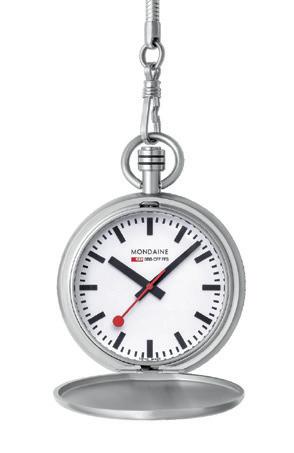
Launched on August’s Swiss National Day, this watch is an homage to Swiss engineer Hans Hilfiker’s official Swiss Federal Railways station clock. Its 48mm stainlesssteel case houses a Swiss Quartz movement. Costing £380, it’s limited to 200 pieces. www.mondaine.com

MERCEDES-AMG X ADIDAS
ADIZERO EVO SL AMG SHOES
Launched to mark the Concept AMG GT XX’s record EV heroics at the Nardò, these sneakers feature a unique pattern on the traditional three stripes, plus Adidas LightstrikePro super-light cushioning tech. They cost £140 in UK sizes 5-12.5. www.adidas.co.uk

AMALGAM ASTON MARTIN VALKYRIE
Exclusive to 199 pieces, this 1:8-scale model has been developed over 3000 hours using Aston’s original CAD designs, paint codes and material specs. Each takes 300 hours to build by hand and features Podium Green paint with an all-black exterior. Bespoke finishes are available. It is priced at £14,750. www.amalgamcollection.com

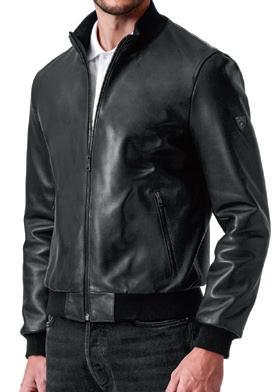
BREITLING CHRONOMAT B01 TITANIUM
Limited to 100 pieces worldwide, this celebrates 140 years of Breitling and 100 years of Watches of Switzerland. It measures 42mm and is constructed from titanium, a first for 2025’s Breitling collection. It houses the B01 Manufacturer automatic calibre, and has a green dial and anthracite sub-dials. Cost is £10,100. www.watches-ofswitzerland.co.uk
AUTOMOBILI LAMBORGHINI LEATHER BOMBER JACKET
Made in Italy, this bomber jacket features a custom metal shield logo on the left sleeve, metal front and pocket zips plus an inner zip. It’s available in sizes XS to XXL and costs £703. www.lamborghinistore.com

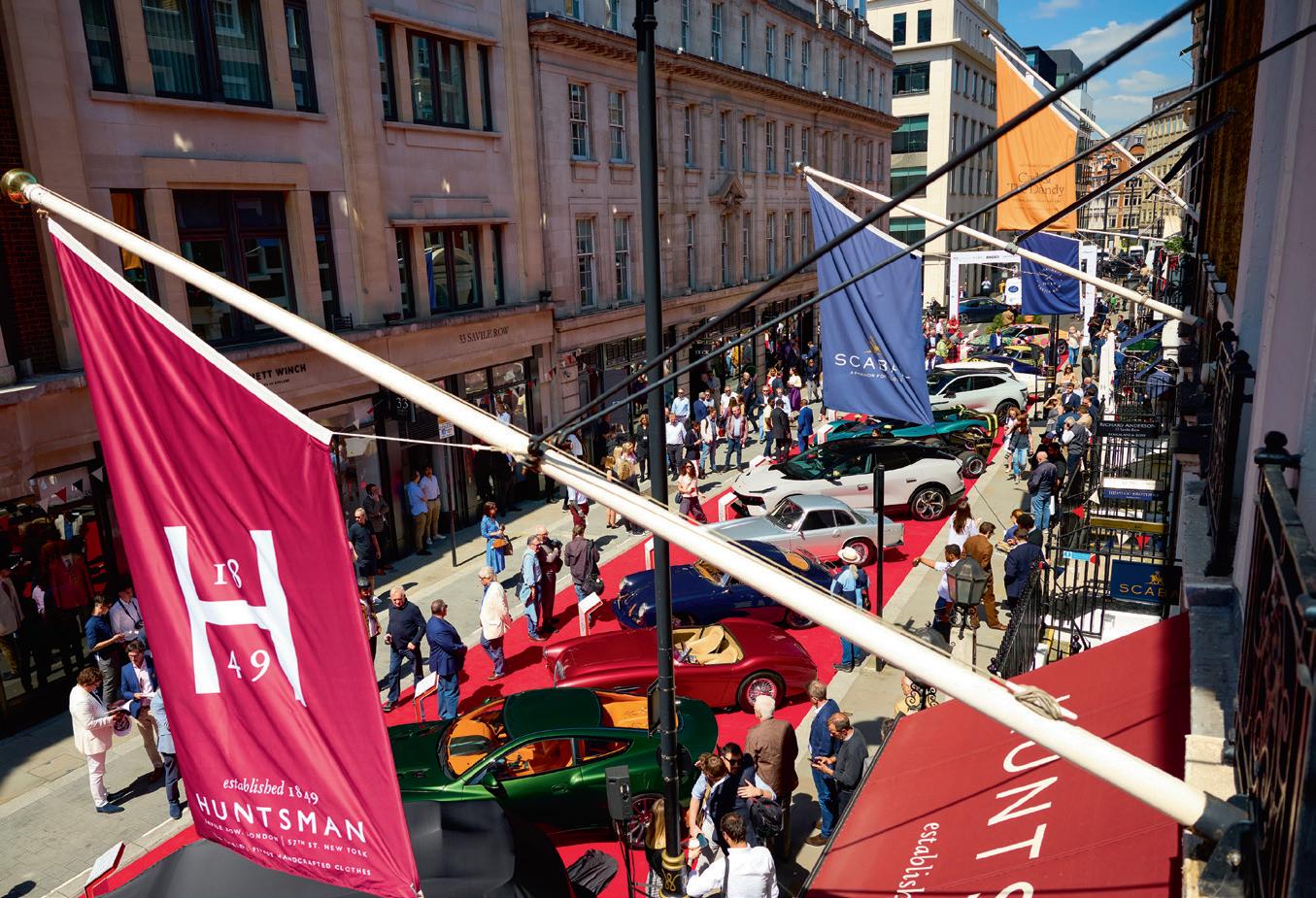
Wednesday May 20 – Thursday May 21, 2026
Wednesday May 20 – Thursday May 21, 2026
Wednesday May 20 – Thursday May 21, 2026
www.concoursonsavilerow.com
Wednesday May 20 – Thursday May 21, 2026
May 22 – Thursday May 23, 2024
www.concoursonsavilerow.com
Wednesday May 22 – Thursday May 23, 2024
Wednesday May 22 – Thursday May 23, 2024
Wednesday May 22 – Thursday May 23, 2024
22 – Thursday May 23, 2024
www.concoursonsavilerow.com
Wednesday May 22 – Thursday May 23, 2024
Wednesday May 22 – Thursday May 23, 2024
Wednesday May 22 – Thursday May 23, 2024
Wednesday May 22 – Thursday May 23, 2024
Wednesday May 22 – Thursday May 23, 2024
Wednesday May 22 – Thursday May 23, 2024
www.concoursonsavilerow.com
www.concoursonsavilerow.com
www.concoursonsavilerow.com
Wednesday May 22 – Thursday May 23, 2024
www.concoursonsavilerow.com
www.concoursonsavilerow.com of the greatest cars and the finest tailoring in the heart of Mayfair. Free to visit, 10am – 8pm
www.concoursonsavilerow.com
www.concoursonsavilerow.com
www.concoursonsavilerow.com
days of the greatest cars and the finest tailoring in the heart of Mayfair. Free to visit, 10am – 8pm
www.concoursonsavilerow.com
www.concoursonsavilerow.com
www.concoursonsavilerow.com
www.concoursonsavilerow.com
Two days of the greatest cars and the finest tailoring in the heart of Mayfair. Free to visit, 10am – 8pm
Two days of the greatest cars and the finest tailoring in the heart of Mayfair. Free to visit, 10am – 8pm
www.concoursonsavilerow.com
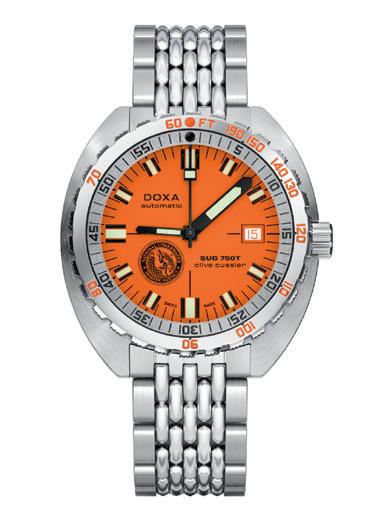
Marking what would have been Clive Cussler’s 94th birthday, this watch is limited to 94 pieces. The 45mm stainless-steel case is slimmer than before, at 11.95mm, yet still offers 750 metres of water resistance. A portion of the proceeds go to the novelist’s maritime preservation foundation NUMA. It’s priced at £2690. www.doxawatches.com
Ferrari is offering genuine used F1 parts, ranging from valves to brake discs. This V10 camshaft from the Schumacher/Barrichello Championship-winning F2003-GA is mounted on a Ferrari Style Centerdesigned aluminium and transparent methacrylate stand. The price is £7300. www.store.ferrari.com

DUNHILL BULLDOG KEYFOB
This keyfob is made from polished dark ruthenium-plated brass, and is embellished with the Alfred Dunhill logo. It costs £280. www.dunhill.com/gb



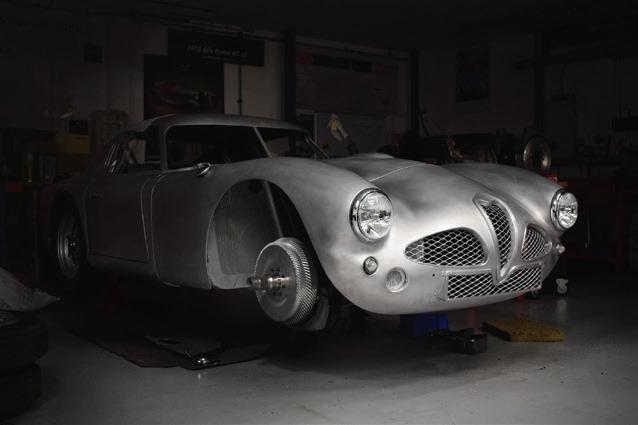
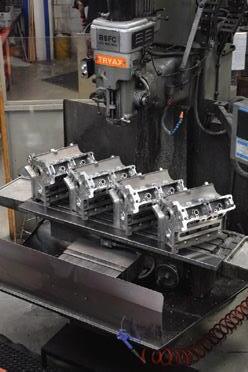











By Nathan Chadwick
This epic, three-volume follow-up to Figoni’s Alfa Romeo endeavours is as beautifully crafted as its subject matter
WITH A REPERTOIRE OF beautifully crafted Bugattis to his name, Joseph Figoni deserves a publication that reflects that grandeur – and this three-volume set from Peter M Larsen and Ben Erickson is certainly that.
Volume one was dedicated to Figoni’s Alfa Romeo artistry, but here his designs for Bugatti take up three volumes, 1128 pages and 1213 images. That it is a self-published passion project for the authors becomes clear as soon as you open it – the production quality is sublime. The content is equally top notch.
The first two parts of volume one cover the life of Figoni up to 1930, when Bugatti had distanced itself from the carrosserie directly. While the story has been told many times before, there is a host of documents, archive material and insight hitherto unseen, with detailed patent drawings, production records and much more.
The grand narrative makes for engaging reading, too; this is not some dry retelling of history. There are wonderful profile drawings from Gerrit-Jan Caviët, who sadly passed away just prior to the book’s publication. Arguably the most engaging part of the three volumes is the Type guide, with detail on each chassis – even if an image of the actual platform is unavailable,
‘A must for avowed fans of both Bugatti and Figoni: it’s a delight to behold’
there are sales ledgers and often ownership histories. And where there are pictures, it’s a true feast of period and more recent imagery.
This detail is just extraordinary, with beautifully researched vintage photography bringing the words to life – a coachbuilt Bugatti was not a frivolous purchase, and some of the names and stories are fascinating. It’s these little diversions that really add depth – and further rabbit holes of investigation.
There is, of course, plenty to enjoy in more storied cars, with their tales being allowed proper space to breathe: one could spend a full day luxuriating in the tale of chassis 55221 – the Type 55 Le Mans car of Guy Bouriat and Louis Chiron. There’s a wealth of pictures and documents from not only that race, but also its competition life beyond.
Although Figoni would not have the close relationship with the marque that he’d enjoyed prior to 1928, the 1930s saw several Bugattis head to the carrosserie. Here too there are grand narratives: the story of Type 57 SC Atlantic chassis 57473, including its fatal altercation with a train and long restoration efforts (in the plural), makes for truly engaging reading, especially when you see pictures of what was left of this Bugatti in the 1960s. Its eventual rebirth, courtesy of Paul Russell, is captured wonderfully by lensman Michael Furman, and the car was displayed at the 2010 Pebble Beach Concours d’Elegance.
Beautifully written, exquisitely produced and a delight to behold, this €650 book is a must for avowed fans of both Bugatti and Figoni. Be quick, though, because it’s limited to 600 editions. www.moteurs.dk/bugatti
THIS PAGE The beautifully written and exquisitely produced 1128page tome costs €650 and is limited to 600 editions.




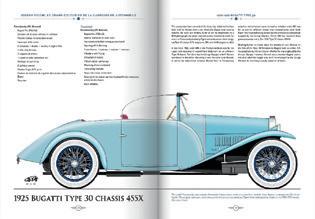
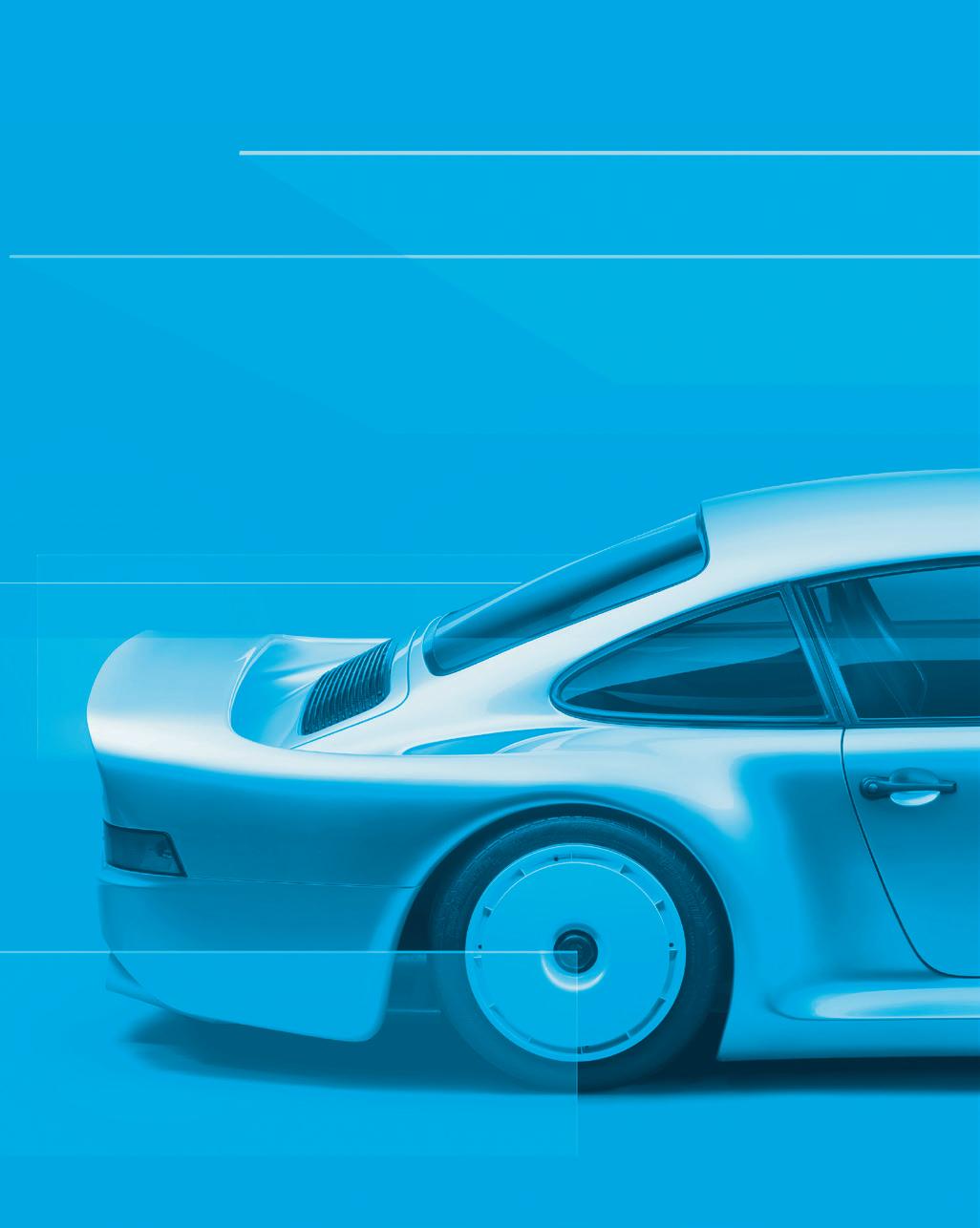
The tale of this unlikely but beloved underdog makes for entertaining reading courtesy of a true insider


ON PAPER, IT’S AN UNLIKELY story: select the smallest car in the MG Rover line-up, take it to Williams, choose natural aspiration against the forcedinduction norm, and go rallying.
The MG Metro 6R4 wasn’t the most successful Group B car, but to this day it’s certainly one of the most loved. It made a suburban shopping cart into a bewinged hyper-horsepower monster, and its tuneful V6 howling through the trees stayed long in the memory.
This wonderful 444-page book features contributions from Austin Rover Motorsport engineer Wynne Mitchell and motor sport director John Davenport, alongside Reinhard Klein. As such, it contains behindthe-scenes imagery and drawings,
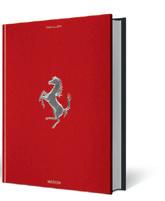
THIS exquisitely put-together tome gathers archive materials from Ferrari itself as well as from collectors, to provide a glorious overview of the brand’s life story. The Tifosi hardcore might not find much that’s new to add to a Ferrari-themed library, but Pino Allievi writes engagingly over 688 pages, and the wealth of historical imagery is a delight to behold. At £125 it provides good value for money, and the appendix of all Ferrari wins since 1947 will please the completists. www.taschen.com
and a blow-by-blow account of the whole project from beginning to end.
Although the car wouldn’t make its debut until 1985, the germ of the idea had persisted since 1981. The fact it exists at all is amazing, considering the minimal budget that was bolstered only by selling off a load of unused TR7 equipment. Along the way there are charming stories of simply trying things –the 6R4’s wings only came about after a spare Formula 1 panel was tried during a lunch break midwind-tunnel test. It’s these human touches, of which the 6R4 story has many, that truly endear; even brief asides such as Tony Pond blasting around the Estoril circuit with Jonathan Palmer riding shotgun in the dark raise a grin. It was a much

WORK began on this second edition of the Simeone Foundation Automotive Museum’s collection overview just as the first volume was published, and it now stands as a tribute to the late Dr Fred Simeone, who wrote the original guide himself. Updated by Harry Hurst, it details some of the world’s most storied cars that make up the collection. Beautifully illustrated by Michael Furman’s lens over 444 pages, this $195 book is far more than a museum catalogue: it’s a fitting tribute to a legendary collector. www.simeonemuseum.org
freer age, despite the tragedies that the writing team don’t flinch from. The images of Malcolm Wilson’s Acropolis Rally testing shunt leave the reader under no illusions that sometimes survival was down to sheer luck. There’s also a fascinating section on old-school big-budget rallying – using aeroplanes to coordinate the vast army of cars and resources. It’s all very different these days, but this book is a reminder of just how analogue things still were, even into the mid-1980s.
Much of the book is compiled from Wynne Mitchell’s extensive note-taking in period, and there’s plenty more to enjoy, too. There are interviews with key players such as Didier Auriol, Patrick Head, Jimmy McRae, Malcolm Wilson, Tony Pond

WE covered the first part of this fourvolume series, limited to 750 copies, a couple of issues ago; it started with an in-depth chassis guide. In this section, the four authors cover the Ferrari vs Ford background, the setting up of Ford Advanced Vehicles in Slough and the challenging 19631965 series. With a host of interviews with key staff, some of which are previously unpublished, this has to be a must for GT40 fans. The 576-page book costs £325, although several special editions are available. www.porterpress.co.uk
and many others – plus a rally-byrally guide to the car’s Works exploits, and details on post-1986 endeavours such as the ParisDakar Rally and national events.
However, it is the extensive photography of these machines being built, tested, driven and occasionally bent that really makes this unmissable – if you find yourself siding with plucky underdogs, you will feel at home within this book’s pages. Moreover, if you’re a fan of Group B rallying, and not just the Metro, this is great value at €235.
The 6R4 might not have been the ultimate winner hoped for, but this is a fitting tribute to not only a highly endearing car, but also to the dedicated team who crafted it. www.rallyandracing.com

THE loss of Greg Moore in October 1999 was a devastating one for CART. It was a deeply sad ending to one of the most intensely competitive seasons American open-wheeled racing had seen, with a host of home-grown talent facing off against hungry young racers from across the globe. John Oreovicz’s pacey 320-page tome conveys not only the excitement of that season, which went down to the wire, but also the racing duels fate denied Moore and, more widely, motor sport in both the US and abroad. It costs $34.95. www.octanepress.com
















ASTON’S
may be primarily focused on Formula 1, but the attention the marque’s Valkyrie endurance car is receiving despite so-so results is proof that GT racing is what really adds the competition allure.
The subject is close to Palawan Press founder Simon Draper’s heart – he’s a serious Aston Martin collector, and this passion for the breed is exemplified by the tome’s truly exquisite production values. Given the price – more on which later – that should be expected, but even before you dive into the words and photography it is an olfactory delight thanks to the quality of the inks and printing.
And when you do get to the words and pictures, they are an

IN 1969, Sir William Lyons addressed the Institute of the Motor Industry about the history of Jaguar and the future of the specialised car trade. This speech, delivered on the eve of the launch of the XJ6, forms the bulk of this 128-page book, which provides a fascinating take on both Lyons’ company and wider matters. Beautifully designed by Julian Balme with evocative period imagery, and aided by Giles Chapman’s insightful commentary, this £50 tome is a great insight into the type of person we are unlikely to see again. www.evropublishing.com
Beautifully detailed look at the DB4-on era of machinery that still resonates with Aston lovers
absolute treat. Stephen Archer and David Tremayne tell the story of the factory-built and -run GTs, from the DB4 through to the DP212-214 cars and beyond, with the ultimately ill-fated Aston-engined Lola for the 1967 Le Mans effort.
The construction, competition career and ex-Aston ownership of each machine are thoroughly explored, backed up with wonderful photography, while the behindthe-scenes black-and-white factory images are elevated beyond mere construction shots to art pieces in and of themselves. The colour shots are really worth savouring as well – an image of a DB4 Zagato versus a Ferrari 250 GTO-packed grid at Montlhéry burns into your retinas. So too do the testimonies, stories

WAYNE Carini has had quite a ride – immersed in the restoration world from his very beginnings, he has now become one of the world’s most well known car guys courtesy of his Chasing Classic Cars TV show. Such widespread stardom came relatively late, so this engaging 176-page book is a welcome deep dive into his history and passions. Boasting a wealth of personal archive pictures – including an eyeball-searing shot from Formula 1 – and entertaining memories, this is great value at $59. www.daltonwatson.com
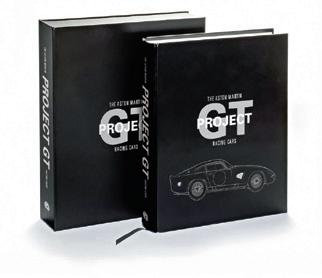
and antics relived throughout the book. There’s the time that, having beaten Ferrari on home turf, Aston mechanics stormed Enzo’s party, sank most of his booze and got him to sign the empties. Or what about the saga of DB4 GT 0167R, which starred in a Peter Sellers film and now belongs to Aston Martin F1 designer Adrian Newey’s collection? Add stunning, specially created works of art in between the archive images, and the book soon moves beyond a mere publication into something rather more.
Seasoned Aston devotees may have read interviews with the key players before elsewhere, and seen the Goodwood 250 GTO vs DB4 Zagato crash images many times, but pulling it all into this

TOM Molloy grew up in a family steeped in motor racing, through his father’s racetrack ownership and racing team. However, he instead went into the construction industry – yet the itch to get behind the wheel never went away. At 52 he started in Historic motor sport, and he ended up amassing one of the world’s finest collections of racing cars. This rousing story is well told by Jake Grubb over 368 pages. Limited to 500 copies, the $95 book is probably more galvanising than any online self-help course. http://themalloybook.com
magnificent production makes for a supremely enjoyable package.
It is not an inexpensive one, however, and a mere 315 are being published in total. There are 250 standard clothbound editions that start at £750 for the first 150 copies, £1000 for the next 50 and £1500 for the final 50. Then there are 50 leather-bound editions – £1750 for the first 25 copies and £2500 for the final 25, plus 15 Chassis editions, which are numbered in accordance with the cars’ chassis numbers (price on application).
This is a book for dedicated Aston Martin enthusiasts then –but whatever price you ultimately pay for it, it’s highly unlikely that you will be disappointed. www.palawan.co.uk

F3000 carried on the traditions of F2 in bringing a host of talent to the fore. The number of names that went on to F1, endurance racing, touring cars and even team management is startling. Beautifully researched by James Newbold, with 100 interviews with key players, plus spectacular imagery, this 416-page book is an excellent season-by-season account of one of the most exciting openwheeler championships ever during motor sport’s arguably most popular era. Excellent value at just £75. www.evropublishing.com
Since 1968


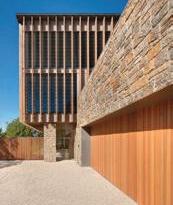
Domestic, listed & heritage, special projects and commercial projects Made from solid timber, aluminium, brass or glazed Insulation is also available if required.

UK: (+44) 151 280 6626
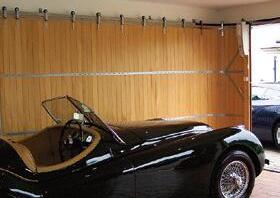

info@rundum co uk rundumgaragedoors co uk
North America: (281) 863 9448 info@rundummeir com rundummeir com


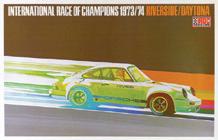
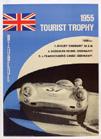

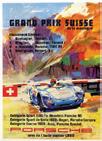



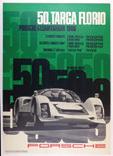
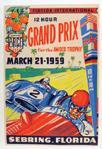


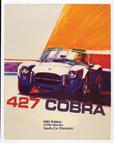
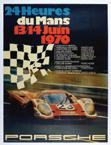
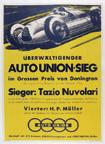

BOOK REVIEWS
Classic styling with modern underpinnings. The ultimate restomods, or something else entirely?
on Ferrari lineage takes serious brass neck and an extraordinary willingness to engage in legal back and forth. Then again, Lord Bamford is hardly the usual Brit in a shed with Maranello dreams and a minuscule budget. His ‘shed’ incorporates the vast resources of the JCB empire, and he has owned and continues to own some of the most valuable Ferraris ever created – including two 250 GTOs. However, as experienced by many a classic Ferrari owner, his dreams of European jaunts in actual Maranello machines usually fell short... Invariably beside the autoroute, covered in oil, water or a mayonnaise-like mixture of both.
In the 1990s, Lord Bamford set

COBRAS: THE BUILDING OF THE LEAF SPRING CARS
ROBERT D Walker takes an exhaustive look at the construction of the early AC Cars-built Cobras, yet this 400-page, $175 volume is far more than a retelling of history. It’s a hyper-detailed deep dive into every facet of these early cars, sourced from leading Cobra authorities. As such, this isn’t really a book for casual marque fans, but that is a good thing – it really gets into the nitty-gritty. If you’re a Cobra owner or thinking of buying one, it’s a highly recommended purchase. www.daltonwatson.com
about crafting three cars that would use relatively modern, fuel-injected donors in bespoke bodies designed by a mixture of freelance talent and JCB’s in-house styling staff, and brought to life by the cream of UK engineering talent. It’s all chronicled here in James Taylor’s 160-page, £40 book – from initial inspirations through to sketches and behindthe-scenes construction processes.
Avowed fans of the Fioravanti 400i might want to skip a few pages, but the memories and tales from those involved elevate this volume to a true story of determination through artisanship and engineering. What instantly becomes clear is that this is far more than a whim for Lord Bamford; his passion for the Ferrari marque, as well as for the
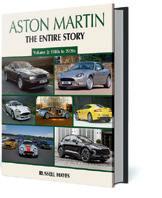
THIS two-volume book from Russell Hayes takes a long look at a marque for whom ‘rollercoaster ride’ would be underselling things. As such, it makes for an excellent underdog narrative that suits the British way of doing things, rightly or wrongly. While hardcore Aston types will know most of the story, there’s plenty of insider insight to make this 704-page, £195 book a highly recommended purchase for those seeking to look beyond the latest negative headlines. www.evropublishing.com

engineering and design that went into these cars, is abundant. After all, building a replica 250 GTO with modern-ish underpinnings is relatively straightforward. Instead, he wanted to create unique cars that could have come from the pen of Pininfarina and the workshops of Scaglietti. Over the years many have tried and most have fallen short, but thanks to Lord Bamford’s careful guidance throughout the projects, the results represent a close approximation of what might have come from Ferrari at the time, albeit filtered through a British lens that draws on wider inspiration.
It is the final car, the Pinin Farina Coupé, that is the bravest, yet also the most compelling of the three

FORMULA 1 TV commentator Alex Jacques takes a broad look at the defining moments that have shaped F1’s 75-year ride at the pinnacle of motor sport. Dedicated F1 historians will find out little new, but for those whose knowledge beyond ‘their’ era of F1 is scant, this is a great way to learn more about the legends that shaped the sport. This 320-page, £10.99 volume is great value for those coming in as relative newcomers – and older hands may learn a few new things along the way, too. www.mombooks.com
models. Designed as a tribute to the Speciale cars built by Pinin Farina in the late 1950s, but also drawing inspiration from the 1957 Boano Coupé, it differed from its earlier stablemates in that it used underpinnings taken from a contemporary 250 GT Coupé. It was also produced much later than the others, coming to fruition in the 2000s. Sadly there is no mention here of the 456-based 275 NART Spyder project from Lord Bamford’s son George, which is a shame. What Ferrari itself makes of all this isn’t clear, but nevertheless it’s a fascinating tale of making perhaps the ultimate petrolhead fantasy –that of a truly bespoke Ferrari –become reality not once, but thrice. www.porterpress.co.uk

THE FERRARI UNDER THE BED
DARRELL Westfaul owned Ferrari 166 MM chassis 0046M for 40 years, starting in his 20s with little more than a shell with a Chevy engine. He brought it back to life and spent years tracking down its globetrotting history. Turned out that along the way it had been driven by Nuccio Bertone in the 1950 Mille Miglia – and it changed bodies three times, becoming a rolling history of Italian carrozziere. This 288-page, $125 book is a touching portrait about how a car can become more than the sum of its parts. www.daltonwatson.com
1917 American LaFrance Type 12 Roadster A Rare Piece of Automotive History
Powerful, Full of Character, and Impressive this 1917 American LaFrance Type 12 Roadster is much more than just a classic vehicle – it’s a monument to American engineering and a tribute to the early days of the automotive era.

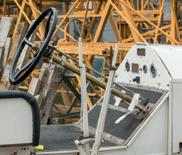



Originally built as a fire truck, this vehicle was meticulously converted by hand into a roadster – a transformation popular among collectors both then and now. The result is an impressive monster engine mounted on an open chassis that combines commanding presence with classic elegance. Vehicles of this type and era are extremely rare today, especially in drivable condition.
The American LaFrance 12 is not just a showstopper – it’s a true road-going experience and a piece of living history. Ideal for collectors, vintage rallies, or museum exhibitions. With its imposing size, the deep growl of its large-displacement engine, and the open cockpit, every drive is a spectacular event.
Further information about the vehicle – beppi.dillier@chernmatt.ch

























































































An update to UK classic car registration regulations still raises questions, as our legal expert outlines

THE UK’S DRIVER AND VEHICLE Licensing Agency (DVLA) deals with many thousands of applications on a daily basis in a timely and efficient manner. Its principal duties consist of overseeing the registration and licensing of vehicles and drivers, as well as the collection and enforcement of the payment of road tax.
In the case of historics, the DVLA is responsible for dealing with issues consequent upon repair, restoration, modification and import. Increasing values in the classic arena, and the need for historical accuracy, have placed a burden on the agency that it could not reasonably have anticipated. It is debatable just how much training any of the employees might have been given in determining which of either an imaginative narrative of a vehicle’s heritage, or an honestly drawn account with verifiable supporting period documents, might be preferred.
Of the issues I have dealt with on behalf of clients, the ‘unsuccessful’ decisions delivered demonstrated no deductive or reasoned process in the conclusions reached. Enter the Historic and Classic Vehicles Alliance (HCVA), a non-profit body formed in 2021 to “represent the collective voice of the hundreds of Small and Mediumsized Enterprises (SME) who provide services across the historic and classic sector, supported by the individuals and enthusiasts who rely on them”.
The HCVA, along with many other trade bodies, set about lobbying the Government in the hope for revisions to the then-current classic car registration system, so as to permit decisions to be made demonstrating clarity, fairness and credibility. Consequently, the Government issued a call for evidence in considering the issues raised; this ran for eight weeks, concluding on July 4, 2024. The DVLA announced revised policies on August 20, 2025, effective from August 26.
The principal changes are these:
• Like-for-like repairs and restorations need no longer be notified to the DVLA

www.healys.com
+44 (0)7768 997439
BELOW Johnny Cash’s ‘One Piece at a Time’ Cadillac would get a ‘Q’ plate. Would your car?

provided the vehicle’s appearance remains as at first registration and there are no changes to the V5C. The regulations set out, in detail, the meaning of repair and restoration.
• Vehicles that have been subjected to significant structural modifications can keep their original registrations –if the DVLA is appraised of the changes.
• If a chassis or a monocoque bodyshell is replaced, the DVLA must be advised of this work. The submission must be accompanied by images of the original structure. This regime will of course reduce application numbers to the DVLA. Issues relating to original registrations and chassis numbers will likely cease to cause such concern. I recently received notice that an authentic 1961 number has been restored to the original car of that year, so confounding a third-party entitlement claim. I suspect the old regime would not have permitted this outcome. This result is encouraging. There is a note of caution. The new DVLA regulations expressly state that if a vehicle’s “age or identity is in doubt”, it’ll be given a plate starting with a ‘Q’. Some say the ‘Q’ stands for
‘questionable’, but in truth its use is to avoid confusion with ‘O’. Once issued, the practical effect is a catastrophic loss in value, leaving an owner looking at the cumulative value of the parts. Prospects of a successful appeal are not great. When applying for a period-correct registration for a ‘reconstructed’ or imported car, owners must proceed with heightened caution. Reconstructed classics follow a different regime – they should comply with the instructions for new-vehicle registration. In addition, if an age-related plate is being sought, the DVLA will have to be satisfied that the reconstruction consists of genuine period components from more than one vehicle over 25 years old and to the same specification as the original. The finished product must be a true
‘The passage of time will test these rules’ efficacy, and a body of practice will emerge’
reflection of the marque. Compliance will be certified by the relevant owners’ club issuing a certificate to that effect. Nota bene; any new or replica parts found in the construction will qualify the car for a ‘Q’ plate.
Those importing a classic must obtain a Notification of Vehicle Arrivals (NOVA), which will determine whether duty is payable. If said vehicle is more than 40 years old, an MoT will not be needed. Then Form V55/5 requires the full technical spec to be listed. Lastly, the registration documents from the country of export must be presented.
This column’s single-page nature predicates that only a basic overview of the regulations can be provided, doubtless raising questions for which there are yet no answers. The passage of time will test these rules’ efficacy, and a body of practice will emerge –which may include further statements and/or revisions from the DVLA.
Meanwhile, for any doubts about how to utilise the regulations, do seek professional advice from the outset. Clive is a solicitor and consultant with London law firm Healys LLP. Contact clive.robertson@healys.com.
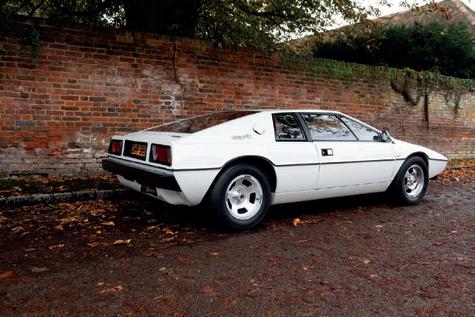



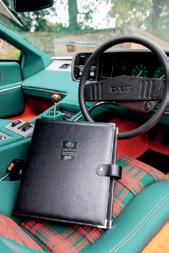







The freedom of life on the open road in a classic rally can change your life completely

LOOKING THROUGH SOME OF the incredible pictures after the finish of the ninth Peking to Paris Motor Challenge back in June, I was reminded of when I did the first one back in 1997 – although technically speaking it was the second, since Prince Scipione Borghese won the inaugural one in 1907.
In Magneto issue 22 I wrote about how I came to do the P2P with my friend Etienne, but I didn’t go into any detail of how it went. The issue is that it is virtually impossible to write in 900 words about seven weeks, 11,000 miles and ten countries shoulder-toshoulder in a 1927 Mercedes-Benz 630K. There are plenty of books out there to tell you just some of the stories from each event, but I thought I would relate what changes doing the rally might make to your life.
To start with, if you are ever considering taking part in a big rally such as this, enter straight away. It will be one of the best things you ever do – and if you have the funds you’ll certainly do another. There are rallies all over the world and in all sorts of conditions – from super-smart and elegant, driving on Tarmac roads and staying in five-star hotels, to adventure rallies sleeping in tents and repairing your car in the middle of nowhere.
If you are the principle entrant, your co-driver must be someone who can drive, and work on, the vehicle you are taking. They must also have a sense of humour, because there will be times when you’ll need it.
We were in the mountains in Nepal. We’d stopped for a break, and I asked Etienne if he wanted lunch. “Oh yes,” he said. “I’m starving.” So out of my pockets I produced hard-boiled eggs, sandwiches, fruit, croissants and drinks, and placed it all on a white napkin from the hotel. This was funny enough, but then I asked if he wanted salt and pepper – and I produced a shaker, also from the hotel. We still tell that story and laugh.
Unless you take a spouse – or a very
BELOW Seven weeks, 11,000 miles and ten countries in a 1927 Mercedes-Benz 630K. What a ride...

dear friend – with whom you have done adventurous things in the past, I think it’s better to take someone you know only slightly (as was our situation at the start), because if you fall out you then don’t lose a friend. On the other hand, if you get on and complete the adventure, you will have made a friend for life. Falling out with your team-mate is a very real possibility; once during the P2P, we rounded a corner to find all four members of a two-car Ford Coupe outfit engaged in full fisticuffs on the ground; it looked like a scene from a cowboy movie. Meanwhile, some other teams spent all day in silence because they ended up hating the sight of each other.
Etienne was fortunate because I kept fixing the car and making him laugh. But it wasn’t always possible to laugh, due to accidents and incidents. One night coming into Qatar on dark, rural roads, the German father and son Josef and Rene Feit tragically lost their lives in a crash. I had been swimming with Rene only the night before, and he was a charming 17-year-old having an adventure with his dad.
After the incident Etienne and I
drove quietly for about two days, merely giving and receiving instructions, sunglasses on, not daring to speak in case the grief flooded out. But somehow, because you can’t stop, you have to keep going; there was nowhere else for us to go but forward. Eventually the pressure released, we had a riotous evening with the other German teams and we all allowed ourselves permission to laugh again. For the first week of a major rally your mind is occupied with the myriad jobs and things that constantly fill your life. Then gradually your peripheral vision of all that stuff draws in –because if you forgot to do something before you left, there is nothing you can do about it now anyway. You end up with just three things to think about:
‘Some teams spent all day in silence because they ended up hating the sight of each other’
are we healthy, is the car working well, and are we going in the right direction? These three things can be applied to everyday life as well. If you aren’t healthy, you can’t work. If the business is not working efficiently, everything is difficult. And is the business going where you want it to, or has it diverted up a siding and is not moving forward? If just one of those things is wrong, you aren’t going to finish either the rally or the grand plan you are aiming for.
After the rally a lot of us had trouble getting back into the real world, in a similar way to military personnel coming home from active service. We didn’t want to be stuck in an office being told: “Don’t do that. Do this and conform.” We had experienced nonconformity in a big way, and for some of us it changed our lives completely. Those people who could do so entered more rallies. As for me, I had plenty of adventures running Mr Ecclestone’s car collection, so I simply got my head down and worked. Keep being part of the machinery. Former Ecclestone Collection manager Robert now runs Curated Vehicle Management. See www.c-v-m.co.uk.

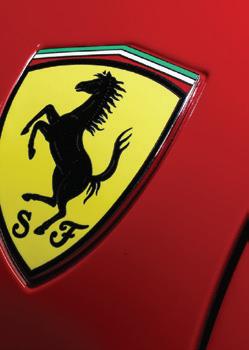

Restomods, phantom cars and missing links – the ultimate could-have-beens and should-have-beens

THE TERM ‘RESTOMOD’ HAS appeared fairly recently. Internet sources will claim that the roots of restomods (a mixture of ‘restoration’ and ‘modified’) come from the 1980s trend for improving American muscle cars. But to my mind it is much more recent than that. Over the past ten years, extreme high-performance road machines have become so sophisticated that their capabilities have more to do with the mastery of computer code rather than engineering finesse. The results are often startling but soulless –particularly those that combine electric with petrol-fuelled power.
Appreciation of analogue rather than digital control is part of a longing to feel that one is in charge of the performance of a car. The objective of a restomod is to improve the driving experience of a classic, and possibly to improve the look of the vehicle as well. Porsches modified by Singer Vehicle Design in California have followed a fairly traditional route to their appearance: slightly lower ride height, marginally wider wheelarches and wider rims. Often the rear wheels are a little too wide, with the tyre sidewalls tending to be broader than the body. Never a good look.
Singer’s founder Rob Dickinson, previously lead singer of the band Catherine Wheel, bravely showed his personal 1969 Porsche 911 at the 2009 Pebble Beach Concours d’Elegance, the home of the ‘authentic car’. His ideas for a modified Porsche were just what jaded new-car buyers wanted.
Meanwhile, Rod Emory, grandson of renowned hot rodder Neil Emory, started out restoring 356s but then moved on to what I consider to be brilliantly reimagined developments of that model – cars Porsche might have built, but didn’t. Here was a new direction for the restoration business: ‘phantom’, or ‘ghost’, cars – those that might have been.
Indian collector and multiple concours award winner Viveck
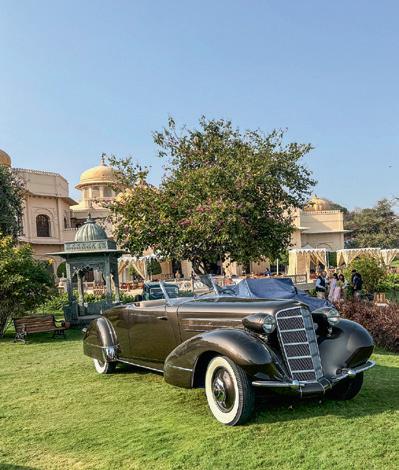
Goenka – owner of Mumbai-based Sara Auto Restorations, run by his nephew Allan Almeida – had, a few years ago, come across an illustration credited to Fleetwood designer John Hampshire. It was probably drawn in 1934 for the 1935 season.
Both Goenka and Almeida were captivated by this body design for a Fleetwood Two-Passenger Roadster with the code of Chassis Style 5602 for the V8, 5702 for the V12 and 5802 for the V16. The after-effects of the Great Depression, the high prices and, despite Fleetwood’s claims, the very long waiting times for a Fleetwoodbodied Cadillac had meant that none of these cars was ever built. With the valuable input of HH Manvendra Singh Barwani, who advised on styling and allowed use of his bodyshop, Goenka and Almeida decided to imagine and then build a Maharaja’s Speedster based on a Cadillac V12
chassis. The result is magnificent. There is no doubt that those who are involved in restomodding need to have both good taste and great skill – attributes that are not always in evidence. Attempts to lower the roofs of a beautiful Lancia B20 and various Bentleys have not always worked. Fitting modern headlights with their very different appearance can ruin a car, as can oversize-diameter modern wheels with ultra-low-profile tyres, which can’t help looking out of place.
The other issue with the choice of car is that it can cost just as much to change the appearance of a relatively low-value donor, upgrade the brakes, retrim the interior and repaint the body, as it would to make the same changes on a more expensive vehicle. The halfmillion-pound Ford Escort makes less sense than a similarly priced 356 Porsche or ‘step-nose’ Alfa Romeo.
I have recently been asked to
BELOW Magnificent Maharaja’s Speedster based on a Cadillac V12 chassis recreates Fleetwood’s ‘one that got away’.
imagine what a considered, but never built, 1960s mid-engine sports car might have been like. The client has asked me to put myself back 60 years – even suggesting that I should wear a period striped, sleeveless, knitted tank-top while working on the project. It has been absolutely fascinating, because I have had to delve into the cultural and engineering history of the company.
More recently there has become apparent a certain desperation to give the electric car an historic validation within the heritage of an automotive brand. Here the problem is that the new electric versions are huge when parked alongside their grandparents – giants dressed in classic clothing.
And very recently, certain highperformance sports car manufacturers have searched through the old ‘dressing-up box’ of either their own past products, or even the past models of other companies, to produce a reimagining, tribute or ‘homage’ machine. Not because they would like to refer back to a very successful model and celebrate its place in history, but simply to make money. This whole area of design suggests that the industry has run out of fresh ideas.
There was a hope that the new technical layout of electric cars would produce a fresh design language. However, other than a rush towards ever more complex and aggressive detailing, and horizontal tail-lights, there is little that is new. But I think a lack of inspired thinking is more likely to be the result of the spiralling cost of development of new cars, along with the uncertainty of what the future of personal transport might be. Financial insecurity often breeds conservatism when those who hold the purse strings dictate the ongoing direction of a company. Hopefully we have not reached a plateau in design development.
Peter is a past chief designer for Lotus, McLaren, MG-Rover, Mahindra and more. He’s now a consultant designer.
+400% additional tyre-bearing surface from these specially designed product lines of cushions to avoid, seriously, the tyre flat spot phenomenon.


since 2009 tyre cushion sets info@altairego.it www.altairego.it

+400% additional tyre-bearing surface from these specially designed product lines of cushions to avoid, seriously, the tyre flat spot phenomenon.
ALTairEGO cushions sets offer a tyre-bearing surface +400% greater than when the car is parked on the ground, thus avoiding the tyre flat spot phenomenon.
3 product lines, including 21 models in respect to your car’s specific kerb weight category, between 500 kg / 1100 lbs and up to 4000 kg / 8800 lbs.

The NASCAR Hall of Famer and legendary crew chief on why he’s bringing back the iconic International Race of Champions, or IROC, as an exciting new Historic series
Why is IROC so special to you?
Well, you know, I started my career at IROC, and that was a big transition for me, going from local short-track amateur racer to getting a shot at professional racing. I went to that organisation as a chassis specialist, hoping to talk my way into driving a Roger Penske IndyCar. That didn’t happen – but I had no idea the lessons that I was going to get from Roger Penske and Jay Signore, and I was able to work with incredible drivers.
When was this?
I started in December 1983 at IROC, and worked through to February 1989 building from the prototype Generation 3 Camaro on, up until they were about to switch to Dodge. It was an amazing experience for me, and I don’t know that I would be anywhere or have accomplished any of the things I have if it had not been for what I learned at IROC. [Ray went on to become a crew chief, team owner and TV commentator].
IROC sadly ended in 2006. What happened to it?
When IROC went away, it kind of broke my heart, but I understood that the sport was changing, and sponsors were bigger, driver contracts were different. Race series got more busy, so scheduling and all those things just didn’t line up anymore to allow drivers to also take part in IROC.
But now IROC is back!
I’ve always been a huge fan of Historic racing. I love the racing and the history of the sport. [Co-founder] Rob Kauffman is a friend – he’s a big vintage racer and historian, and we thought it would be cool if we could get IROC viable as an Historic series.

Are the old IROC cars still around?
We’ve located about 65 cars worldwide. We started it as an exhibition at Lime Rock Park, and it was incredibly well received. So we said, let’s try to put these cars on track at Laguna Seca, and we had 26 show up [at the 2025 Monterey Motorsports Reunion]. It was the first time in history that all seven generations of IROC cars were together on the racetrack at one time.
What’s so special about IROC?
You talk to some people and say, I’ve got an AJ Foyt IndyCar, or a Dale Earnhardt stock car, or a Derek Bell Le Mans Porsche. But what if you had a car that Foyt drove, Mario Andretti, Bobby Unser, Stuck, Mass, Ickx, Bell all drove, oh, then Earnhardt and Waltrip and Allison drove it – that’s what you have with the IROC cars. There’s so much history in those vehicles.
Which cars were run in IROC?
They ran Porsche RSRs for one year, and then they went to the Camaro, which were production cars. Then we have the Banjo Matthews-era tubeframe cars that ran from 1977 to 1995, which came about when Richard Petty started to drive. He said: “Okay, if you cats are going to run Daytona, you need to get a safer car.” And there are the Firebirds, which are the latest machines. They ran from 1996 to 2006.
Do you have a favourite?
The Generation 2 Camaros from 1977 through 1980 are my favourites, because they’re a tube-frame car, and they were competed by the great drivers such as Fittipaldi. Niki Lauda started an IROC race in one, too. Those F1 guys were head to head: John Watson against Gordon Johncock, Waltrip and guys like that.
Is there a single best car out there?
Zak Brown bought probably the most original IROC machine on the planet, a Generation 2 Camaro. It was used as a practice car, so all the drivers from the 1977, ’78 and ’79 series drove it. And then it won two races, one with Darrell Waltrip, and one with Cale Yarborough – Zak was actually there the day Yarborough ran it.
It was also used as a promotional car for IROC, and on the same day at Sonoma, Paul Newman, James Brolin, Clint Eastwood and Gene Hackman all drove it. The Camaro was put into
‘I don’t know that I would be anywhere if it had not been for what I learned at IROC’
a garage in Massachusetts, where I located it; it had never been restored.
Which cars do you expect to see the most in the revival races?
There are more Firebirds than any other. I think 40 were built, and 34 or 35 of them still exist. There should be almost as many of the Banjo Matthews era of tube-frame cars as there are Firebirds. At the other end, there may be only four original IROC Porsches left in the world.
And what comes next?
We’re going to continue to work on the growth of Historic IROC. On April 26, 2026 we’re at the new Ten Tenths Motor Club here in Charlotte, and then in August we’re back at Laguna Seca on the West Coast. And we’re already on for April and August of ’27. We’d like to do three to four events a year. I don’t think it’s any secret that we want to come to the UK. We’ve talked to several people about doing something at either Goodwood or one of the other events.
And what’s the dream scenario?
My dream is to have somebody with the resources say: “Okay, Ray, let’s start the real IROC again.” I’ve already got a car design. It’s on my Christmas list, so if Santa Claus comes this year, I’m ready to go.

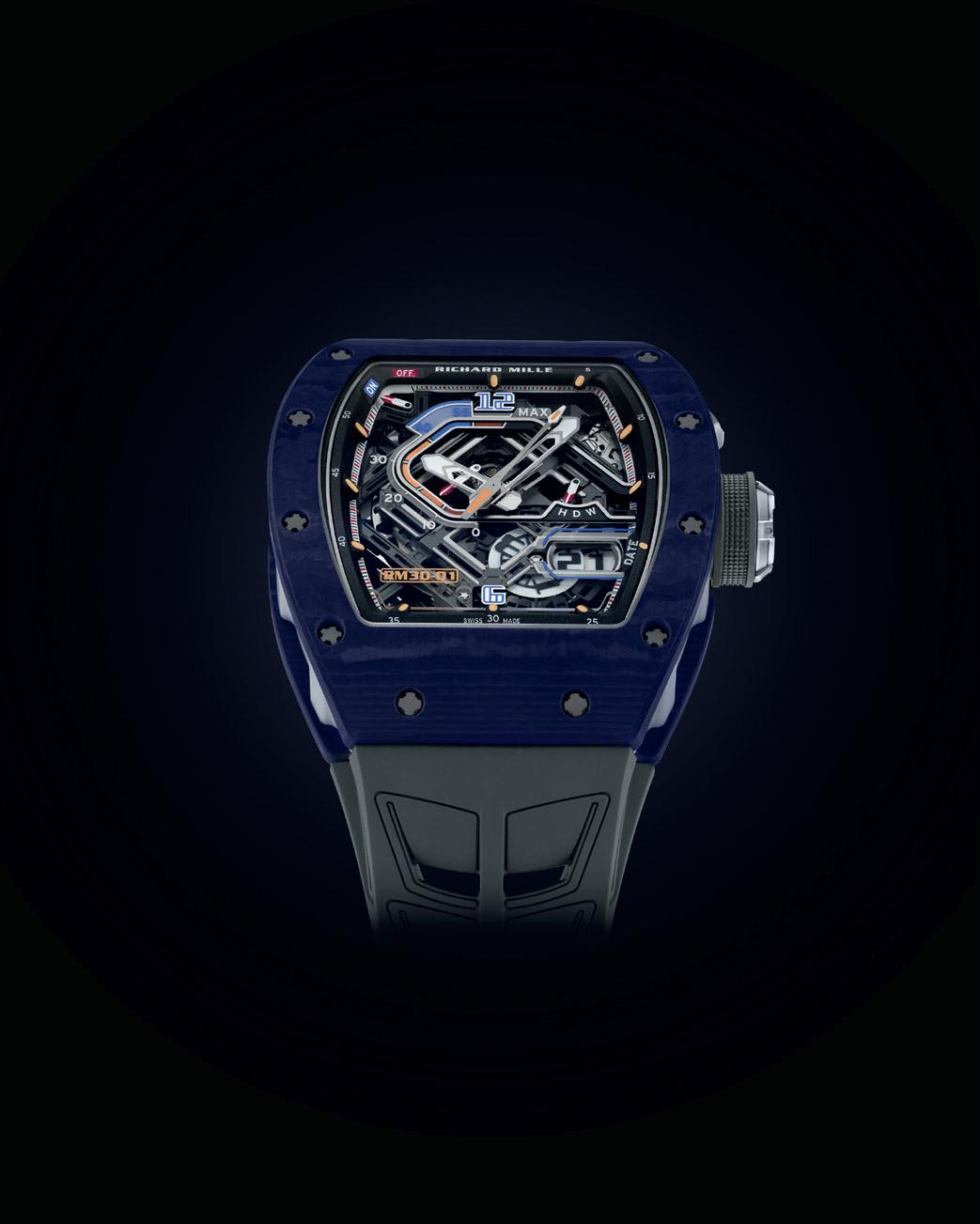
RM 30-01
Skeletonised automatic winding calibre
55-hour power reserve (± 10%)
Baseplate and bridges in grade 5 titanium
Declutchable variable-geometry rotor
Oversize date
Power-reserve indicator and function selector
Case in Dark Blue and White Quartz TPT®